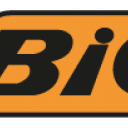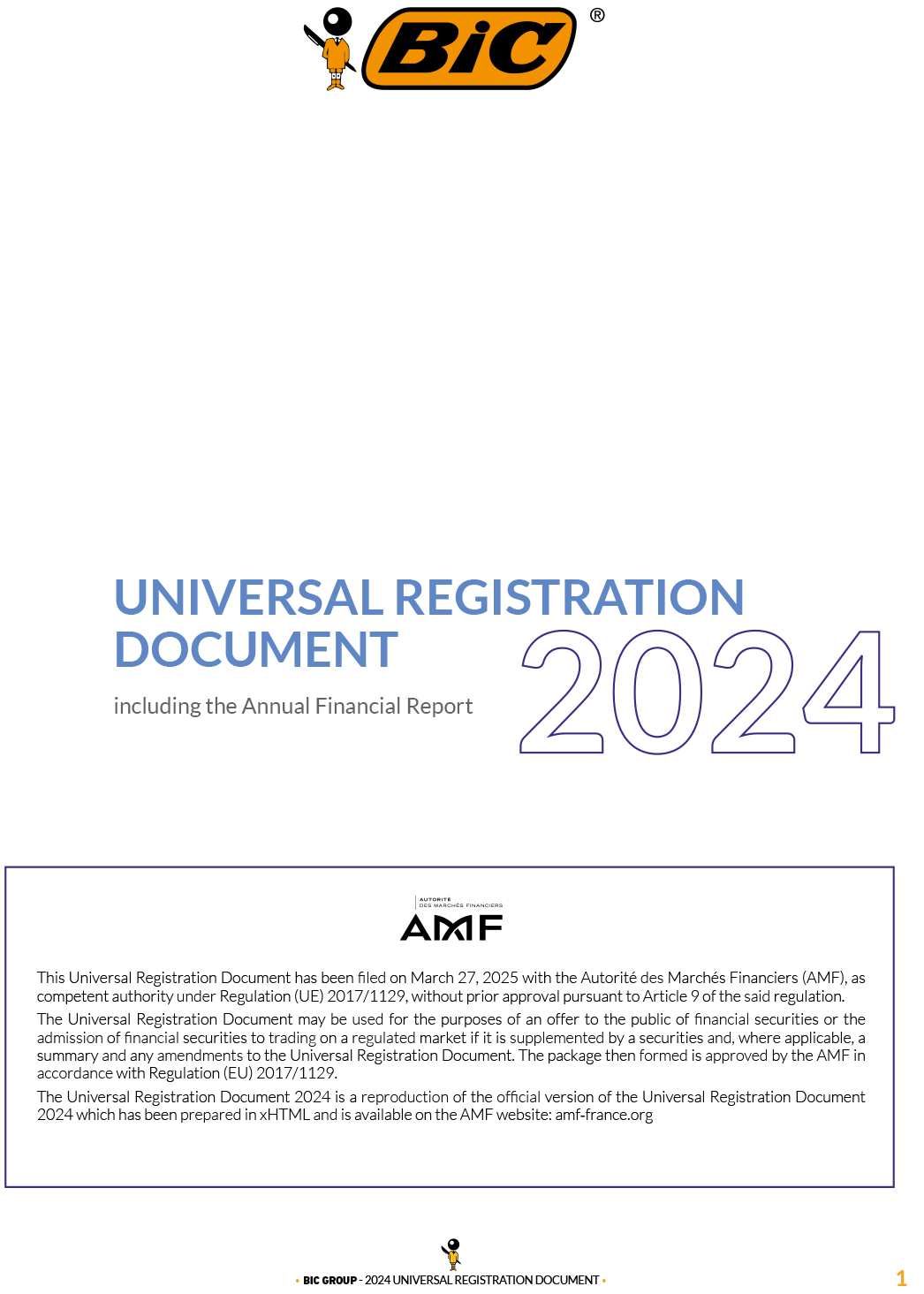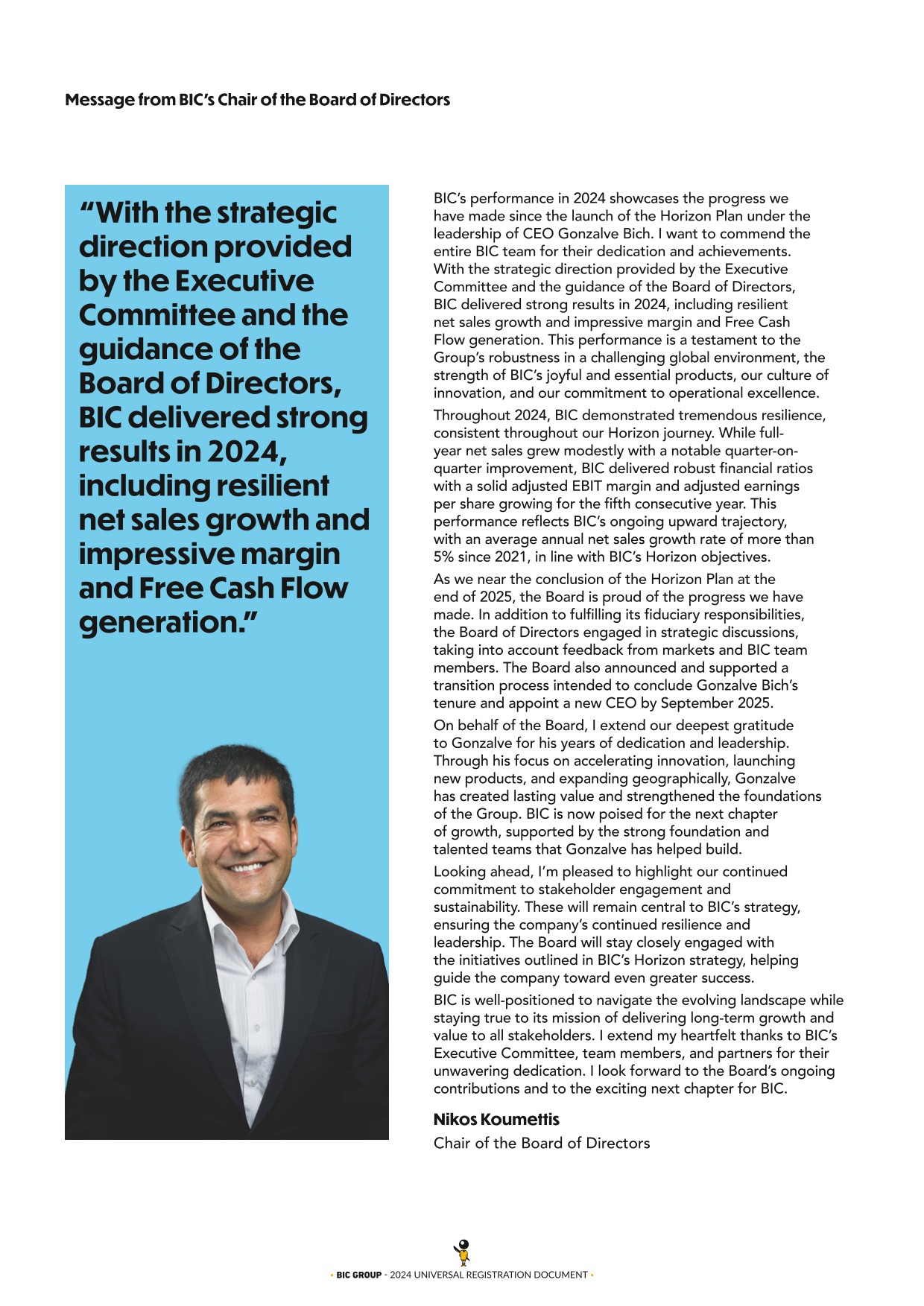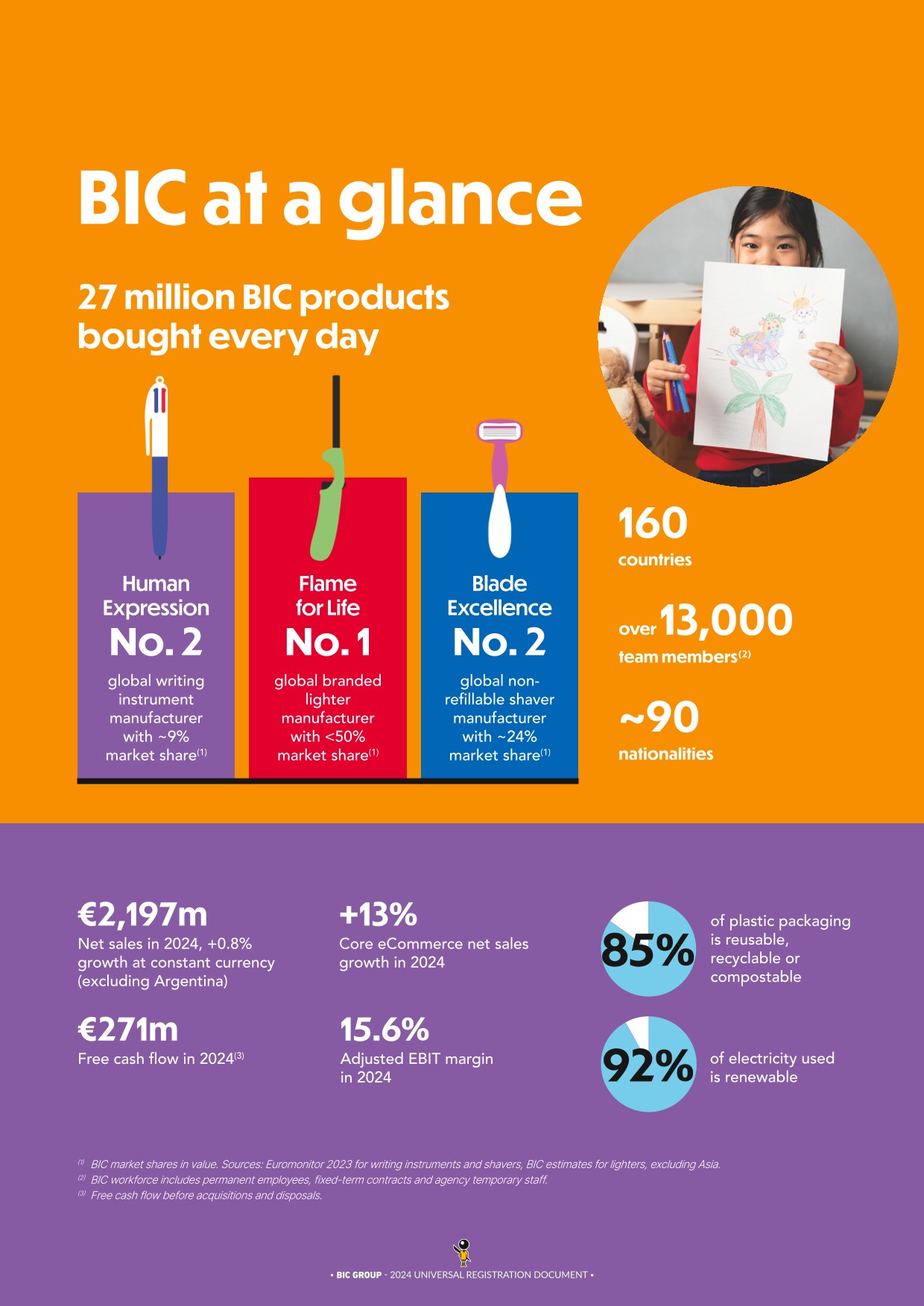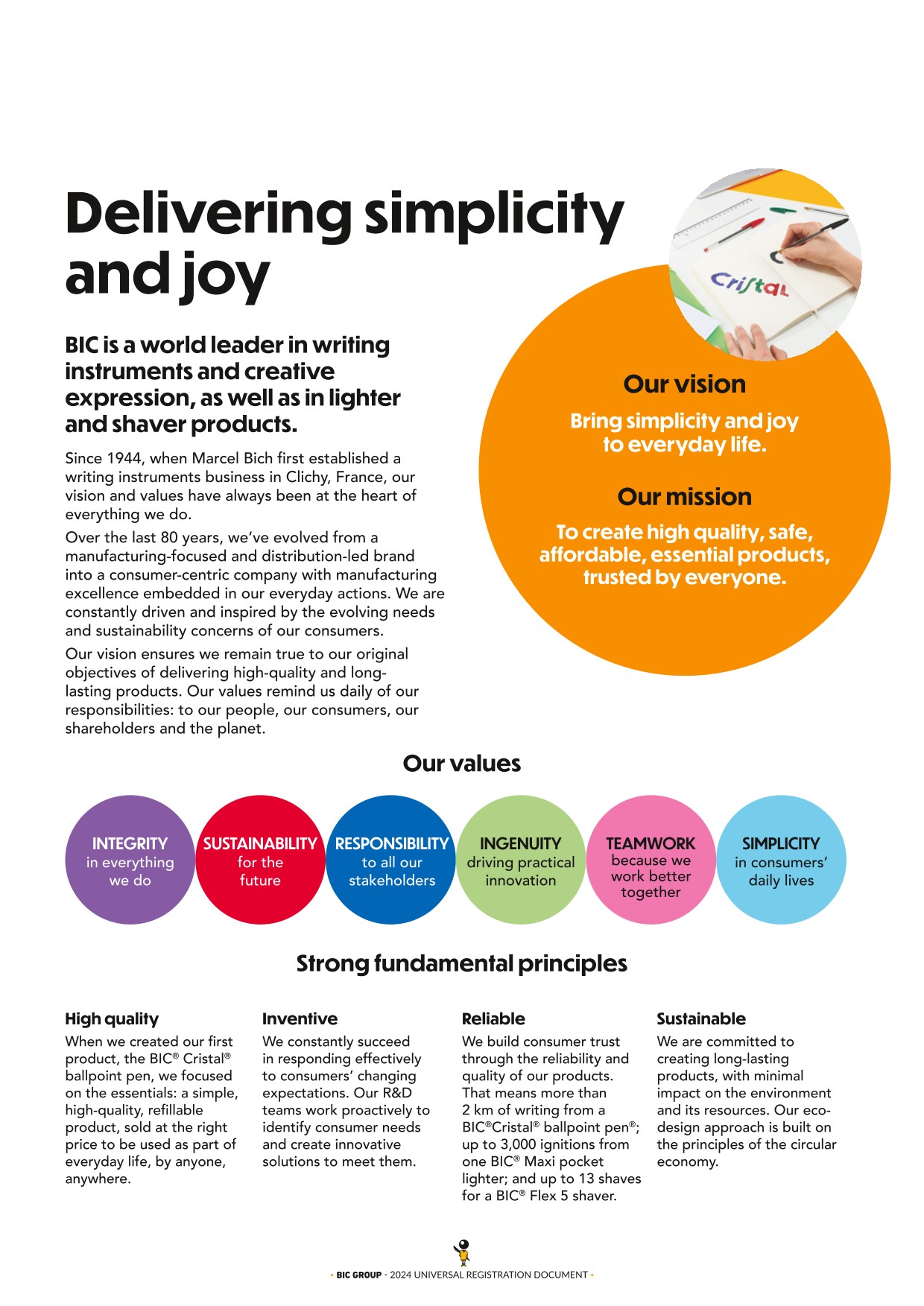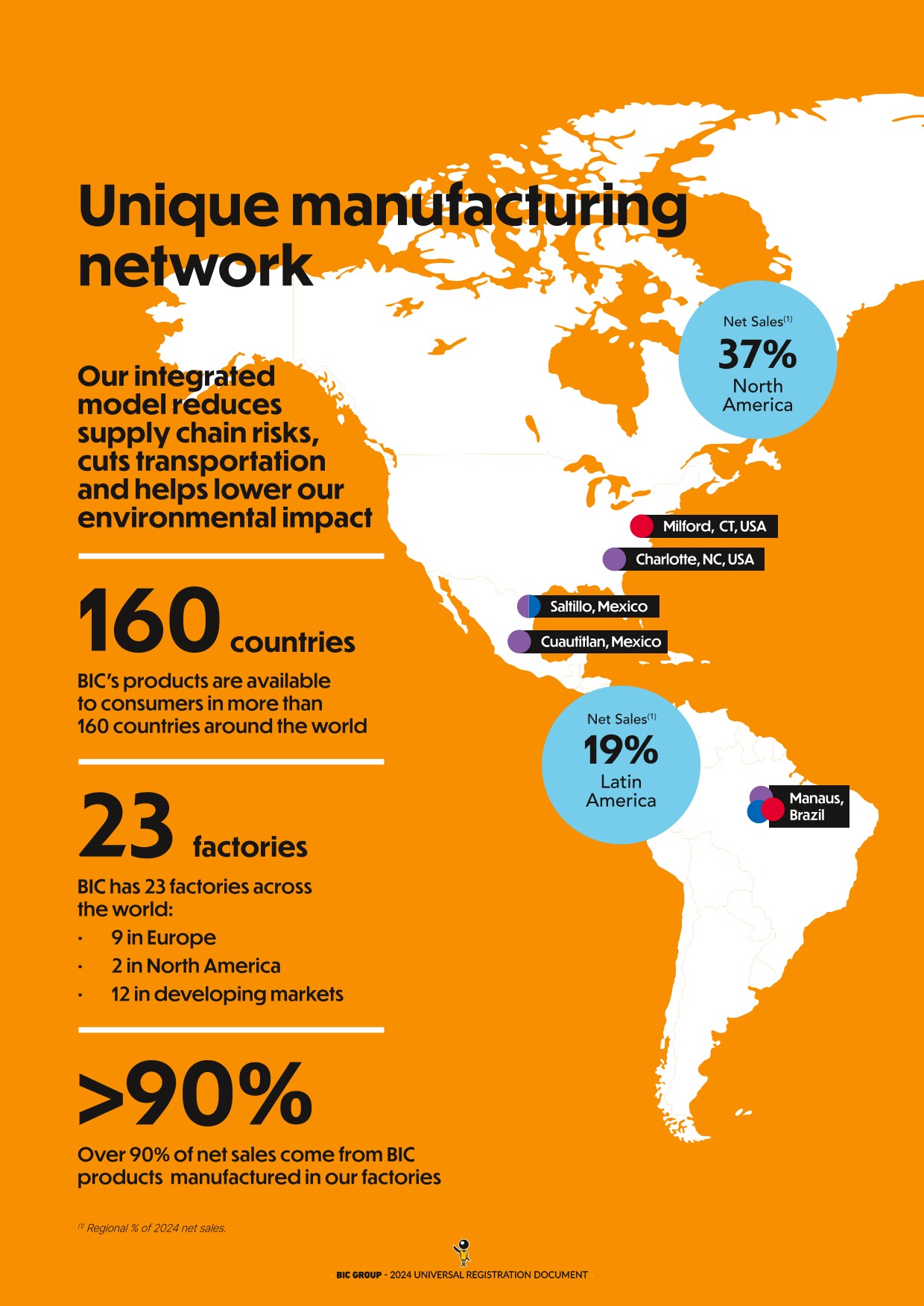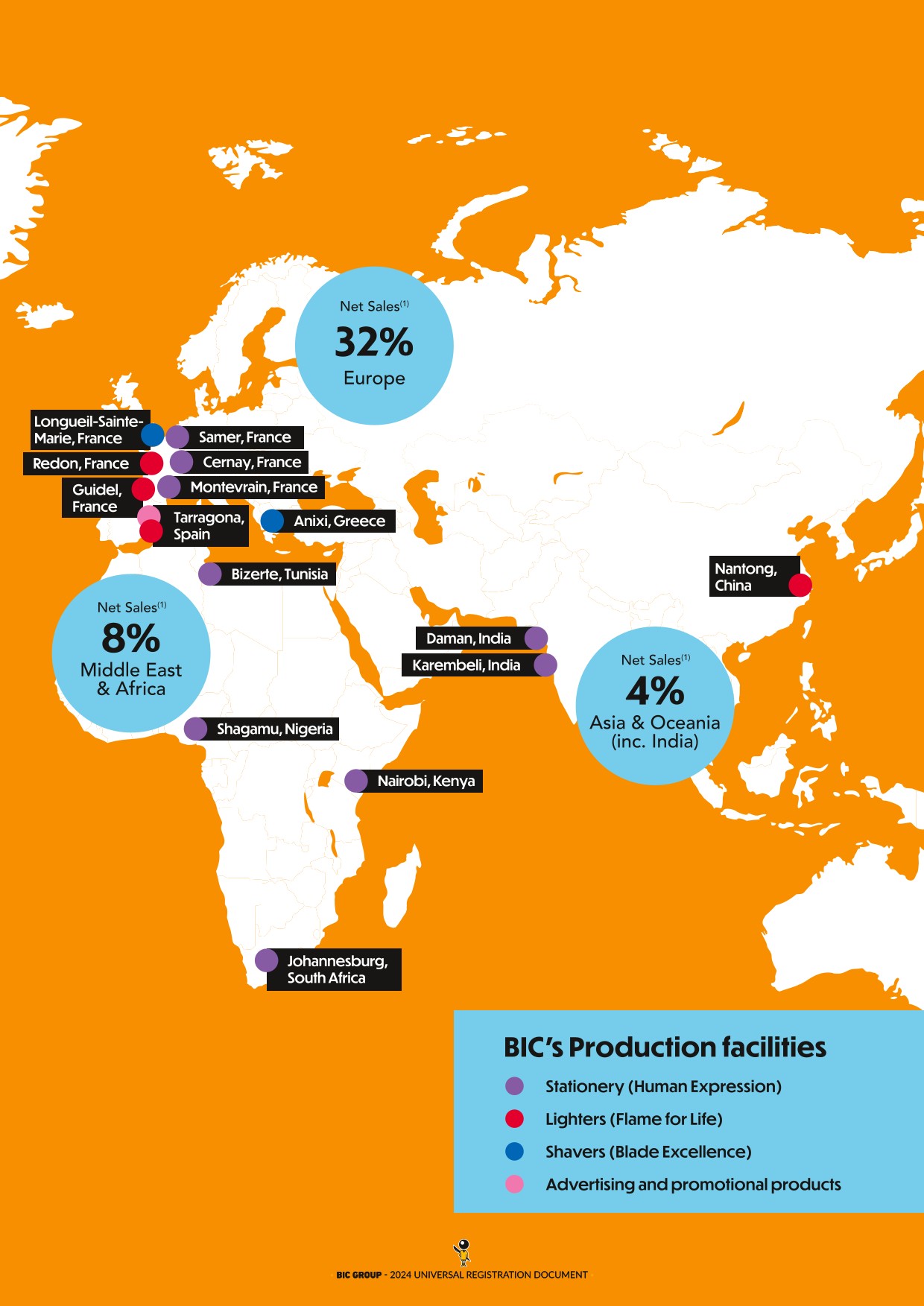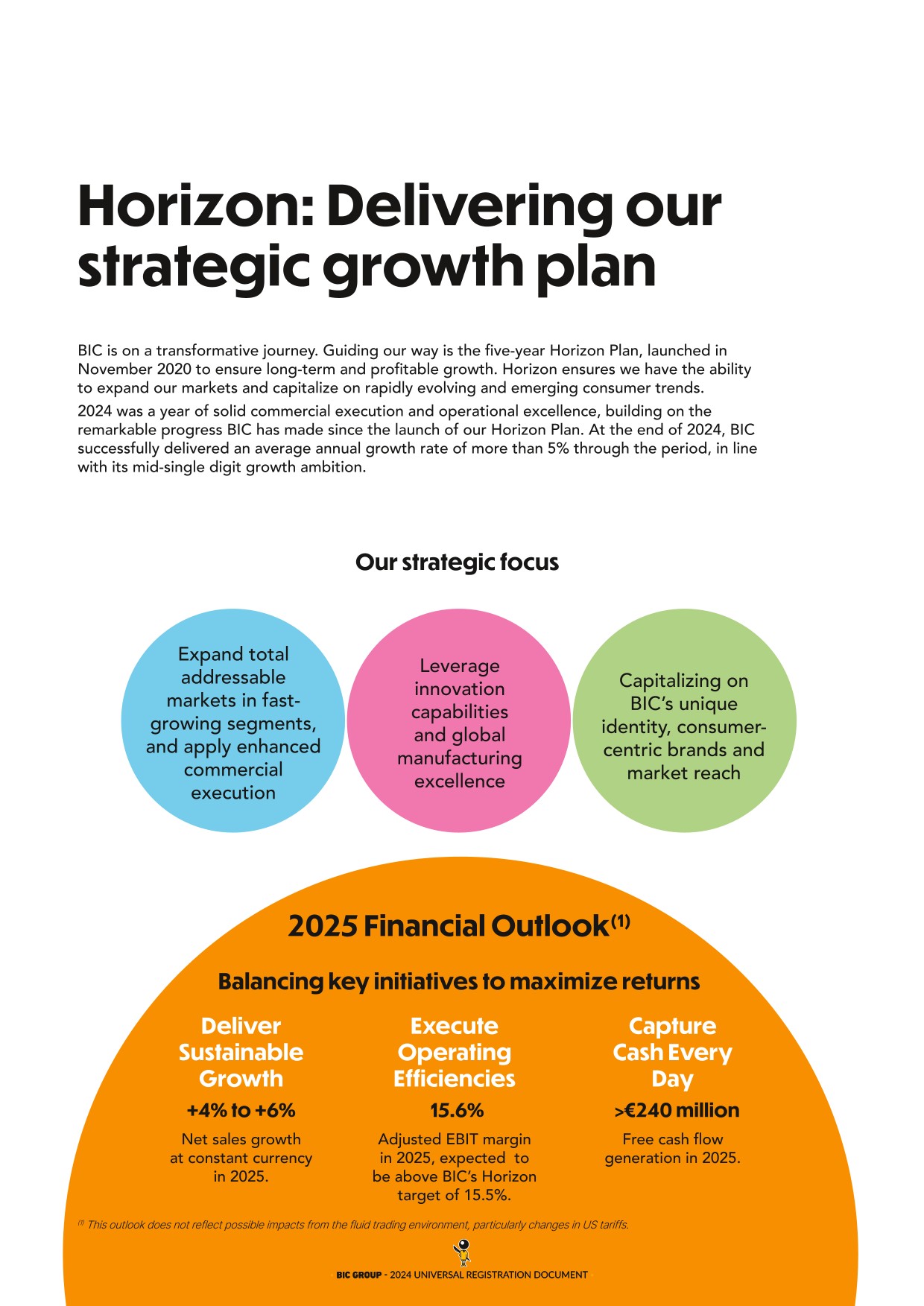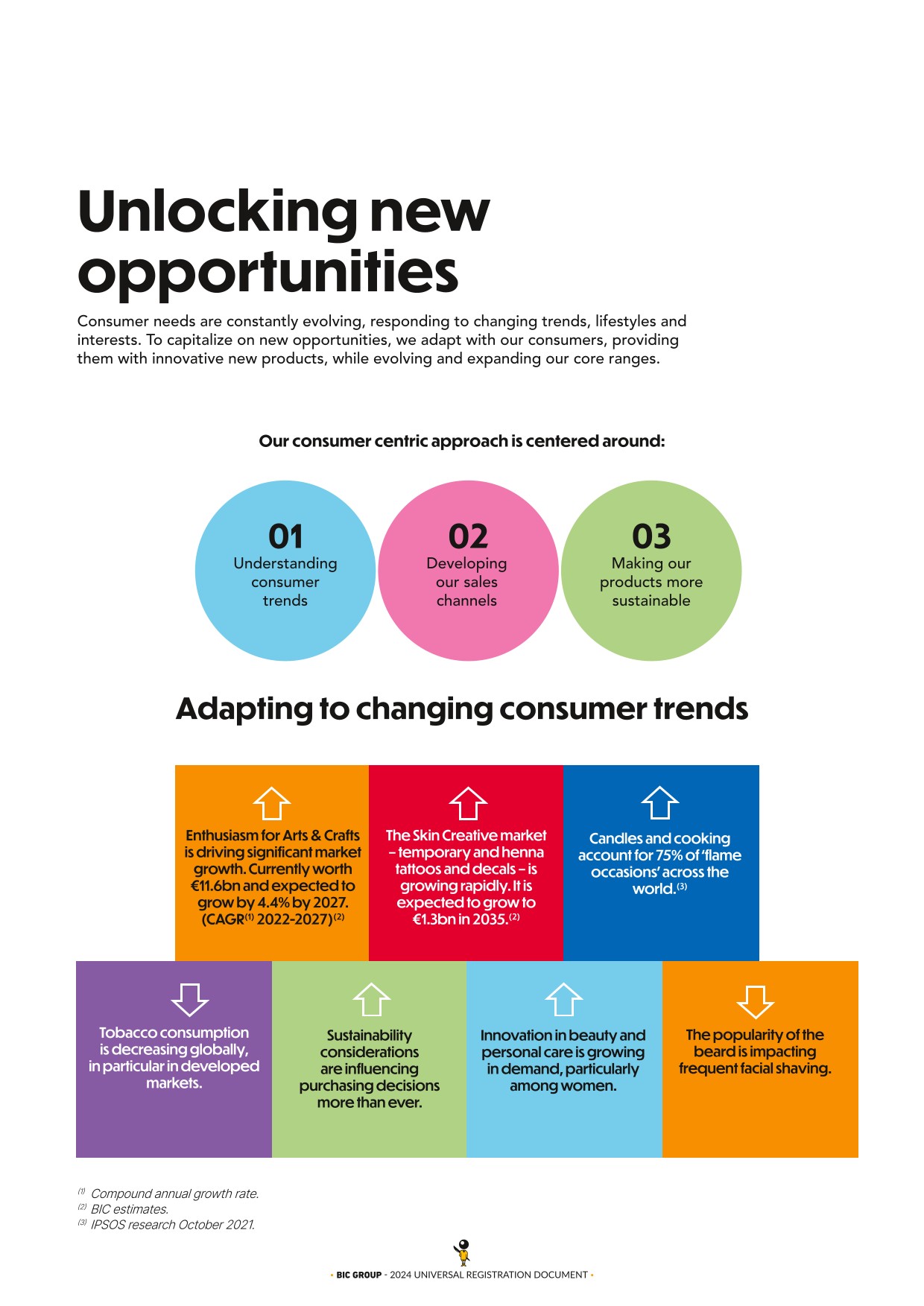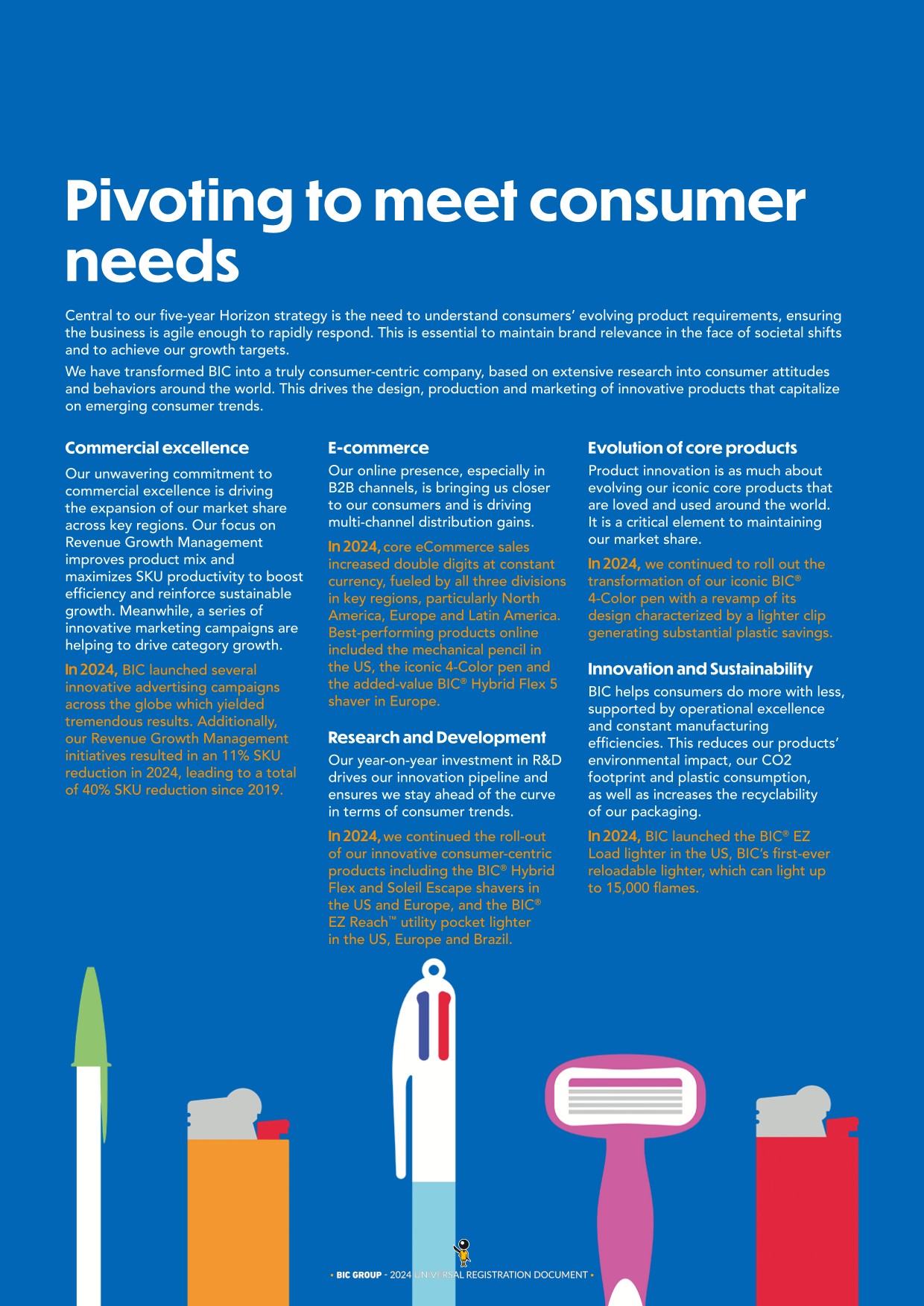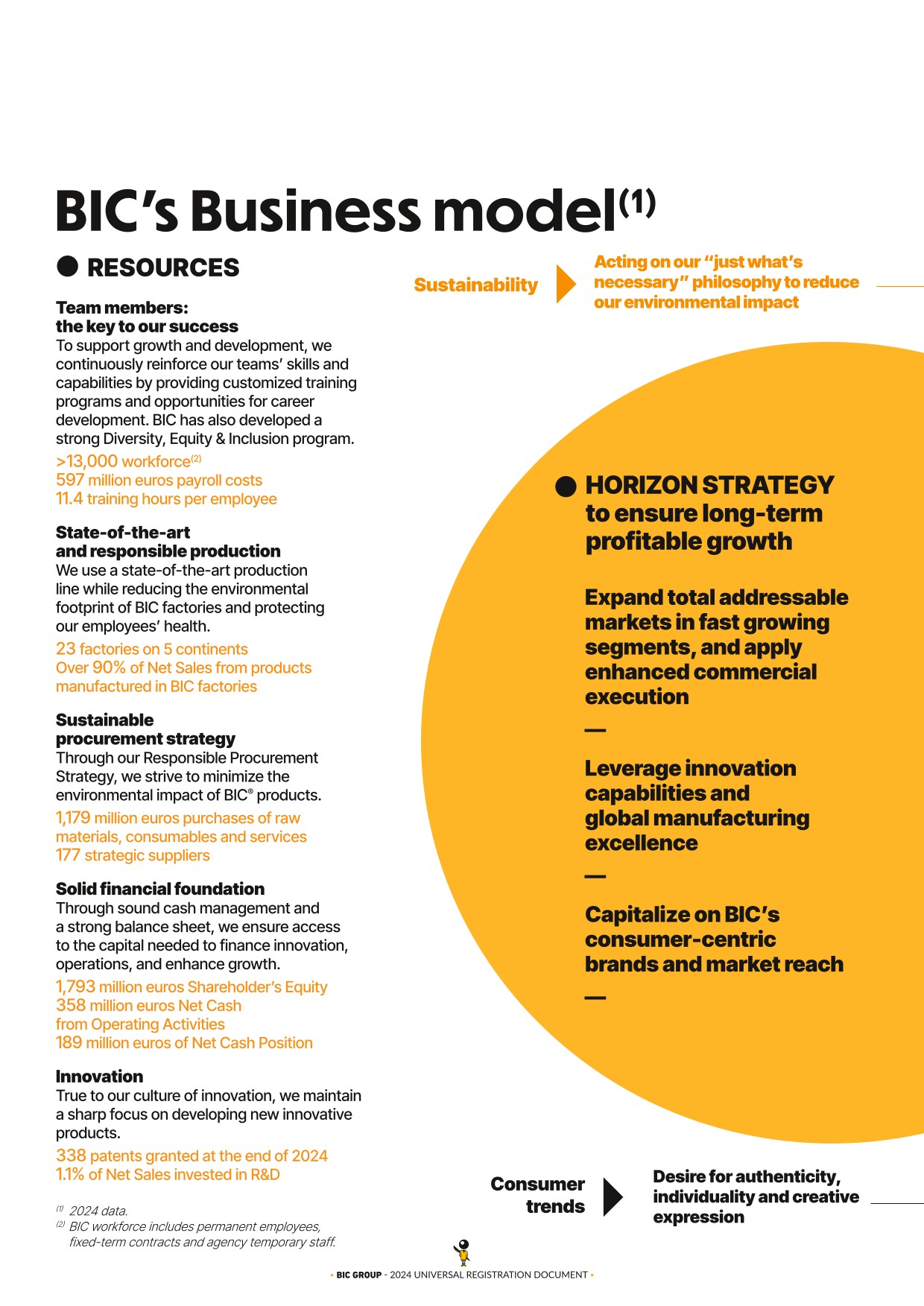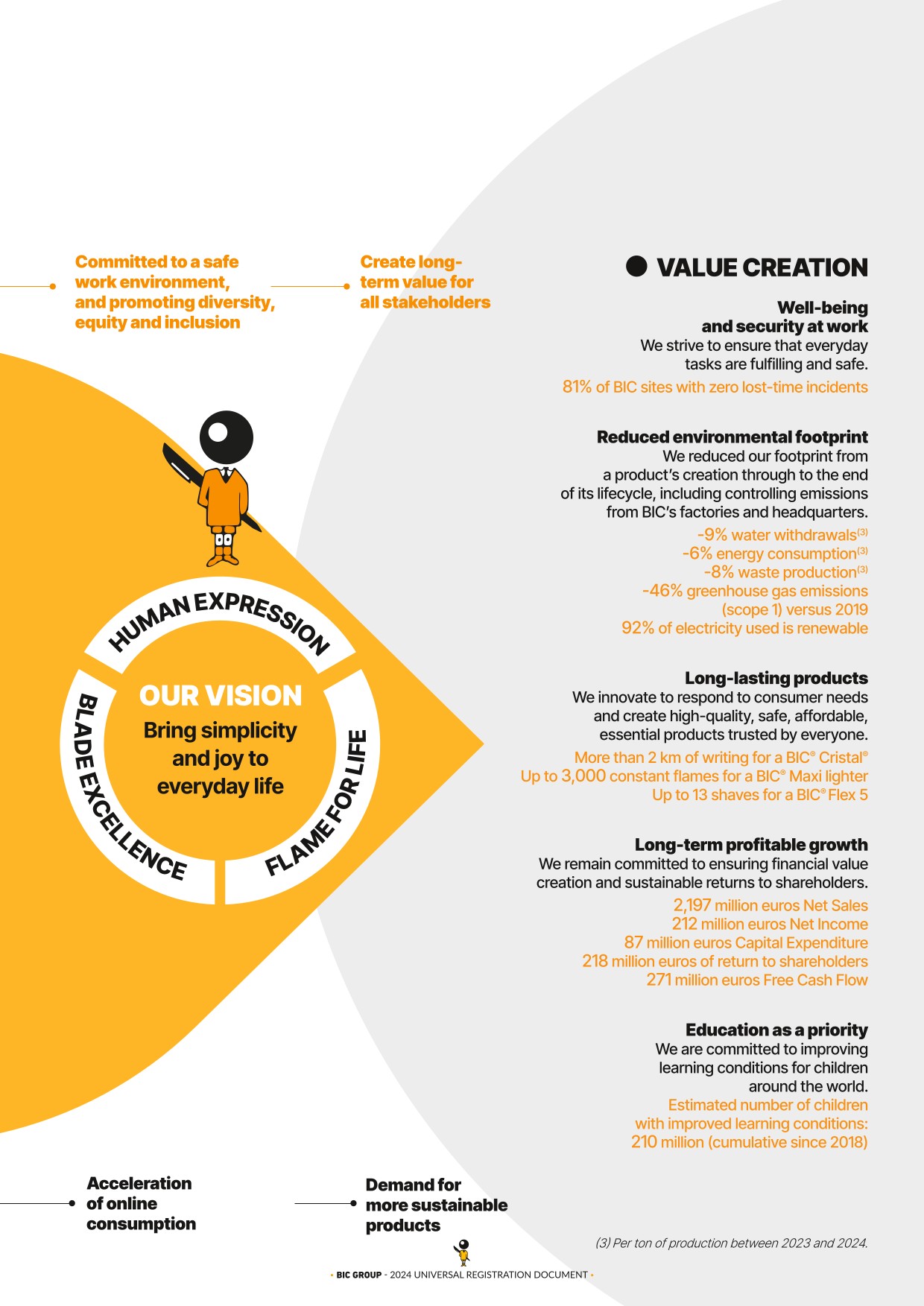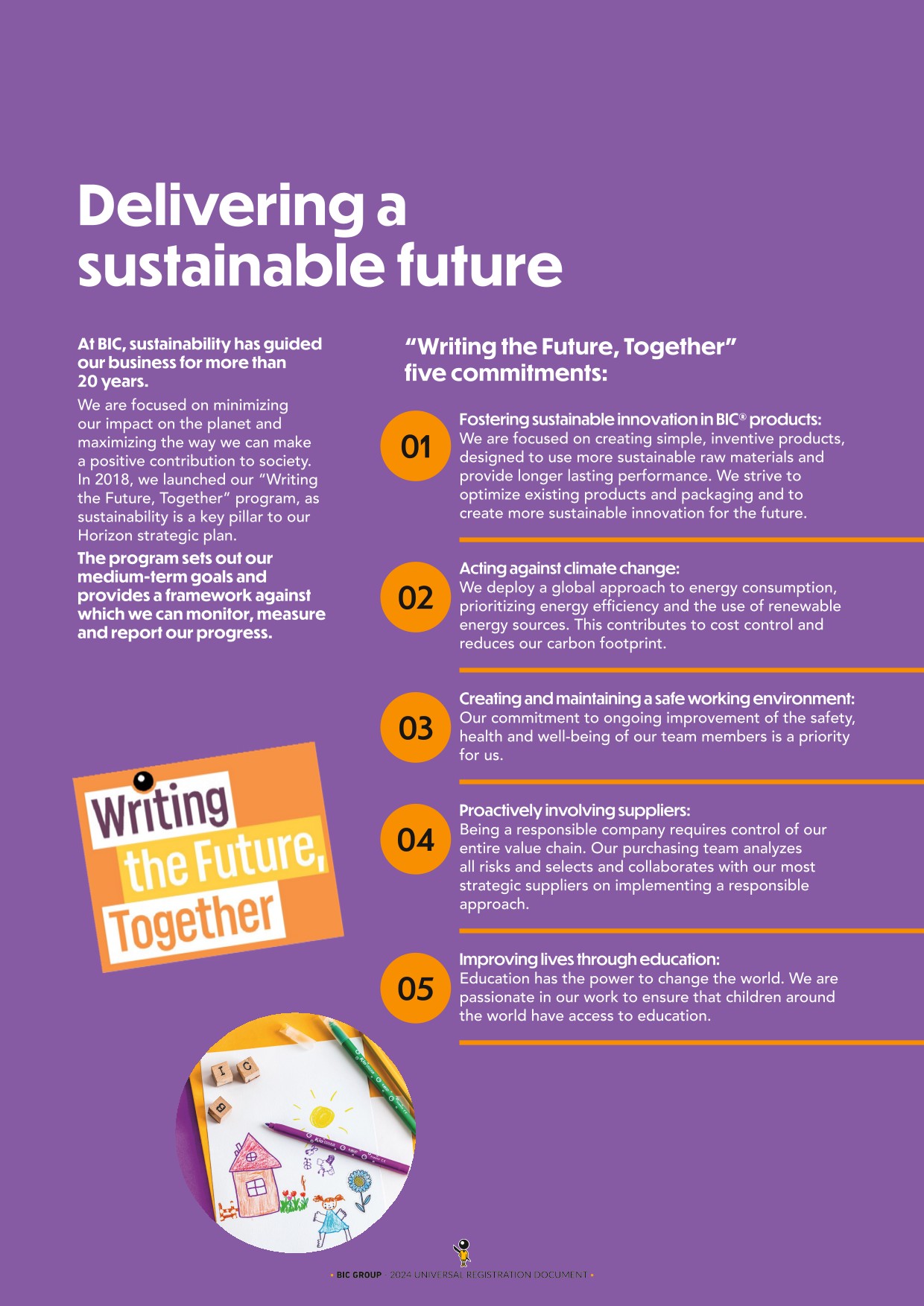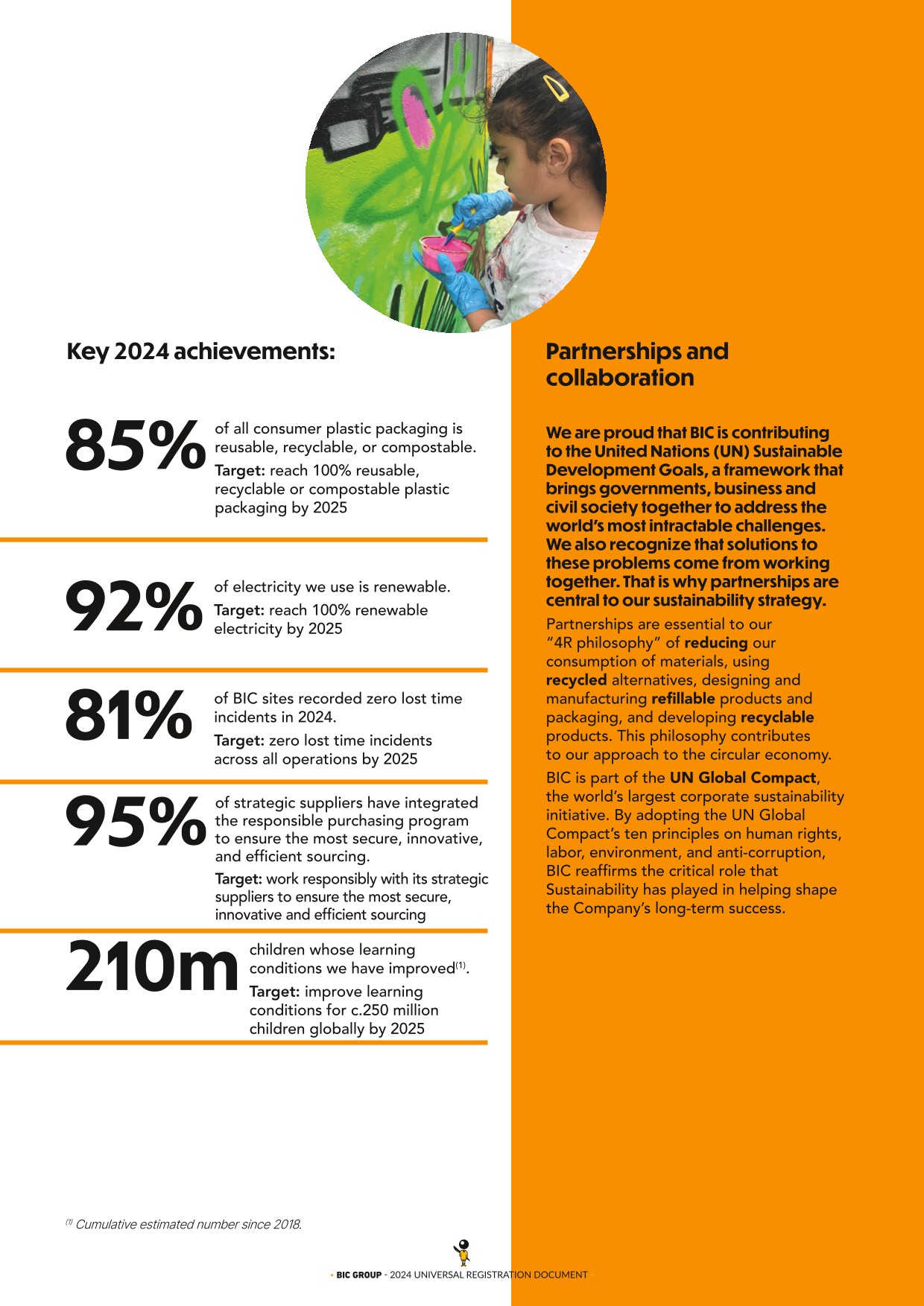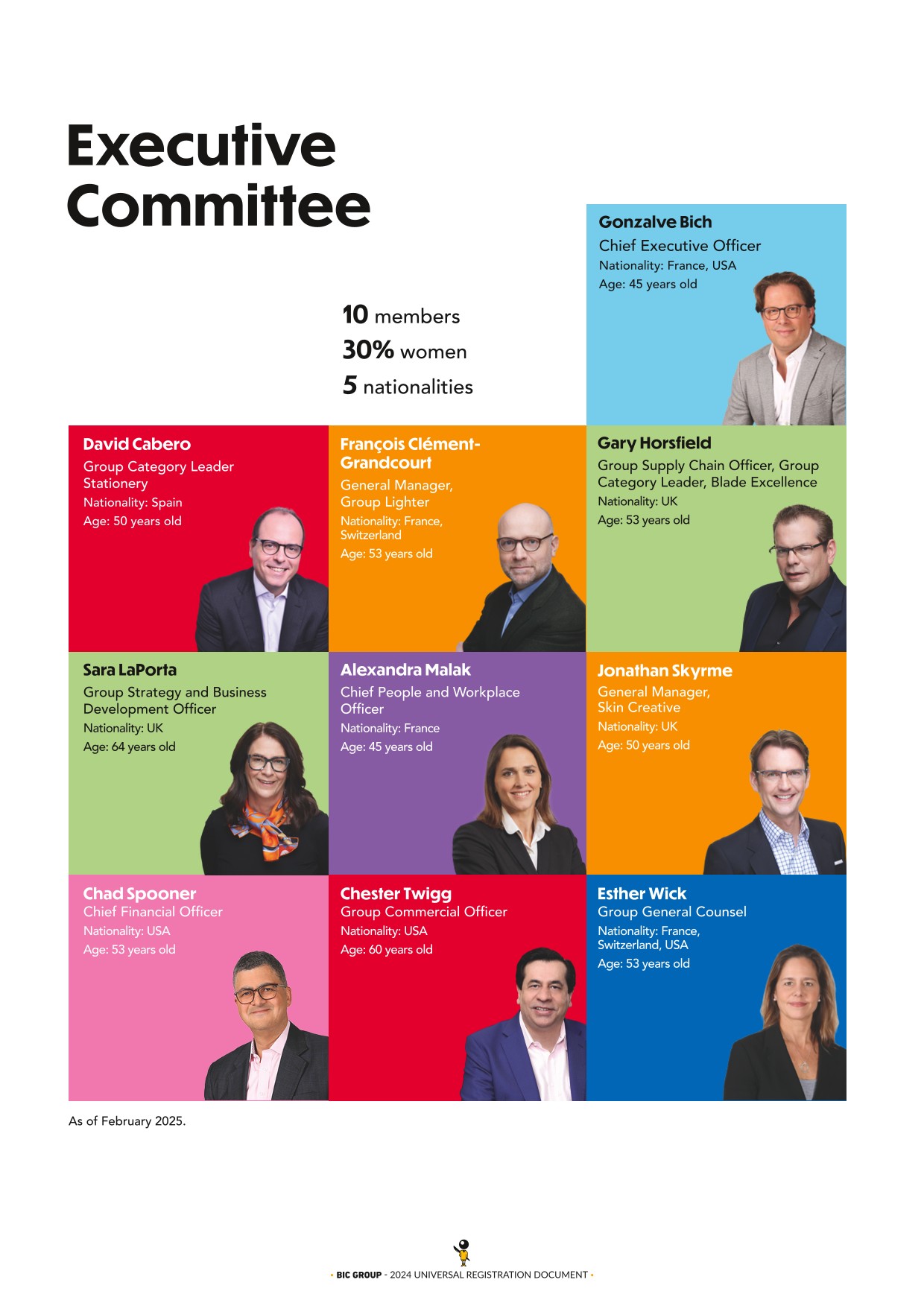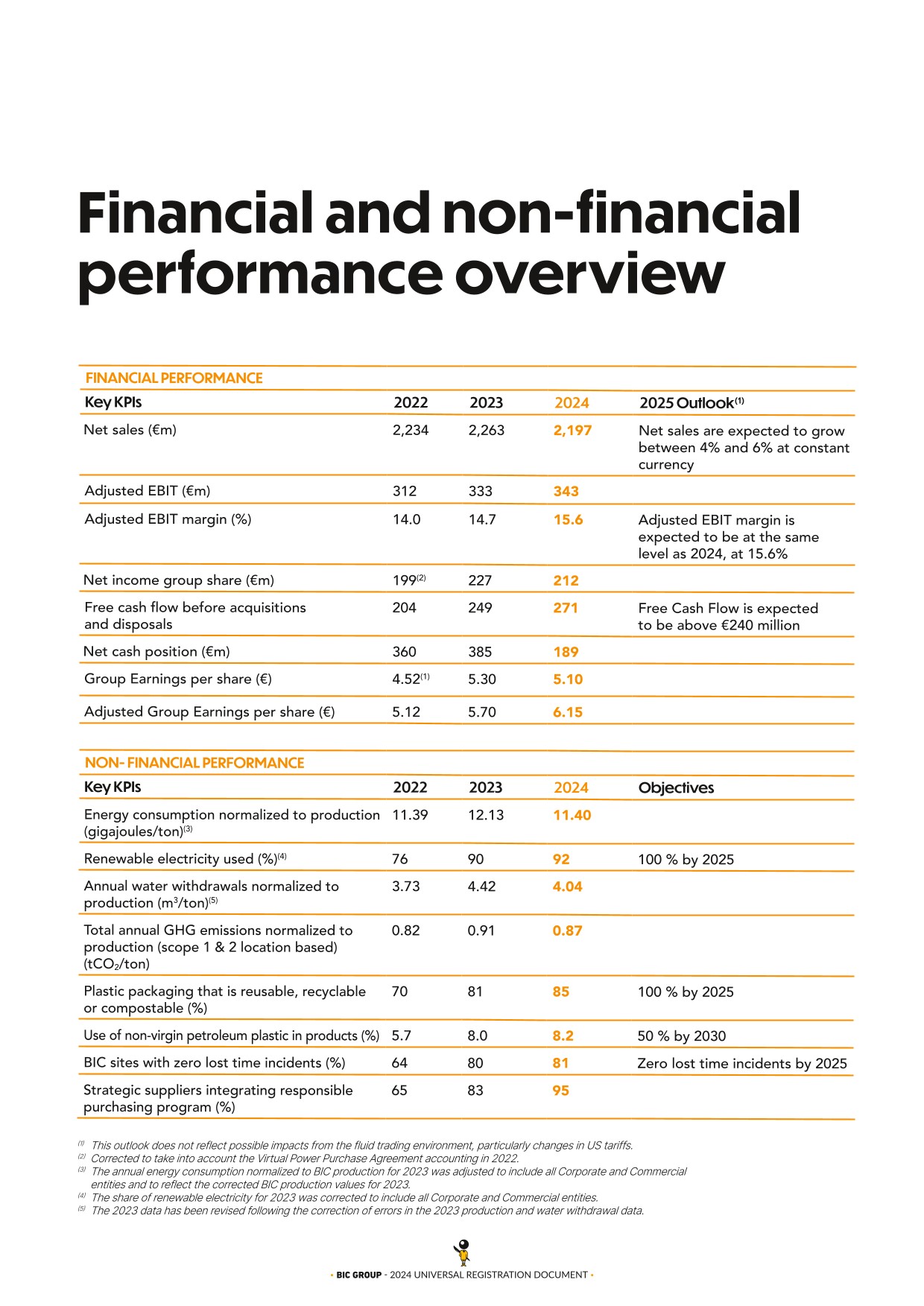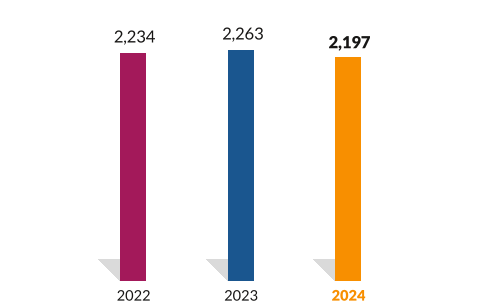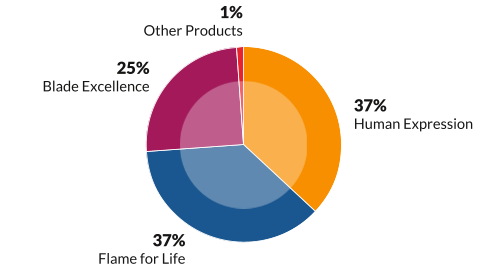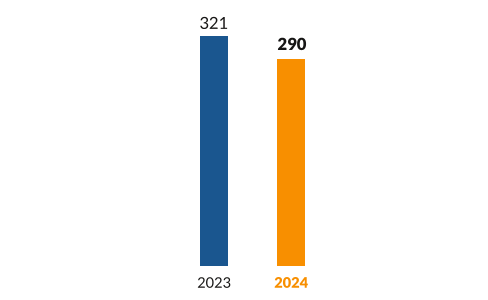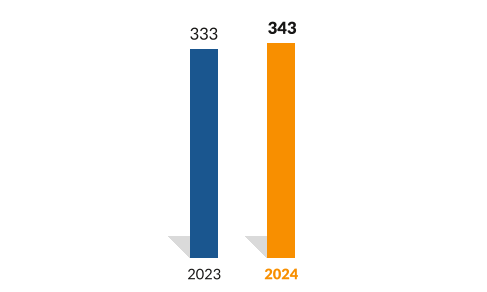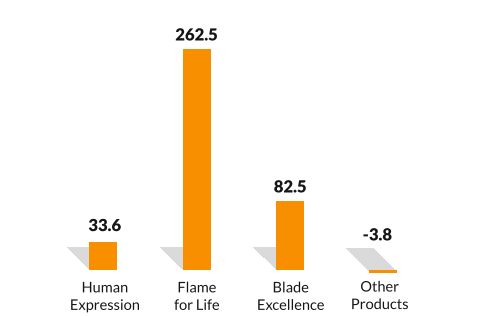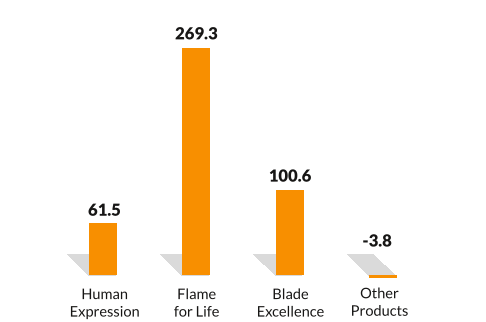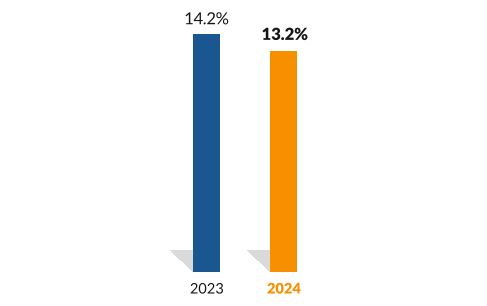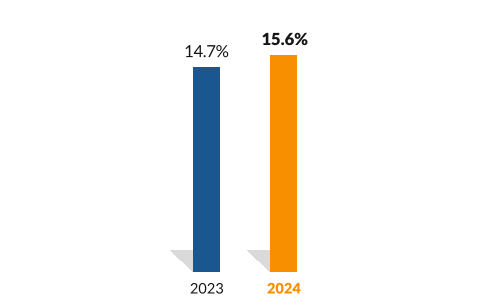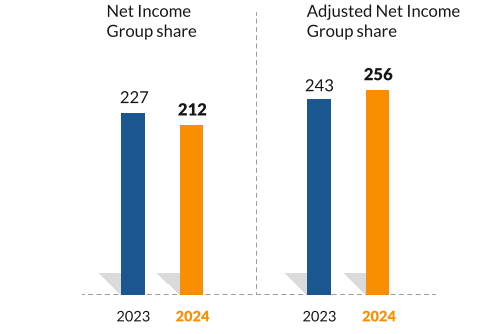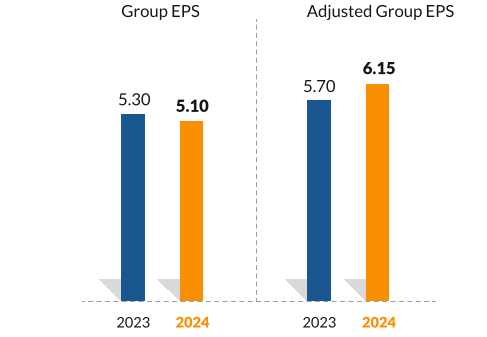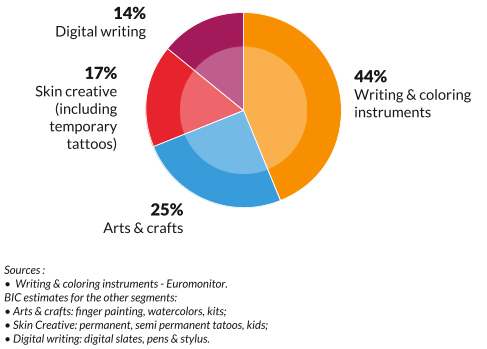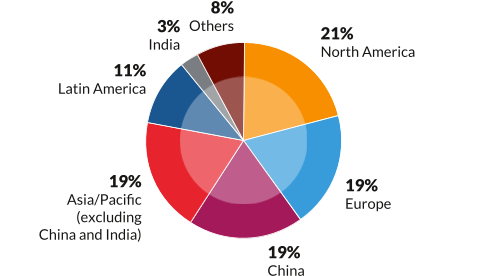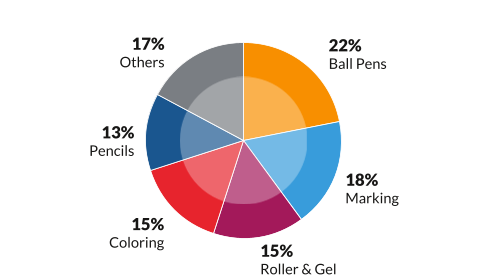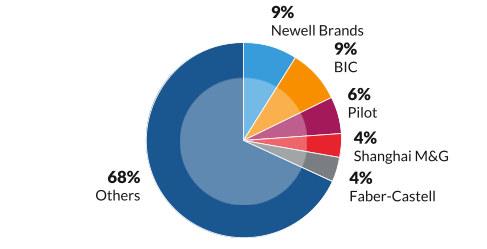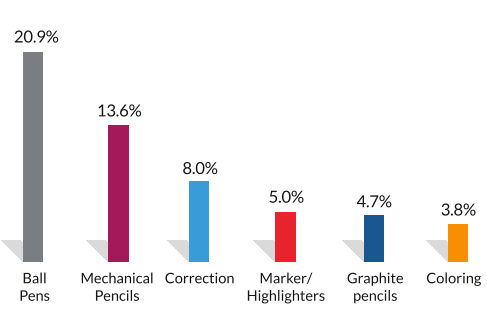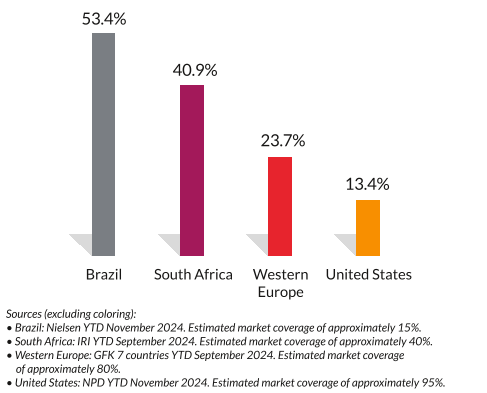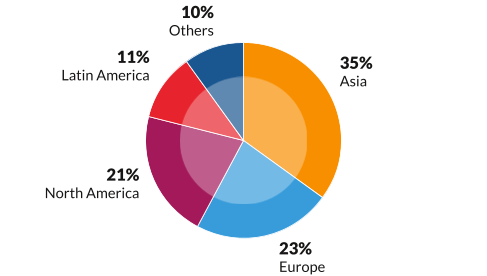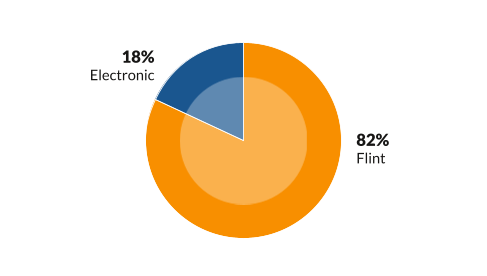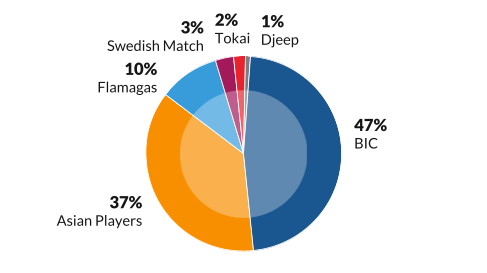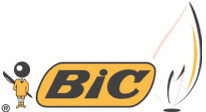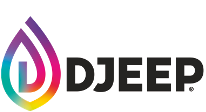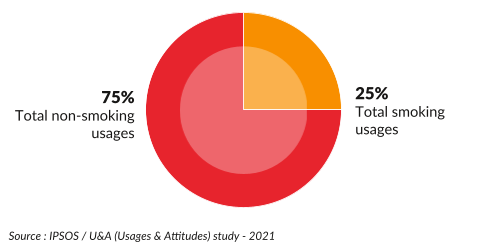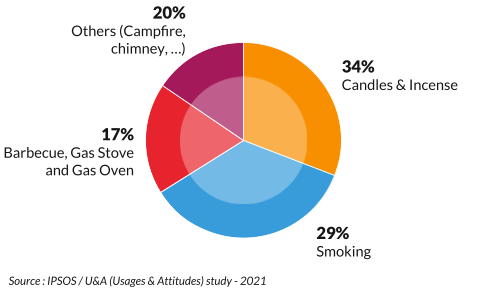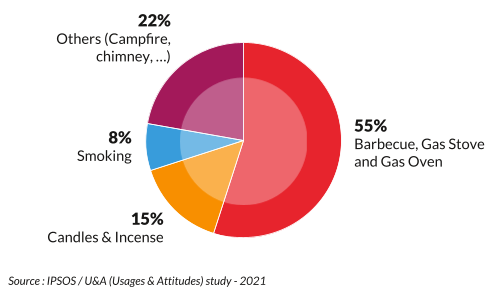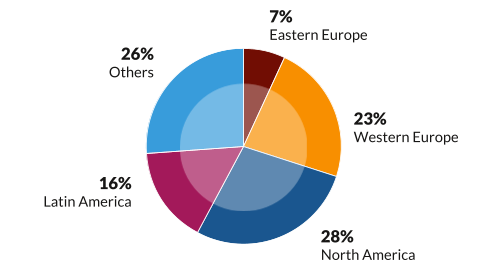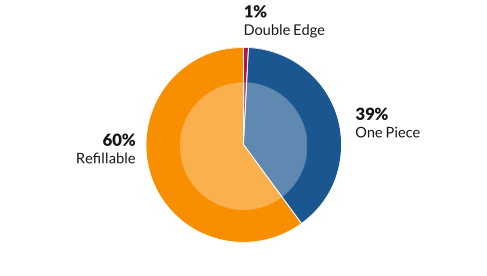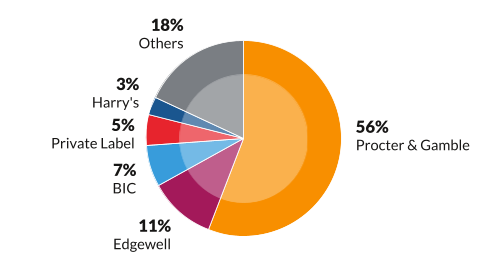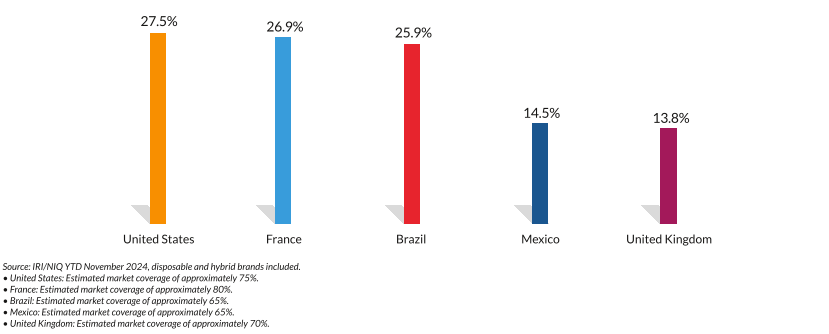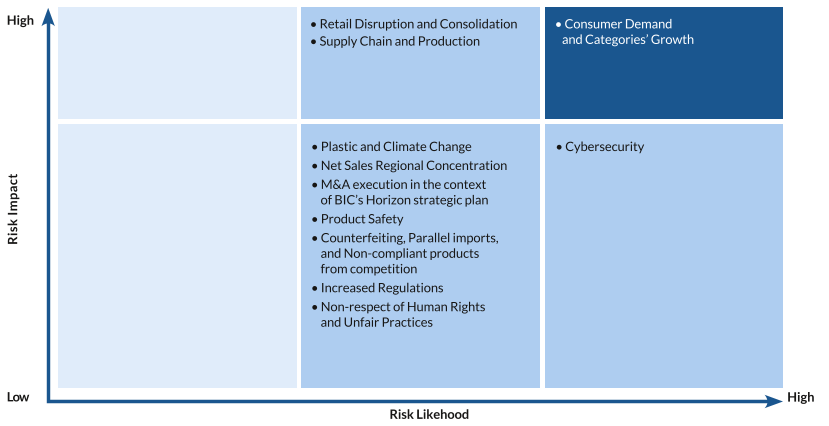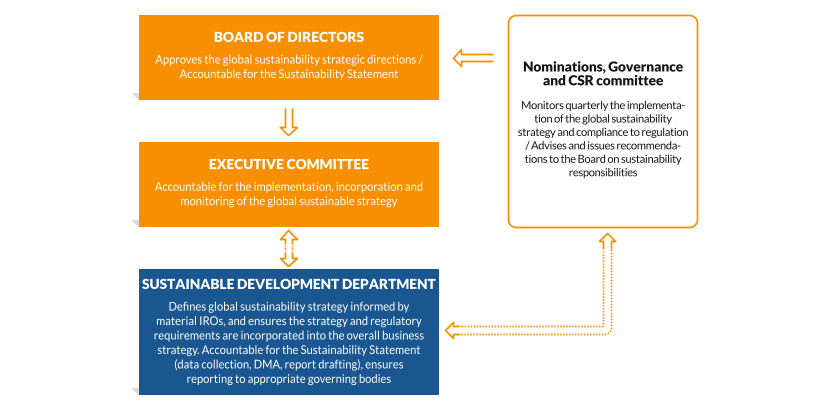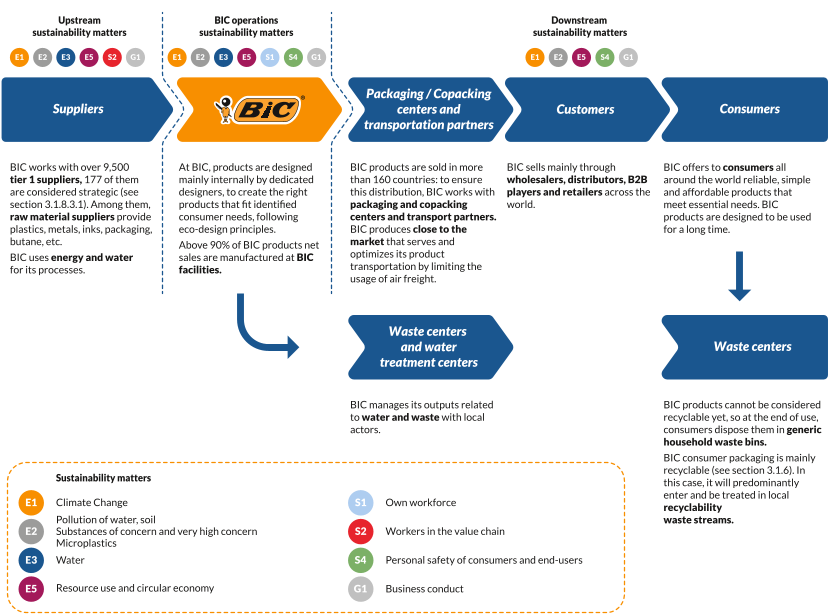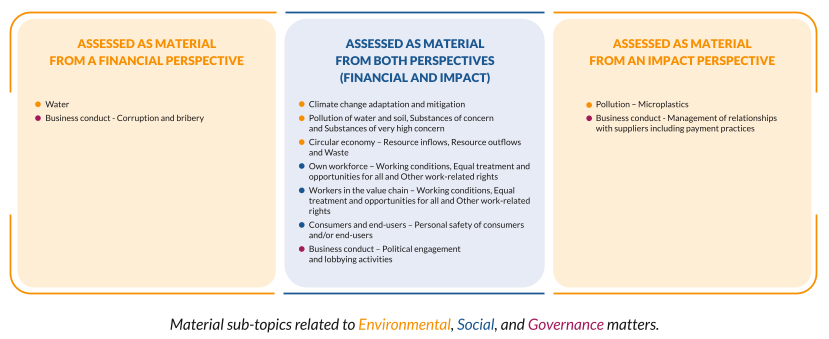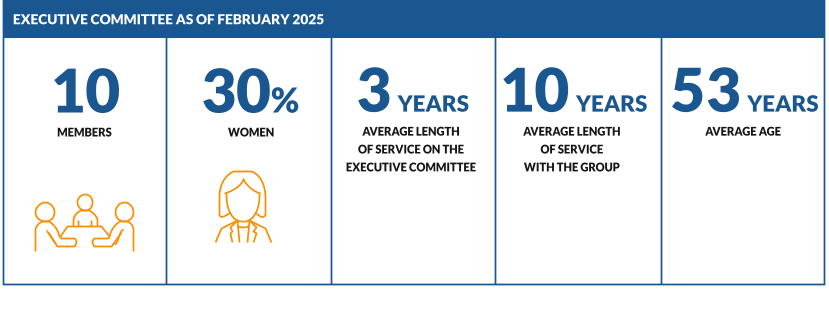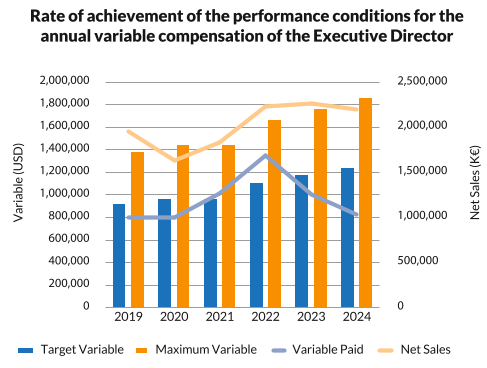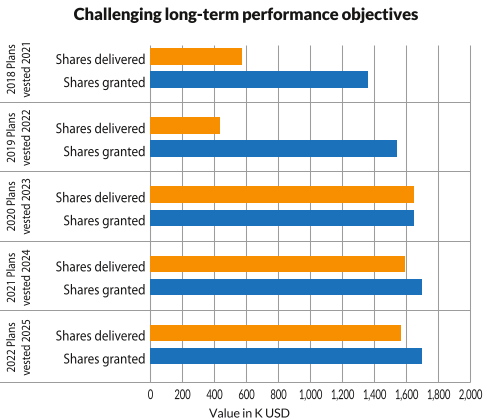URD 2024
-
Group presentation, Outlook, and strategy
1.1.History
Marcel Bich acquires a factory in Clichy, France, and starts a Writing Instruments business with his partner Édouard Buffard.
Launch of the “Pointe BIC®” in France, a revolutionary improved version of the Ball Pen invented by Hungarian Laslo Biro.
Acquisition of the Waterman Pen company in the United States. Expansion into Africa and the Middle East.
Diversification into the leisure industry through its subsidiary, BIC Sport, specializing in windsurf boards.
Acquisition of Tipp-Ex, the leading European correction products brand, and Sheaffer, a high-end brand in Writing Instruments.
Mario Guevara becomes Chief Executive Officer of BIC in May.
Acquisition of PIMACO, Brazil’s leading manufacturer and distributor of adhesive labels.
Opening of a new shaver packaging facility in Mexico.
Acquisition of Antalis Promotional Products (Sequana Group).
Acquisition of 40% of six (of the seven) Cello group entities, a leading stationery group in India.
Acquisition of Norwood Promotional Products, a U.S. leader in calendars and promotional products.
Disposals of the PIMACO B-to-B division in Brazil and the REVA Peg-Making business in Australia.
Acquisition of Angstrom Power Incorporated, a company specialized in portable fuel cell technology.
Launch of BIC® Education, an educational solution for elementary schools, combining handwriting and digital technology. Completion of the share purchase following the call option exercised on September 17 on Cello. Increase of BIC’s stake in Cello’s seven entities from 40% to 55%.
Acquisition of land in Nantong, China (130 km North of Shanghai) to build a lighter production facility.
Sale of BIC’s Portable Fuel Cell Technology business to Intelligent Energy.
Cello sells its remaining stake in Cello to BIC. This raises BIC’s stake in Cello to 100%.
Mario Guevara retires from his position as Chief Executive Officer. The Board of Directors decides to combine the roles of Chairman and Chief Executive Officer and appoints Bruno Bich as Chairman and Chief Executive Officer.
Sale of BIC Graphic North America and Asian Sourcing operations to HIG Capital.
Opening of the new Writing Instruments facility in Samer (France).
Bruno Bich retires from his position as CEO. The Board of Directors decides to split the roles of Chairman and Chief Executive Officer. Pierre Vareille is appointed Chairman of the Board and Gonzalve Bich becomes Chief Executive Officer.
Filing by BIC of an infringement complaint with the European Commission for lack of surveillance of non-compliant Lighters that are either imported into or sold in France and Germany.
Acquisition of manufacturing facilities of Haco Industries Ltd. in Kenya and its distribution activities of Stationery, Lighters, and Shavers. Disposal of BIC Sport, BIC’s water sports subsidiary, to Tahé Outdoors and discontinuation of its Writing Instruments manufacturing operations in Vannes.
Inauguration of BIC’s Indian subsidiary BIC Cello, in Vapi (Gujarat state).
Inauguration of BIC’s East Africa Facility in Kasarani, Nairobi.
BIC filed a complaint with the European Ombudsman claiming maladministration by the European Commission of the infringement procedure initiated in 2010 against the Netherlands due to their lack of actions to impose lighters safety standards compliance.
Completion of the acquisition of Lucky Stationary in Nigeria (LSNL).
Acquisition of Djeep, one of the leading manufacturers of quality Lighters, reflecting BIC’s strategy of greater premiumization and personalization.
Acquisition of Rocketbook, the leading smart and reusable notebook brand in the United States, expanding BIC’s business into the Digital Expression segment.
Sale of Brazilian adhesive label business, PIMACO, to Grupo CCRR, reflecting BIC’s portfolio rotation strategy and focus on fast-growing consumer segments.
Completion of the sale of BIC’s headquarters in Clichy-La-Garenne-based (France) and BIC Technologies sites for 175 million euros.
Completion of the divestiture of the Brazilian adhesive label business, PIMACO, to Grupo CCRR for 40 million Brazilian Real.
Acquisition of Inkbox®, the leading brand of semi-permanent tattoos.
Appointment of Nikos Koumettis as Chair of the Board.
Acquisition of Tattly®, a leading decal brand based in the U.S.
Acquisition of AMI (Advanced Magnetic Interaction), a French start-up pioneer in augmented interaction technology.
Héla Madiouni was appointed as Director representing the employees for the Board of Directors of Société BIC, replacing Inna Kostuk who resigned on October 14, 2022.
Véronique Laury and Carole Callebaut Piwnica were appointed as Directors.
Pascal Chevallier was appointed as Director representing the employees to the Board of Directors of Société BIC, replacing Vincent Bedhome, whose term has expired.
- ●2024
October: Sébastien Drecq was appointed as Director representing the employees to the Board of Directors of Société BIC, replacing Pascal Chevallier who resigned on August 31st, 2024.
December: BIC announced preparations for CEO Gonzalve Bich succession by September 30th, 2025.
December: BIC announced the acquisition of Tangle Teezer, a premium detangling haircare company.
-
1.2.Key figures
1.2.1Key financial figures
Net sales
2024 net sales by division
Earnings Before Interest and Taxes (EBIT)
Adjusted Earnings Before Interest and Taxes (aDJUSTED EBIT)
2024 EBIT by division
(in million euros)(1)
2024 Adjusted EBIT BY DIVISION
(in million euros) (2)
EBIT margin
Adjusted EBIT margin
Net income group share
Group Earnings per share and adjusted Group Earnings
per shareSales volume trends
Production volume trends
Net sales by region
(in million euros)
FY 2023
FY 2024
Change as reported
Change on a constant currency basis
Change on a comparative basis
Group
Net Sales
2,263.3
2,196.6
(2.9) %
+3.1%
+0.8%
Europe
Net Sales
665.9
697.8
+4.8%
+6.8%
+6.8%
North America
Net Sales
882.9
818.6
(7.3) %
(7.2) %
(7.2) %
Latin America
Net Sales
461.7
424.9
(8.0) %
+14.6%
+4.1%
Middle East & Africa
Net Sales
154.2
162.5
+5.4%
+15.8%
+15.8%
Asia & Oceania (including India)
Net Sales
98.6
92.8
(5.9) %
(4.7) %
(4.7) %
Main income statement information
Condensed profit and loss account
(in million euros)
FY 2023
FY 2024
Net Sales
2,263.3
2,196.6
Cost of goods
1,115.2
1,093.9
Gross Profit
1,148.1
1,102.7
Administrative & other operating expenses
827.6
813.0
Earnings Before Interest and Taxes (EBIT)
320.5
289.7
Finance revenue/costs
(7.5)
7.9
Income before tax
313.0
297.6
Income tax expense
(86.5)
(85.6)
Net Income Group Share
226.5
212.0
Group Earnings per share (in euros)
5.30
5.10
Average number of shares outstanding (net of treasury shares)
42,740,269
41,561,522
Key balance sheet aggregates
(in million euros)
December 31, 2023
December 31, 2024
Shareholders’ equity
1,846.6
1,793.3
Current borrowings
109.4
167.4
Non-current borrowings
46.8
167.5
Cash and cash equivalents – Assets
467.7
456.0
Other current financial assets and derivative instruments
19.8
6.3
Net cash position
385.4
189.3
Goodwill and intangible assets
382.3
557.1
Total balance sheet
2,647.3
2,834.5
Condensed cash flow statement
(in million euros)
2023
2024
Cash flow from operations
469.2
471.0
(Increase)/Decrease in net working capital
(27.4)
17.7
Other operating cash flow
(88.5)
(131.1)
Net cash from operating activities
353.3
357.7
Net cash from investing activities
(114.1)
(283.7)
Net cash from financing activities
(192.1)
(73.3)
Net increase/(decrease) in cash and cash equivalents net of bank overdrafts
47.2
0.7
Closing cash and cash equivalents net of bank overdrafts
467.7
456.0
-
1.3.Strategy and objectives
For 80 years, BIC has met consumer needs and desires with high quality, simple, and affordable products and has become one of the most recognized global consumer goods brands, with products sold in more than 160 countries. Our vision is to bring simplicity and joy to everyday life, as we seek to create a sense of ease and delight in the millions of moments that make up the human experience.
Over time, the Group faced rapidly-changing industries and consumption trends affecting its three categories, as consumers habits and their interaction with brands continuously evolved. BIC’s mission to offer high quality products to consumers everywhere and meet their fast-changing needs, drove the Group's transformation from a manufacturing and distribution-led company into a consumer-centric one.
1.3.1BIC Horizon Strategic Plan
BIC’s Horizon strategy was launched in November 2020 to spur an in-depth transformation of BIC’s business and create the innovative products and services of tomorrow with more focus on consumer needs and sustainability. The goal was not only to amplify its core capabilities, but to go beyond them into higher-growth adjacent segments to ensure long-term sustainable growth and profitability. Horizon is embedded in the Group’s everyday operations and strategic goals.
As part of this transformation, BIC reframed its three core categories through a heightened consumer lens to tap into a stronger growth trajectory:
- ●in Stationery, BIC evolved its focus to “Human Expression”, responding to shifting consumer habits towards more creativity and focus on value-added segments while optimizing its product portfolio;
- ●in Lighters, BIC expanded to “Flame for Life”, focusing on all consumer lighting occasions, including those non-related to tobacco, and driving towards a more balanced model between volume and value;
- ●in Shavers, BIC decided to capitalize on its assets, ground-breaking innovation and manufacturing capabilities to leverage its “Blade Excellence” with the objective to maximize these assets by building a B2B business – BIC Blade-Tech – which offers high quality shaving solutions to other brands.
Strategic and Financial Goals
Associated Targets
Growth acceleration
Deliver a mid-single-digit Net Sales growth trajectory
- ●Expand total addressable markets in fast-growing adjacent segments, and evolve BIC’s business model to capture an increasing value share of our markets, with a strong focus on execution and return on investments.
- ●Leverage innovation capabilities and manufacturing excellence to generate incremental revenues through new routes-to-market.
- ●Capitalize on our brands in our core markets and build on new lifestyles to grow a comprehensive portfolio of consumer-led brands.
Cash flow generation
Improve efficiency and robust Free Cash Flow generation
- ●Disciplined management of operational investments, with a target of 1 to 1.2 times Capex to Depreciation & Amortization.
- ●Strict control of Working Capital (Inventories, Receivables, and Payables).
Sustainable development
Take Sustainable Development to the next level and transform approach to recycling and plastics
- ●By 2025: 100% of packaging will be reusable, recyclable, or compostable.
- ●By 2030: Use of 50% non-virgin petroleum plastic in our products.
Capital allocation
Fund organic growth and acquisitions in adjacent markets while ensuring sustainable shareholder returns
- ●Investments into operations to sustain and enhance organic growth with approximately 100 million euros annual capital expenditures.
- ●Targeted acquisitions to strengthen existing activities and develop in adjacent categories, with an average of 100 million euros invested annually.
- ●Objective of ordinary dividend pay-out ratio in the range of 40% to 50% of Adjusted EPS.
- ●Regular share buybacks.
- ●in December, BIC acquired Tangle Teezer a market-leading, premium detangling haircare company, supporting BIC’s Horizon strategy by gaining exposure to a scaled, fast-growing and profitable business with meaningful upside potential. As part of BIC, Tangle Teezer is well positioned to reach further scale and gain market-leading positions in BIC’s key regions. Tangle Teezer’s expertly designed products, combined with BIC’s unique commercial and supply chain capabilities will continue to drive long-term profitable growth.
- ●BIC continued to focus on Revenue Growth Management by streamlining the Group’s portfolio to better meet consumer needs and optimize product mix. In 2024, this resulted in an 11% reduction in SKUs, leading to a total of 40% SKU reduction since 2019. BIC also continued to improve its net sales per SKU ratio by 15% in 2024. It almost doubled since 2019, with newly created products positively contributing.
- ●BIC pursued its strong commercial execution through the launch of impactful advertising campaigns which yielded tremendous results. In the US and Europe, BIC continued its long-lasting partnership with Snoop Dogg and Martha Stewart to promote its iconic utility pocket lighter EZ Reach™. In Human Expression, BIC launched several campaigns during the Back-to-School season such as “Go Make WOW” for BIC® Kids in Europe, and a 4-Color campaign “A pen for every side of you” featuring Charlie Puth in the US. In Blade Excellence, BIC partnered in Brazil with famous TV personality Lo Bosworth for the digital campaign “Tickle your senses”, promoting the new added-value Soleil Escape female shaver.
- ●eCommerce was a key growth driver with core ecommerce sales increasing double digits at constant currency. This growth was fueled by all three divisions in key regions, particularly North America, Europe and Latin America. Best-performing products online included the mechanical pencil in the US, the iconic 4-Color pen and the added-value Flex 5 Hybrid shaver in Europe.
-
1.4.Business presentation
BIC is one of the leading players in the stationery, lighter, and shaver markets. Guided by our long-term vision, we provide high-quality, affordable products to consumers everywhere. This consistent focus has helped make BIC one of the world’s most recognized consumer products goods companies, with products sold in more than 160 countries.
1.4.1Business presentation by division
BIC’s Horizon strategic plan launched in November 2020, aimed at driving sustainable growth by reframing our three categories to expand our total addressable markets in fast-growing segments.
1.4.1.1Human Expression – Stationery
In line with its Horizon strategy, BIC’s historical Stationery category evolved towards “Human Expression” to go beyond core Writing Instruments into Creative Expression. BIC constantly innovates to further strengthen its presence in both existing and adjacent segments.
Human Expression encompasses Writing Instruments and Coloring, Creative Expression which includes Arts and Crafts, Skin Creative and Digital Writing.
Since the launch of the BIC® Cristal® pen in 1950, BIC has continuously diversified its Stationery product range through more added-value products and innovative launches and with an increased focus on sustainability, simplicity and joy.
To name a few in the last three years, BIC launched BIC® Break-Resistant, a mechanical pencil with lead that is 75% stronger than the leading U.S. competitor, a BIC® Ecolutions Gel Pen made of 78% ocean-bound plastic or a new coloring range called Intensity. In 2020, BIC acquired Rocketbook the leading brand in Reusable Digital Notebooks. In 2022, BIC diversified further its brand portfolio, with the acquisition of Inkbox®, the leading brand of high quality semi-permanent tattoos (10-14 days), and Tattly®, a U.S. startup innovating in the field of high-quality temporary decals (2-4 days), which diversifies BIC’s offering in the rapidly growing Skin Creative market. In the Digital Writing segment, BIC acquired AMI (Advanced Magnetic Interaction), a French innovative startup. AMI strengthens BIC’s R&D capabilities in Digital Expression.
In 2024, BIC’s global product portfolio included writing, marking (classic, permanent and temporary tattoo markers), correction, coloring, drawing instruments, semi-permanent tattoo, and smart reusable notebooks.
Breakdown of the Human Expression market size per segment IN 2023
BIC’s markets and positioning
Core Writing & Coloring Instruments Market
BIC’s historical market Writing and Coloring Instruments amounted to 20.2 billion(6) euros in 2023. The Category is expected to grow at around 5.8% CAGR 2023-2027(7) driven by the rising demand from developing countries such as Mexico and Brazil. In parallel, innovation and premiumization will fuel growth in developed countries. The market is mainly fragmented among top players such as BIC, Newell Brands, Pilot and local family-owned groups. In 2023, BIC maintained its #2 global manufacturer position with circa 9% market share, benefiting from strong positions in both developed and developing markets.
Over the years, BIC strengthened its presence in Writing Instruments and Coloring’s markets through innovative launches enabling market share gains in key countries, whether it be in core writing instruments or in added-value segments. In 2024, BIC notably gained share in Writing Instruments in developed markets such as France, Mexico and Middle East and Africa.
Breakdown of the Writing Instruments market
By region (BIC estimates)
By product segment (BIC estimates)
main market leaders (Euromonitor)
BIC’s market share by segment (bic estimates)
BIC’s Market share by region - 2024
Creative Expression markets
The Arts and Crafts market is a large market experiencing mid-single-digit growth (estimated at 11.6 billion euros in 2023)(8). The market is expected to grow by 4.4% (CAGR 2022 – 2027) attributed to increased demand of both kids’ and teens’ market as well as from adults asking for more creativity. Kids’ crafts account for more than 50% of the total including a variety of sub-segments such as Finger-painting, Watercolors, Kits, Crafting Accessories, Modeling Clay and Slime.
The Skin Creative market, estimated at 7.7 billion euros in 2023, includes the permanent tattoos and the “Do it Yourself” Skin Creative segments. The market is expected to grow 1.2% (CAGR 2023-2027) (1). The fast-growing “Do it Yourself” Skin Creative segment includes temporary tattoo markers, temporary decals, henna tattoos and semi-permanent tattoos.
Digital Expression market
The Digital Writing market was estimated at 6.6 billion euros in 2023 (1). As technology is improving and becoming more affordable, this market should grow by 6.6% CAGR 2022-2027 to weigh above 8.8 billion euros. It encompasses four main sub-segments: digital notebooks, smart pens, slate tablets, and stylus for tablets.
BIC’s Brand Portfolio in Human Expression
BIC was built on the amazing power of its Brand, which is one of the world’s most popular household names. Over time, other brands have been added to our portfolio, most of them using BIC as an umbrella to drive attractiveness and consumer engagement, including Tipp-ex®, Wite-Out® and, more recently BodyMark® by BIC.
With Horizon, BIC started to migrate to a “house brands” strategy, where each brand has a different meaning for consumers. The acquisitions of Rocketbook, Inkbox® and Tattly® further strengthens this approach. BIC’s Human Expression division now offers a diversified panorama of brands, where consumers can each see themselves reflected and find their “own” brand favorites.
BIC’s Distribution Channels
Echoing its historical strategy “A BIC seen is a BIC sold”, BIC’s mission is to offer products available to consumers every day and everywhere.
BIC products are sold through a comprehensive range of channels worldwide as the Group pursues its objective to be an omnichannel specialist both offline and online. Products can be found in retail mass-market distributors, eCommerce channels (pure players, market places, B2B and B2C omnichannel retailers), traditional stores and Office Product suppliers (through contract or office superstores).
In the retail mass-market channel, Back-to-School season remains a key period. BIC offers consumers a tremendous range of school and college products through numerous displays, theatralization (for example the iconic school bus display in Europe) and merchandising tools.
Office and school supply companies remains a critical distribution channel where BIC has a strong position thanks to the quality, reliability and value for money positioning of its product, all even more important for companies, administrations and schools.
e-Commerce is a central development focus for BIC and the Group has leading positions in Stationery online in key markets such as France, the UK and the US.
1.4.1.2Flame for Life – Lighters
In line with its Horizon strategy, BIC’s historical Lighter category evolved to “Flame for Life”, focusing on all lighting occasions. Flame for Life aims to balance volume with a more value-driven model, with growth powered by trade-ups, personalization and innovation, to respond to changing consumer trends, while focusing more on sustainability.
BIC’s market and positioning
The worldwide pocket lighter market is estimated at 16.5 billion units (€6.6 billion in value) (9).
Breakdown of the global pocket lighter market in 2023
By region
By product segment (excluding Asia)
Market leaders (excluding Asia)
BIC’s leadership position and market shares
BIC is #1 worldwide in branded pocket lighters in value, with almost a 50% share in value in 2023 (excluding Asia) and leading positions in key geographies including North America, Latin America and Europe. The competitive advantages supporting BIC’s leadership position include safety, quality, strong brand awareness, automated and highly efficient manufacturing processes, and a solid distribution network.
BIC® pocket lighter market share in value (excluding Asia)
Safety and quality, key differentiators for BIC
BIC is well-known for providing safe, high quality and compliant lighters to consumers worldwide. A lighter is a plastic reservoir filled with pressurized gas that is lit by a flame. It can present a real danger if it is not designed and manufactured properly. The consequences can be severe and are often unknown to consumers. International Safety Standards protect consumers from unsafe lighters.
- ●international lighter safety standard ISO 9994, which sets out the basic safety requirements for a lighter. ISO 9994 is mandatory in major markets such as Canada (1989), Russia (2000), Brazil (2002), South Africa (2002), Argentina (2003), Thailand (2003), Mexico (2004), South Korea (2005), the 27 European Union member states (2006), Japan (2011), Indonesia (2011) and Turkey (2012);
- ●child-resistant requirements. A child-resistant lighter is purposely modified to make it more difficult to operate by children. Under this standard, the basic requirement is that a lighter cannot be operated by at least 85% of children under 51 months. Child-resistant legislation is mandatory in major countries such as the U.S. (1994), Canada (1995), Australia (1997), New Zealand (1999), the 27 members of the European Union (2006), Japan (2011), South Korea (2012) and Mexico (2016).
All too often, low-cost lighters fail to comply with safety standards. Since the late 1980s, lighter models imported from Asian countries have gained market share. They currently account for over half of the global market (in volume).
BIC has been defending its position in this competitive landscape since its creation and advocates for enhanced lighter safety and quality. BIC® lighters comply with even more stringent safety, quality and performance requirements. For example, the gas reservoirs of BIC® lighters are made from POM (PolyOxyMethylene), a high-performance resin with very high impact resistance. This means that BIC® lighters contain more gas, allowing more ignitions thanks to their wall’s thinness. They are also filled with pure isobutane, which ensures the flame’s stability throughout the lighter’s life.
Towards a more value-driven model through trade-up and innovation
BIC offers a wide range of high-quality Pocket and Utility lighters manufactured with the highest safety standards.
While BIC’s shift to balance more volume with value in the model for its Lighter business started years ago, this was accelerated with the launch of the Horizon Plan. More recently the following developments were made to support this transformation:
- ●the acquisition of Djeep in June 2020, which strengthened BIC’s portfolio in the added-value segment of decorated lighters;
- ●the launch of BIC® EZ Reach™, BIC’s first pocket Utility lighter, in the US in July 2020. The EZ Reach™ lighter was also launched into most major markets in Europe and Latin America;
- ●the launch of the BIC® EZ Load Lighter, BIC’s first-ever reloadable lighter, which can light up to 15,000 flames;
- ●the deployment of Revenue Growth Management strategy to drive efficiency in promotional and pricing activities.
In 2024, added-value lighters, including BIC® EZ Reach™, Djeep®, utility and decorated lighters, represented 36% of BIC’s total Lighter Net Sales.
BIC lighter brand portfolio
Addressing all lighting occasions including non-related to tobacco flame usages
An important pillar of BIC’s Flame for Life strategy is to drive growth by expanding to all flame occasions through incremental usages, as lighters have extensive non-smoking-related usages among different consumer activities. In recent years, BIC teams have undertaken extensive research to deepen their knowledge of the different flame usages. One of the main findings confirmed that candles and cooking are the most important non-tobacco-related flame usages in developed and developing regions (Ipsos study – October 2021). These lighting occasions represent a growth opportunity for BIC, well-positioned to answer the usages non-related to tobacco thanks to the strength of its brand.
Total Flame Devices – Share of Lighting Occasion
Detailed breakdown of flame occasions in the U.S. and Brazil
U.S.
Brazil
BIC’s Distribution Channels
BIC® lighters are sold through traditional distribution channels (such as convenience stores and tobacconists), retail mass-market distribution stores, and online in the United States. Online and offline, in-store visibility is key to driving impulse purchases, and part of BIC’s historical strategy “A BIC seen is a BIC sold”.
In the traditional channel, which is the leading channel for lighters, BIC has strong positions driven by full-distribution based on efficient routes-to-market, and relevant customer and consumer programs driving value to the business: BIC offers a large range of decorated lighters as well as bringing new products to market such as BIC® EZ Reach™, addressing everyday needs while generating impulse instore purchases.
In the mass-market channel, BIC focuses on relentless store visibility based on a multi-location presence in store: at the check-out but also throughout affinity aisles such as candle and barbecue.
In e-commerce, in 2024, BIC continued to expand its BIC.com website in the U.S., driven by the “Design my BIC” offer, enabling consumers to create sets of personalized lighters. They can also find appealing special editions, monochrome sets and brand-new series of lighters.
1.4.1.3Blade Excellence – Shavers
BIC’s Blade Excellence division focuses on reinforcing its one-piece business with consumer-driven and sustainable value-added products and capitalizing on our advanced R&D and manufacturing capabilities through the creation of BIC Blade-Tech, the Group’s B2B business which offers high quality shaving solutions to other brands.
BIC’s markets and positioning
The wet shave market was about 12.8 billion euros in 2023 and accounted for around 49% of the hair removal segment (10) in value. The estimate 2023-2027 CAGR(11) for Total Wet-Shave market is +4.6%.
Global wet shave market
By region
By product segment
Market leaders
The Wet-Shave market is split into three product segments: double-edge, one-piece and refillable. On the highly competitive environment of the one-piece and refillable segments, growth is mostly driven by new products which offer improved performance and added features. A constant ability to innovate is key to maintain a leadership position. With that objective, BIC has made the shift towards premiumization to gain market share on value-added segments, while keeping BIC’s strength in offering products at the right value.
The global landscape is dominated by three legacy brands (Gillette, BIC®, Edgewell) though over the last decade “disruptors”, primarily in the U.S. launching as direct-to-consumer brands, have emerged. While such brands have expanded presence by securing distribution in brick and mortar, they are not directly competing with BIC given their refillable segment focus.
BIC’s market share in the non-refillable shavers segment
BIC is the #3 worldwide player, with almost 7%(12) of the total wet shave segment. In the non-refillable segment (disposable), BIC ranks #2 worldwide with a 24% market share (13). The Group holds leadership positions in Europe where it became #2 in 2024, in the United States and in Latin America.
BIC’s product portfolio aiming for more innovative and sustainable products
In the 1970s, BIC revolutionized wet shaving when it launched the first one-piece shaver: the single blade “classic”.
Over the last decade and supported by the implementation of the Horizon strategy, BIC has focused its innovation, sales and marketing efforts on the high performance three, four, and five-blade sub-segments, offering thus a complete range of female and male products such as:
- ●for Men: BIC® Comfort 3®, BIC® Flex range, and BIC® Flex Hybrid (refillable) range;
- ●for Women: Miss Soleil, BIC® Soleil Escape;
In line with its Horizon strategy, BIC also innovates with new products centered on sustainability and tailored to consumer evolving trends. As such, BIC launched:
- ●an innovative hybrid shaver range in Europe in 2021 made with recycled plastic handles and sold with recyclable packaging;
- ●BIC® Click Soleil 5 in 2022: a razor for women with a handle made from 40% recycled material and co-developed with the raw material supplier Avient.
BIC Blade-Tech
BIC Blade Tech is a B2B business created as part of the Horizon Plan in 2020, aimed at leveraging BIC's leadership position and manufacturing excellence by powering other brands in the personal grooming industry. BIC Blade Tech offers a large variety of customizable products, from components (like cutting-edge blade heads and a diverse range of razor handles) to turnkey services (like packaged finished products). BIC Blade Tech is focused on delivering high-quality, tailored shaving solutions to meet customers' needs.
Tangle Teezer
In 2024, BIC expanded its presence in the personal grooming industry with the acquisition of Tangle Teezer a market-leading, detangling haircare brand, supporting BIC’s Horizon strategy by gaining exposure to a scaled, fast-growing and profitable business. This acquisition enables BIC to access a promising and large total adressable market of € 4.5 billion euros, growing at an average annual rate of +10% (Company estimates: CAGR 2023-2027).
Other products
-
Risk factors and management
Introduction
BIC maintains a proactive approach to identify, assess, mitigate, monitor and manage key risks that could impact:
- ●employees, customers, Shareholders’ interests, assets, environment or reputation;
- ●ability to achieve its targets and strategy;
- ●ability to stay true to its values; and
- ●ability to comply with laws and regulations including codes of ethics.
The assessment of the main risks takes into account the control measures implemented to reduce the risk (net or residual risk).
The risk factors set forth below regard matters that could have an adverse effect, potentially material, on our business, financial condition, results of operations and cash flows. Additional risks and uncertainties not currently known to us or that we currently deem to be immaterial may also have a material adverse effect on our business, financial condition, results of operations and cash flows.
BIC has taken a series of measures to mitigate the risks as described in section 2.2 Description and mitigation of main risk factors and 2.3.4 Insurance – Coverage of risks, and chapter 3.
-
2.1.Main risks and risk assessment
Risk Category
Risk Type
Risk Rating (a)
Low
Medium
High
Industrial and Commercial Risks
Consumer Demand and Growth (b)
X
Retail Disruption and Consolidation (b)
X
Supply Chain and Production (b)
X
Cybersecurity (b)
X
Net Sales Regional Concentration
X
Mergers & Acquisitions within BIC’s
Horizon Strategic PlanX
Product Safety
X
Environmental Risks
Plastic and Climate Change
X
Intellectual, Brand and Image Risks
Counterfeiting, Parallel Imports, and Non-compliant Products from Competition
X
Legal and Regulatory Risks
Increased Regulations
X
Social and Human Risks
Non-respect of Human Rights and Business Ethics
X
- ( a )Risk Rating is the product of Impact x Likelihood.
- ( b )Most material risks.
Geopolitical Landscape
The Group continues to closely monitor and mitigate the impact of geopolitical tensions, wars, and trade tariffs on our people and operations globally. The Group has no industrial presence in Russia and Ukraine. In 2024, Russia and Ukraine accounted for less than 3% total BIC Net Sales.
Currently, BIC has restricted its product range to cover essential shaving, writing, and household items only, such as lighters, and has paused all advertising, promotion, and capital investment in Russia. We will continue to monitor and comply with any new regulatory decisions, such as sanctions, and remain diligent in protecting our team members in the region. BIC maintains complete control of its brand and intellectual property in Russia to counter any potential moves for brand appropriation.
-
2.2.Description and mitigation of main risk factors
Consumer Demand and Growth
BIC is exposed to changing consumer trends, preferences and needs impacting all three categories – Human Expression, Flame for Life and Blade Excellence. Global consumer trends may include:
- ●growth in Digital Writing technology;
- ●reduced tobacco use or switch to e-cigarettes;
- ●changing shaving habits.
Risk Rating: High
Potential Impact on BIC:
- ●a lack of viable responses would impact sales and profitability;
-
●changing consumer habits impacting BIC’s three categories
might result in:
- ●a shift to digital versus Stationery,
- ●lower tobacco consumption and e-cigarettes impacting Lighters use,
- ●less frequent shaving in Shavers.
Examples of Risk Mitigation:
- ●focus Research & Development (R&D) on product innovations and brand positioning to address changes in consumer demand and needs (e.g. Lighter decors, personalization through BIC Graphic and Design my BIC);
- ●adopt a Consumer-lens to category expansion (e.g. EZ ReachTM Lighter, Skin Creative);
- ●expand in fast-growing Creative Expression and Digital Writing markets (e.g. Rocketbook® and AMI acquisitions, Skin Creative: BodyMark® Innovation plus Inkbox®, and TattlyTM acquisitions);
- ●focus on sales growth in Developing Markets particularly Eastern Europe and Middle East and Africa.
Retail Disruption and Consolidation
BIC® product sales may be adversely impacted by:
- ●potential mergers between retail customers;
- ●sales shift from brick and mortar to online/e-commerce;
- ●the potential reduction in pricing power related to pressure from retailers for lower pricing, increased promotional programs, and direct-to-consumer channels;
- ●increase in counterfeit products.
Risk Rating: Medium
Potential Impact on BIC:
- ●changing consumer buying habits may reduce pricing power through e-commerce channels and impact BIC’s sales;
- ●retail Consolidation (e.g. buying alliances and customer mergers).
Examples of Risk Mitigation:
- ●serve consumers wherever they shop across all channels from e-commerce to hypermarkets, stationery stores and small traditional trade stores;
- ●expand in e-commerce by covering the spectrum from Pure-Play e-retailers to omni-retailers as well as Direct to Consumer (DtC);
- ●compelling consumer displays in retail stores and strengthen search efforts in e-commerce to drive sales conversion;
- ●working on anti-counterfeit measures including investment in legal actions.
Supply Chain and Production
As a manufacturer, distributor and seller of consumer products, BIC is exposed to risks related to interruptions in production and internal and external supply chains issues, including:
- ●raw material shortages or operational disruptions at suppliers, particularly during the “back-to-school” season in Stationery;
- ●disruption in manufacturing and warehousing facilities. Certain products may be concentrated within specific regions, which may be impacted by a catastrophic event;
- ●storage and use of hazardous substances including gas for lighters, solvents for permanent markers and dry-wipe markers; and solvents for industrial cleaning processes.
Risk Rating: Medium
Potential impact on BIC:
- ●shortage of raw materials due to supplier business disruption. Potential causes include catastrophic events, changes in formulation, environmental regulations;
- ●significant supply chain disruption may lead to BIC’s inability to meet consumer demand and/or commitments;
- ●disruptions in manufacturing and interdependencies between sites might impact finished goods distribution;
- ●geopolitical disruptions, such as the current crisis in Ukraine, may continue to affect the supply and prices of certain raw materials.
Examples of Risk Mitigation:
- ●focus on raw materials and packaging supplier risk management, seeking alternative suppliers’ sources;
- ●integrated Business Plan platform to ensure sales and production product portfolio is “right sized” by location;
- ●focus on logistics supplier risk management and warehousing optimization plan to minimize disruptions to distribution (sea and road freight);
- ●people and Capabilities programs are in place to enhance the strategy and maturity of functions required for global supply chain disruptions;
- ●continuous footprint review process in place to reduce business continuity risk by bringing manufacturing closer to markets where appropriate.
In all BIC factories:
- ●implementation and monitoring of preventive and safety measures for gas and solvent storage areas;
- ●suitable control devices and equipment are in place to minimize risks from hazardous chemical substances;
- ●prioritization of fire prevention systems including fire detection and control equipment;
- ●perform hazard and risk assessments;
- ●identify, assess and prevent incidents and accidents;
- ●ongoing compliance with local regulatory requirements;
- ●training programs to back up the critical processes, ensure flexibility to cover market needs; to recognize potential hazards, as well as to take preventive and corrective action;
- ●maintenance programs to protect key equipment and technical processes.
The European Union SEVESO Directive identifies industrial sites that could pose significant accident risks. The SEVESO classified plants have emergency procedure protocols (plan d’opération interne and plan particulier d’intervention) and a major hazard prevention policy. All our SEVESO plants (Redon and Tarragona lighter factories, and BIMA stationery factory in Cernay) have implemented a safety management system according to SEVESO.
All other plants have equivalent emergency plans to address risks with potential local consequences.
Cybersecurity
In today’s digitally connected world, the frequency and sophistication of cyber-attacks are increasing, and BIC depends on resilient information technology (IT) systems and networks to operate our business and deliver quality products to consumers.
A cyber-attack could result in:
- ●operational delays or production downtimes;
- ●loss, corruption or compromise of data, confidential information, intellectual property, or otherwise protected information;
- ●security or data breaches;
- ●failure, manipulation, or improper use of BIC or third-party systems and networks;
- ●inaccurate financial reporting, financial losses from remedial actions, loss of business, or potential liability, regulatory fines and/or reputational damage.
Risk Rating: Medium
Potential Impact on BIC:
- ●unauthorized access, use, or disclosure of confidential or sensitive information, such as customer data, trade secrets, intellectual property, or personal information;
- ●disruption, misappropriation or damage to information systems, networks, or devices due to cyber-attacks, such as ransomware, malware, phishing, denial-of-service, or other malicious activities;
- ●financial loss, data breach, reputational damage, or legal and regulatory consequences from cyber fraud, such as business email compromise (BEC).
Examples of Risk Mitigation:
- ●established a cybersecurity organization and execute a multi-year strategy aligned with IT transformation;
- ●application of preventative security controls (e.g., multifactor authentication and email filtering), detection and response capabilities;
- ●requiring all employees to complete annual security awareness training and reinforce the training with periodic phishing and awareness campaigns;
- ●conducted internal risk assessments and partnered with third parties to perform security assessments of BIC IT infrastructure and applications;
- ●strict application of incident response plans and playbooks to minimize the impact and speed recovery from a cyber-attack.
Net Sales Regional Concentration
BIC’s Net Sales are concentrated in a few key markets, notably the U.S., Brazil, and France.
Risk Rating: Medium
Potential impact on BIC:
- ●such concentration of revenue generation potentially exposes BIC to risks of shifting consumer demand or regulatory environment in those markets.
Examples of Risk Mitigation:
- ●ongoing focus on sales in Developing Markets (Middle East and Africa, India, Mexico) and diversification in Europe;
- ●Roll-out of a portfolio approach (e.g. Europe focus on strengthening Lighters).
Mergers & Acquisitions within BIC’s Horizon Strategic Plan
BIC’s Horizon strategic roadmap includes targeted acquisitions to strengthen BIC’s existing activities and expand into adjacent growth businesses.
Risk Rating: Medium
Potential impact on BIC:
- ●challenge to identify and execute strategic acquisitions at attractive valuations;
- ●difficulty in efficiently integrating acquired companies, resulting in a lower value capture impacting return on investment.
Examples of Risk Mitigation:
- ●dedicated, centrally led M&A, Value Capture and Integration (VCI) teams are in place, made up of professionals with extensive M&A backgrounds;
- ●disciplined M&A and Value Capture & Integration Processes & Playbooks have been established with strong governance and clear accountability;
- ●disciplined governance process supports pipeline development, target company evaluation and due diligence, and financial return expectations of deals;
- ●application of a VCI planning and execution process to govern cross-functional integration, focused on establishing the adequate Operating Model to enable delivery of the synergies and value capture initiatives.
Product Safety
The risk related to product safety and consumer health and safety by placing non-compliant or unsafe products on the market.
Risk Rating: Medium
Potential impact on BIC:
- ●impact on consumer health and safety;
- ●impact on the Brand image (consumers), BIC’s reputation and business interests;
- ●potential costs associated with possible market withdrawal, recall, fines and lawsuits.
Examples of Risk Mitigation:
- ●the Product Safety Statement includes commitments and processes to ensure that products designed and manufactured by the Group and sourced from Original Equipment Manufacturers (OEM) are safe for the health and the environment;
- ●BIC embeds regulatory compliance and product safety risk management into its strategy through a rigorous set of processes. The quality of the million products that BIC supplies every day is assured by a robust quality system and is systematically controlled by multiple tests;
- ●consumer health and safety considerations are part of product design and manufacturing. The Product Safety Team collects and shares crucial information about the chemicals used by the Product Development Team to ensure that responsible chemistry criteria are being met. The product Safety team works closely with the product Development teams and legal to stay abreast of regulatory changes and act proactively;
- ●for BIC trademark license agreements licensee must observe regulatory compliance and follow the applicable product safety protocols (e.g., Lighters).
For further information please see section 3.1.9 Consumers and end-users.
Plastics and Climate Change
Major risks for BIC are:
-
●risks related to plastics encompass:
- ●upstream risks: with this material being used in BIC® products this is subject to price volatility and availability,
- ●downstream risks: with potential issues surrounding pollution from plastic waste. In addition, and although BIC® products are not single-use, the regulatory environment surrounding plastics and packaging is becoming increasingly stringent (Extended Producer Responsibility),
- ●some national and regional regulations are moving towards the establishment of collection and recycling systems for both products and packaging. Consumers and public opinion also hold increasingly negative views regarding such products;
-
●risks related to climate change include:
- ●risk of an increase in raw material costs due to potential carbon taxes,
- ●energy efficiency programs, carbon capture and other measures by suppliers might increase raw material production costs,
- ●risk of an increase in the cost of alternative plastic sourcing due to growing competition and of quality issues,
- ●extreme weather changes and climate risks that might affect our operations, suppliers, transportation routes and cost to operate.
Risk Rating: Medium
Potential Impact on BIC:
The potential impacts on BIC include:
- ●increased cost of raw materials;
- ●availability and price volatility of plastics;
- ●brand image deterioration due to plastic in our products;
- ●heightened regulations on plastics, impacting BIC’s direct or indirect operations;
- ●regulatory pressure affecting operating costs;
- ●disruption or interruption to production activities due to extreme weather events (floods, fires, heat stress) related to climate change;
- ●environmental labelling of products, thereby impacting sales.
Examples of Risk Mitigation:
-
●a
Sustainable Development Program – Writing The Future
Together –
designed to limit the environmental impact of BIC’s
activities. This covers BIC’s activities, products and
supply chain, and it is embedded in our Horizon Plan
strategy and commitments, including:
-
●fostering sustainable innovation in BIC products:
- ●by 2025: improving the environmental footprint of BIC® products,
- ●by 2025: 100% of BIC’s consumer plastic packaging will be reusable recyclable or compostable,
- ●by 2030: BIC aims for 50% non-virgin petroleum plastic for its products;
- ●by 2025, the use of 100% renewable electricity.
-
●fostering sustainable innovation in BIC products:
At BIC, we use what we call a 4 R philosophy that we use to guide us when developing products:
- ●reduce the consumption of materials;
- ●use recycled or alternative materials;
- ●design and manufacture refillable products and packaging whenever possible; and
- ●design and manufacture recyclable products and packaging.
In 2024, BIC undertook a Double Materiality Assessment to review the physical risks from climate change to all its facilities and those of some contract manufacturers and suppliers. The analysis included 267 facilities globally, including manufacturing centers, offices, warehouses and land owned by a third-party supplier or owned and leased by BIC. This analysis will be updated annually.
The climate hazards in the analysis included extreme weather events. A number of the facilities exposed are not owned by the Group.
All these initiatives and those mentioned in the Group’s sustainable development Strategy in Chapter 3 help mitigate the risks.
Counterfeiting/gray goods, Parallel Imports and Non-compliant Products from Competitors
Counterfeits of the well-known BIC products circulate throughout Africa, the Middle East, Eastern Europe and South America. A recent trend shows an increase in counterfeits in North America. They are mostly manufactured in Asia. These counterfeits, often of low quality, are mainly focused on our products’ shape and on the BIC® trademark. Grey goods (i.e., genuine BIC products made for specific markets and smuggled into another country) that could violate regulations also pose product recall risks, particularly in the United States.
Particularly in the European Union and Middle East Africa, the Group also faces competition from low-cost lighters that often do not comply with safety standards, ISO 9994 international safety standard, and the child resistance standard.
Risk Rating: Medium
Potential impact on BIC:
- ●impact on the Brand image (Consumers) BIC reputation;
- ●unfair competition with non-conform or counterfeit products;
- ●costs associated with possible market withdrawal or recall and/or fines.
Examples of Risk Mitigation:
-
●the Legal Department leads the relevant courses of action
against such counterfeits, grey goods and non-compliant
products by closely working with local authorities and law
enforcement agencies including:
- ●judicial and administrative actions,
- ●monitoring program of leading e-commerce platforms,
- ●market surveillance, traceability measures, and collaboration with local authorities to prevent illegal imports of grey goods to the U.S;
- ●BIC also targets non-compliant lighters through engagement efforts geared towards stakeholder such as customers, market surveillance authorities, European Union (EU) Commission, EU Parliament, etc.;
- ●the Group continues to advocate to reinforce market surveillance in Europe and help shape regulations such as the EU’s General Product Safety Regulation issued in 2023;
- ●over the past years, BIC worked to improve lighter safety standards in Mexico, advocated in Brazil for a return to strict legislation on lighter market surveillance and strengthened market surveillance campaigns in Argentina. For example, in 2024, following fruitful engagements, lighters are about to be placed again on the priority list for surveillance in Brazil, while in Mexico, an agreement was reached to enhance the ISO (International Standards Organization) lighter safety standard requirements;
- ●the ISO 9994 safety standard has become mandatory for the first time in the United States in 2022, in the state of Connecticut, and has expanded to the state of Wisconsin in 2024.
Increased Regulations
Restrictions and prohibitions are increasingly common in the fields of chemical substances and plastics, particularly in North America and Europe. Bans on PFAS (per- and polyfluoroalkyl substances) on the two continents are coming within the next five years. In the EU, the “European Green Deal” scheme aiming at making Europe the first carbon neutral continent by 2050, includes an ambitious plan “the Ecodesign plan for Sustainable Products Regulation” (ESPR). The purpose of the regulation is to define rules to make products more sustainable. More local regulations are imposing circular economy schemes (Extended Producer Responsibility).
Risk Rating: Medium
Potential impact on BIC:
- ●impact on manufacturing processes and business interests;
- ●reputation damage and impact on the Brand image (Consumer);
- ●legal actions against BIC.
Examples of Risk Mitigation:
BIC closely monitors announced regulatory changes and voices relevant technical and legal arguments:
- ●together with other European manufacturers, BIC continues to sustain its interpretation of the scope of the EU’s CLP regulation (Classification, Labelling, Packaging);
- ●in 2024, BIC formed a consortium with other blade manufacturers to to address global regulatory developments around Per- and polyfluoroalkyl substances (PFAS) usage by providing awareness of ingredients, technologies, and innovations in the razor blades industry. In the U.S., a class action suit against BIC for lack of information on shaver packaging related to PFAS was voluntarily dismissed.
Non-respect of Human Rights and Business Ethics
This risk includes non-compliance with fundamental human rights such as child labor, forced labor, or discrimination, as well as business ethics such as corruption.
Risk Rating: Medium
Potential Impact on BIC:
- ●reputation damage and impact on the Brand image (Consumer);
- ●legal actions against BIC;
- ●fines.
Examples of Risk Mitigation:
- ●BIC’s Code of Conduct and related policies apply to BIC worldwide and reflect its commitment to conduct business ethically and in compliance with human rights and fundamental freedoms. Mandatory trainings are delivered to employees to raise awareness;
- ●BIC expects all its business partners to comply with its Code of Conduct. For example, BIC’s Supplier Code of Conduct outlines its expectations with respect to responsible sourcing, including human rights and business ethics;
- ●BIC regularly monitors the implementation of its Code of Conduct principles and requirements through internal and external audits;
- ●Risks related to business ethics are mapped and regularly updated to ensure continuous monitoring as well as adequate and effective remedial measures (section 3.1.10.2.4 Prevention and detection of corruption and bribery and 3.2.3.1 Methodology);
- ●BIC Speak Up program allows management and mitigation of potential risks and violations (section 3.2.5.3 Whistleblowing Mechanism and Reporting System);
- ●More than 90% of BIC’s net sales come from products made in its factories, thus, reliance on contract manufacturing is relatively low.
Further information can be found in chapter 3.
-
2.3.Risk Management and Internal Control Procedures implemented by the Company and Insurance
2.3.1Risk Management and Internal Control definitions and objectives
2.3.1.1Adoption of the Principles of the AMF’s Reference Framework for Risk Management and Internal Control Systems
For the purposes of this section, the Group complies with the principles outlined in Part II of the Risk Management and Internal Control Systems – Reference Framework updated in July 2010 by the Working Group chaired by Olivier Poupart-Lafarge and established by the AMF. This represents a partial adoption of the full text that also provides an Application Guide for internal control procedures for the accounting and financial information published by the issuer.
The related specific control activities are the responsibility of the local subsidiaries. Those subsidiaries continuously adapt them in response to current circumstances, drawing guidance from the Group Accounting and Controllers’ Manuals. The Application Guide has not been formally compared to existing procedures and processes, but the Group does not expect material differences given the similarities between the Application Guide and these two manuals.
a)Risk management
Risk management encompasses a set of resources, behaviors, procedures and actions that are tailored to the characteristics of the Company and its employees while observing legal requirements.
- ●the Company’s ability to achieve its business goals and core strategy;
- ●the Company’s ability to abide by its values, ethics, laws and regulations;
- ●the Company’s personnel, assets, environment, financials, or reputation.
- ●maintain and protect the Company’s value, assets and reputation;
- ●safeguard the Company’s decision-making and processes to achieve its objectives;
- ●ensure that the Company’s actions are consistent with its values.
b)Internal control
The risk management process also incorporates the definition of company-wide internal controls to ensure that:
- ●the Company remains in full compliance with evolving laws and regulations, and operates with the highest level of ethical business standards;
- ●the instructions and guidelines issued by Executive Management are followed;
- ●the Company’s internal processes remain effective and continuously improve, particularly those involving the protection of its assets. Assets are understood to be both tangible and intangible (know-how, brand, image or reputation) and are used throughout existing Company processes;
- ●financial information is reliable.
- ●compliance with all applicable laws and regulations governing the Company and its daily operation;
- ●ongoing communication and guidance to employees to ensure they understand the full scope of their responsibilities and expected contributions to the Company;
- ●guidance for operational, industrial, commercial and financial processes;
-
●producing reliable financial statements(1). The reliability of such information depends on the quality of the
associated internal control procedures and system (see reporting
procedures section 2.3.2.4 Internal Control procedures) including:
- ●the segregation of duties principle, enabling a clear separation between input, operating and retention duties,
- ●guidance regarding the identification of the source of the information and materials produced,
- ●transactions recorded in accordance with applicable accounting standards.
2.3.1.2Scope of Risk Management and Internal Control
Risk management and internal control, as defined in this report, apply to Société BIC as Group parent company and all Group consolidated entities.
- ●the existing organization;
- ●the objectives set out by the Board of Directors and the Executive Committee (see section 2.3.3 Risk Management and Internal Control approach and structure); and
- ●compliance with laws and regulations.
Supporting principles and systems have been established in all relevant areas and subsidiaries, considering local specificities and regulations. These principles are also known to and followed by the various centralized Group departments.
The Risk Management principles also apply to any entity joining the Group. Whenever possible, the Group asks its subcontractors and suppliers to also comply with these principles.
2.3.1.3Limitations of Risk Management and Internal Control Systems
Risk management and internal control systems have inherent limitations and cannot provide an absolute guarantee that the Company’s objectives will be met. Despite the control measures we currently have in place, our systems and those of our third-party service providers are subject to the ever-changing risk of compromised security, acts of vandalism, human errors and other unforeseen events.
-
Corporate Social Responsibility and Performance
As required by the Corporate Sustainability Reporting Directive (“CSRD”), BIC’s 2024 Sustainability Statement complies with the European Sustainability Reporting Standards (“ESRS”).
- ●Sustainability Statement as per the CSRD and its transposition into French law through Ordinance n° 2023-1142 of December 6, 2023. This section includes information on sustainability matters that are material for BIC based on the double materiality assessment (DMA, see section 3.1.1.4) carried out in 2024;
- ●Vigilance Plan as per the requirements set out in French law No. 2017-399 of March 17, 2017 on the duty of vigilance of parent companies (“Vigilance Law”) and with Article L. 225-102-4 of the French Commercial Code. This section contains information on the Group’s Vigilance Plan, including the necessary measures to identify and prevent risks relating to severe human rights and fundamental freedoms infringements, health and safety hazards, and environmental damage.
As required by Ordinance n° 2023-1142 of December 6, 2023 and Article L. 2312-17 of the French Labour Code, the Work Council will be informed and consulted on the Sustainability Statement in 2025.
3.1Sustainability Statement
3.1.1General information (ESRS 2)
3.1.1.1General disclosures
3.1.1.1.1General basis for preparation of the Sustainability Statement (BP-1)
Scope of consolidation
The scope of consolidation of this Sustainability Statement is the same as the one for financial statements (see section 6.1. for more details), i.e. all the consolidated entities as of December 31, 2024 in accordance with Article L. 233‑16 of the French Commercial Code, apart from the exemptions stated in the table below.
Tangle Teezer, a premium detangling haircare company, acquired by BIC on December 11, 2024, is not included in the reporting scope.
Some indicators have their own perimeter. Specific perimeters for indicators are systematically mentioned to make reading easier and ensure data understanding. Themes where specificities occur are presented in the table below.
Topic
Reporting perimeter
Environmental indicators
Reporting perimeter includes:
- ●BIC factories that manufacture finished or semi‑finished products;
- ●engineering units and packaging operations with over 50 employees or where operations are subject to government regulations such as SEVESO (EU), PSM or RMP (U.S.);
- ●administrative and commercial entities.
For pollution (ESRS E2), key performance indicators are disclosed for Group Supply Chain (GSC) scope.
For packaging indicators (ESRS E5), BIC Graphic, recent acquisitions from 2019, and certain Contract Manufacturers are excluded from key performance indicators’ perimeter.
Human Resources indicators
Reporting perimeter includes:
- ●headcount data, which encompasses all BIC employees, including permanent employees and temporary employees (fixed-term contracts, apprentices and interns);
- ●data relating to BIC's ‘Own Workforce’, which encompasses all BIC employees plus non-employees; and
- ●workforce data, which covers all BIC sites (including factories, offices and remote/mobile workers).
Health and safety indicators
Reporting perimeter includes all Group facilities (offices, industrial facilities) except for the Sibjet site (Djeep) and encompasses the BIC permanent employees, fixed-term contracts, apprenticeships and interns.
Value chain coverage
The Sustainability Statement includes important information regarding BIC’s upstream (e.g., BIC Tier 1 Strategic Suppliers(1)) and downstream (e.g., customers and end-users) value chain, that have been identified during the double materiality assessment (DMA – see section 3.1.1.4). BIC has focused its assessment work on:
- 1.value chain entities associated with hotspots that present real or potential impacts on people and/or the environment; and
- 2.entities presenting key dependencies on natural, human and social resources regarding its products and/or services, generating risks and opportunities for the Group.
Omission of specific pieces of information
The Group has not used the option to omit specific pieces of information corresponding to intellectual property, know-how or the results of innovation.
The Group has used the option to omit the absolute weight of inputs (see section 3.1.6.2.2) because this information is considered as sensitive information. The overall relevance of the disclosure regarding inputs is not impaired.
3.1.1.1.2Disclosures in relation to specific circumstances (BP-2)
Time horizons
The reference period for this Sustainability Statement corresponds to the calendar year 2024. Some data contained in the report are also measured in comparison to a reference year, which is systematically presented.
- ●short term: reporting period of 1 year;
- ●medium term: less than 5 years; and
- ●long term: over 5 years.
Value chain estimation
To produce the GHG inventory, BIC uses activity-based sources. However, for the following upstream and downstream value chain data, BIC estimates using financial sources:
The emission factors used to build the GHG inventories are updated every year and approved through the GHG inventory tool used by BIC.
Sources of estimation and outcome uncertainty
The data presented in this report is derived from activity-specific information, utilizing the most accurate databases available.
Changes in preparation or presentation of sustainability information
No significant changes were made in the preparation or presentation of sustainability information, except that the scope of environmental metrics—covering carbon, pollution, water, and waste—now includes administrative and commercial entities. This adjustment is reflected in the dedicated sections to ensure data clarity.
Changes to the preparation and presentation of HR information have been made to align with new CSRD reporting requirements, for example calculation of certain metrics for the whole BIC headcount (rather than as previously for permanent employees only). Where comparisons are made to previous year data, explanations are provided in the dedicated sections below on whether data is comparable or if prior year data shown has been recalculated.
Reporting errors in prior periods
Due to errors in the 2023 production data, certain environmental data from 2023 has been corrected. Detailed explanations are provided in the dedicated sections below.
The number of lost-time incidents for 2023 has been updated from 36 to 38, following the classification of two additional incidents as lost-time incidents by authorities after the conclusion of the audit. The 2023 incident rate was adjusted accordingly.
Disclosures stemming from other legislation or generally accepted sustainability reporting pronouncements
BIC reports information stemming from Global Reporting Initiative (GRI) (2) standards which are listed in the corresponding table that is made available on our website on this page: Sustainability report | BIC Investors.
Through its strategy “Writing the Future, Together,” the Group has made commitments aligned with some Sustainable Development Goals (SDG) (3). The table below presents the corresponding sections in the Chapter.
Sustainable Development Goals
Corresponding section in the URD
3. Good health and well-being
5. Gender equality
6. Clean water and sanitation
7. Affordable and clean energy
8. Decent work and economic growth
3.1.3 / Climate change (ESRS E1)
3.1.6 / Resource use and circular economy (ESRS E5)
9. Industry, innovation and infrastructure
10. Reduced inequalities
12. Responsible consumption and production
13. Climate action
14. Life below water
16. Peace, justice and strong institutions
3.1.7 / Own workforce (ESRS S1)
Incorporation by reference
In order to limit redundancy, certain data is incorporated by reference in this Sustainability Statement.
Specific data points
Corresponding section in the URD
Role of the administrative, management and supervisory bodies
(ESRS 2 GOV-1)4.1.2 / Composition of the Board of Directors
4.1.3 / Changes in the composition of the Board of Directors
Integration of sustainability-related performance in incentive schemes
(ESRS 2 GOV-3)Statement on due diligence (ESRS 2 GOV-4)
Risk management and internal controls over sustainability reporting
(ESRS 2 GOV-5)2.1. / Main risks and risk assessment
2.2. / Description and mitigation of main risk factors
2.3. / Risk Management and Internal Control Procedures implemented by the Company and Insurance
Strategy, business model and value chain (ESRS 2 SBM-1)
General presentation of the Group / BIC's Business model
Product safety – Lighters safety specifications (ESRS S4)
1.4.1 / Business presentation by division
Especially 1.4.1.2 / Flame for Life – Lighters
3.1.1.2Governance
3.1.1.2.1Role of the administrative, management and supervisory bodies (GOV-1)
Composition and diversity of the members of BIC’s administrative, management and supervisory bodies
The Board of Directors
As of December 31, 2024, the Board of Directors is composed of 12 members, including one executive member, Gonzalve Bich, Director and CEO, and 11 non-executive members. More details are presented in section 4.1.2. Their competencies, in particular the ones related to sustainability matters, are detailed in section 4.1.3.3. Their diversity representation as well as the Board’s gender diversity ratio are presented in section 4.1.2.3.
The two Directors representing employees are presented in section 4.1.2.6.
The Board of Directors is comprised of five Independent Directors (see section 4.1.2.5), their proportion within the various Committees of the Board is presented in section 4.1.4.3.
The Executive Committee
The Executive Committee is composed of 10 members(4), all of whom, except for the CEO, are employees of BIC Group. More details on their profiles and roles are presented in section 4.1.1.4.
Roles and responsibilities of BIC’s administrative, management and supervisory bodies
The sustainability strategy – informed by the material impacts, risks and opportunities (IROs) – is defined by BIC’s Sustainable Development Department. The Executive Committee is responsible for incorporating the global sustainability strategy into the overall business strategy, ensuring and monitoring progress.
The Nominations, Governance and CSR Committee is responsible for overseeing this process and reporting to the Board of Directors. It monitors on a quarterly basis the implementation and progress of the global sustainability strategy and BIC’s compliance to regulation. It advises and issues recommendations to the Board on sustainability responsibilities. The Nominations, Governance and CSR Committee’s members, their expertise, missions, and powers are presented in section 4.1.4.3.
To ensure that the necessary skills and expertise to oversee sustainability matters are available or developed, the Nominations, Governance and CSR Committee have undertaken several initiatives this year.
First, three specific trainings on the Corporate Sustainability Reporting Directive (CSRD) were organized for the Nominations, Governance and CSR Committee:
- ●a session focusing on the CSRD Auditor role and reporting under financial auditing standards;
- ●a presentation by a law firm addressing governance aspects related to the CSRD; and
- ●a training session conducted by a sustainability consulting firm, to deepen Directors’ understanding of the directive’s requirements on strategy and operational matters.
Additionally, Marie-Aimée Bich-Dufour, Director and member of the Nominations, Governance and CSR Committee, attended a training program by the French Institute of Directors (IFA) on the CSRD, further strengthening her individual expertise on the topic.
The Nominations, Governance and CSR Committee has consequently enhanced its collective knowledge in 2024 and plans to continue these efforts in 2025. Additional training sessions will be implemented, including presentations on more operational topics, to further expand its understanding and expertise on sustainability matters.
These initiatives demonstrate the Group’s commitment to equipping its governance bodies with the skills needed to effectively address sustainability-related challenges and opportunities.
BIC’s Sustainable Development Department – led by the Group Sustainability Officer – is working on ensuring proper governance processes, controls and procedures are in place and integrated with other internal functions. The Group Sustainability Officer reports directly to the CEO and also presents on a quarterly basis to the Nominations, Governance and CSR Committee.
In 2024, the Group Sustainability Officer presented four times to the Nominations, Governance and CSR Committee, addressing key topics such as the selection of CSRD auditors in charge of certifying the sustainability-related information, the DMA, and the evolution of performance indicators in the Group’s scorecard (which is updated several times a year).
BIC’s Sustainable Development Program “Writing the Future, Together” is presented in section 3.1.1.3.1.
3.1.1.2.2Information provided to and sustainability matters addressed by administrative, management and supervisory bodies (GOV-2)
As highlighted above, the Group Sustainability Officer reports on a quarterly basis to the Nominations, Governance and CSR Committee who reports in turn to the Board of Directors. The Sustainable Development Department is responsible for defining and monitoring the global sustainability strategy informed by the material IROs and ensuring reporting to the appropriate governance bodies, namely the Executive Committee, the CEO and the Nominations, Governance and CSR Committee.
The full list of material IROs is considered in the overall sustainability strategy’s implementation, while the reporting to the appropriate governance bodies focuses on key material IROs impacting the overall business strategy.
As it is the first year of application of the CSRD, BIC has prioritized the process of DMA, which has been presented and validated by the different governance bodies. The overall governance structure regarding sustainability matters and IROs is therefore expected to be addressed from 2025 onwards.
3.1.1.2.3Integration of sustainability-related performance in incentive schemes (GOV-3)
Two Environmental, Social and Governance (ESG) dimensions are included into incentive systems and remuneration policies for Executive Corporate Officers: climate and employee engagement (see section 4.2.1.1). These incentive systems were approved by 92.18% of the Shareholders at the last Annual General Meeting (see section 4.2.2).
3.1.1.2.4Statement on due diligence (GOV-4)
BIC has reinforced its due diligence and internal control process. In addition, BIC has updated its Vigilance Plan, presented in section 3.2. This plan includes, amongst others, measures to attenuate risks such as due diligence related to third parties and risk mapping.
The table below outlines certain elements of due diligence and the related sections in the Sustainability Statement.
3.1.1.2.5Risk management and internal controls over sustainability reporting (GOV-5)
BIC’s main risks and risk assessment is presented in section 2.1., the description and mitigation of main risk factors is included in section 2.2., and the risk management and internal control procedures and governance are captured by section 2.3.
The Sustainable Development Department works closely with the various functions within the organization to implement controls at the different stages of the sustainability reporting process.
Environmental KPIs concerning energy, waste, water and refrigerant gases are reported in a reporting tool by Health, Safety & Environment (HSE) managers, with different levels of control and validation in the following order: control by Plant manager, verification by Group HSE team and approval by HSE Directors. They are also reviewed by these different levels during monthly meetings.
A similar process is in place for Human Resources (HR) data, with periodic data quality checks carried out by the Group HR teams and a detailed data collection process.
Regarding the reporting of sustainability information in the Universal Registration Document (URD), the various roles and responsibilities have been defined to ensure the reliability of the data communicated. The information has been subject to various reviews and validations.
3.1.1.3Strategy
3.1.1.3.1Strategy, business model and value chain (SBM-1)
The elements of BIC's strategy that relate to or impact sustainability matters, its business model and its value chain are presented below.
BIC’s business presentation by division (Human Expression, Flame for Life and Blade Excellence) is available in section 1.4.1 and includes the unveiling of BIC products’ offering and its market positioning in key regions.
BIC's business model is available in section General presentation of the Group (BIC's Business model).
As part of its “Writing the Future, Together” program (see section General presentation of the Group / Delivering a sustainable future), BIC has made 5 sustainability commitments which are an integral part of the Group’s strategic Horizon Plan.
#1 Fostering sustainable innovation in BIC products:
- ●by 2025, the environmental and/or societal footprint of BIC products will be improved compared to their baseline (SDG 3, 6, 8, 12);
- ●by 2030, BIC aims for 50% use of non-virgin petroleum plastic in BIC products (SDG 14, 15); and
- ●by 2025, BIC will use 100% reusable, recyclable or compostable plastic in consumer packaging (SDG 14, 15).
#2 Acting against climate change: by 2025, BIC will use 100% renewable electricity (5) (SDG 7, 8, 9, 12, 13).
#3 Committing to a safe work environment: by 2025, BIC is aiming for zero lost-time incidents (6) across all operations (SDG 3, 8).
#4 Proactively involving suppliers: by 2025, BIC will work responsibly with its strategic suppliers to ensure the most secure, innovative and efficient sourcing (SDG 8, 12, 16).
#5 Improving lives through education: by 2025, BIC will improve learning conditions for 250 million children globally (SDG 1, 4, 5, 6, 8, 13).
In 2025, the targets will be updated based on the DMA outcomes. Post-2025 targets related to material IROs will be set by the Sustainable Development Department, reviewed by the Executive Committee and the Nomination, Governance and CSR Committee and approved by the Board of Directors.
3.1.1.3.2Interests and views of stakeholders (SBM-2)
BIC regularly engages with stakeholders to integrate their points of view and interests into the sustainability strategy and action plan. This engagement is described in the table below.
Furthermore, the DMA process included an ad-hoc survey that specifically gathered feedback from strategic suppliers, waste management companies, customers, investors, and NGOs. Governance bodies are informed about the views and interests of BIC’s stakeholders with regard to sustainability-related impacts through the presentation of the DMA results (see Section 3.1.1.2.2).
Key Stakeholders
Type of engagement and purpose
Outcome usage and informing process
Suppliers
BIC engages a selected group of key strategic suppliers in a dialogue to understand respective sustainability goals and common ground for collaboration.
The outcomes allow each department to address communication gaps, develop internal action plans and create collaboration opportunities with the stakeholders.
Employees
BIC runs regular anonymous pulse surveys and engagement surveys on multiple aspects of engagement across all employees, including perception of sustainability in the company.
BIC engages social dialogue, either between management and employees themselves or through employee representatives and labor union representatives at unionized sites.
Customers (distributors and retailers)
BIC engages regularly with customers through meetings, as sustainability has become a strategic topic.
BIC runs ad-hoc surveys with selected customers representatives, including among other topics their perception on BIC sustainability engagement and impact.
Consumers (shoppers and end users)
BIC either receives consumer survey results or conducts ad-hoc surveys in key markets to understand the expectations and perceptions of the brand and BIC products, covering various aspects including sustainability.
BIC encourages consumers’ feedback and actively tracks consumer feedback on BIC products on digital commercial platforms and social media through social listening.
Shareholders and investors
BIC engages in dialogue with investors (Shareholders and non-shareholders) on a regular basis to educate them on topics such as BIC’s strategy, financial performance and ESG program, through participation in investor conferences and roadshows and through the yearly Shareholders’ Meeting.
Academia, Research, and NGOs
BIC engages in dialogue and workshops with various NGOs, in different sustainability fields, to foster its knowledge and to share its point of view as well as welcome challenges.
BIC engages in consultations and working groups with Academia and Research to join forces in understanding complex and raising sustainability topics, such as recyclability and toxicity.
Industry associations, federations and peers
BIC engages in dialogue with various professional federations, either related to the sector (Stationery, Toys, Lighters, Beauty, Chemical, E-Commerce), or to a geographical area (by country or by region). The purpose is to understand current and future practices in respective business areas, about regulatory compliance and business practices, and foster possible synergies and collaboration among peers.
3.1.1.3.3Material impacts, risks and opportunities and their interaction with strategy and business model (SBM-3)
IROs as well as their interaction with BIC’s strategy and business model are detailed at the beginning of each thematic section and are also listed in the table below. All IROs identified and considered material are deriving from ESRS topics, no entity-specific topic has been identified as of today.
ESRS
Description
Further details in section
Impact Materiality
Financial Materiality
Location in
Value ChainTime
Horizon(a)Risk
Opportunity
E1 - Climate
ChangeClimate change adaptation
Risk to human health and safety, assets (building and facilities), and production capability in case of extreme weather events
X
Upstream, Own Operations
LT
Risks to infrastructure used by BIC (roads, bridges, etc.) in case of extreme weather events
X
Upstream, Own Operations, Downstream
ST, MT, LT
Opportunity to develop alternative transport solutions and relocate production, offering a competitive advantage in the event of disruptions
X
Upstream, Own Operations, Downstream
ST, MT, LT
Potential negative impact on the environment from adaptation strategies for factories in physical climate risk areas, which could increase BIC GHG emissions
X
Upstream, Own Operations
MT, LT
Climate change mitigation
Risks related to regulatory changes and BIC's reputation if climate change mitigation measures are not anticipated
X
Upstream, Own Operations
MT, LT
Opportunity to reduce costs and boost sales by attracting a customer base committed to sustainability, while partnering on joint initiatives
X
Upstream, Own Operations
MT, LT
Negative impact on the environment due to BIC's contribution to GHG emissions
X
Upstream, Own Operations
ST, MT, LT
E2 - Pollution
Impacts in terms of water and soil pollution, and substances of concern and very high concern used in BIC products and production processes
X
Upstream, Own Operations
ST, MT, LT
Potential impacts on ecosystems and human health due to the use of plastics in BIC products and packaging that can generate microplastics
X
Upstream, Own Operations, Downstream
MT, LT
Financial and reputational risks associated with water and soil pollution
X
Upstream, Own Operations
ST, MT, LT
E3 - Water resources
Risk of water resource shortages for sites located in areas exposed to high water stress
X
Upstream, Own Operations
LT
Better preparation for water stress which could provide a competitive advantage if or when water stress increases
X
Upstream, Own Operations
LT
E5 - Resource use and circular
economyNegative impacts on resources inflows, outflows and waste given BIC production processes remain largely linear today
X
Upstream, Own Operations, Downstream
MT, LT
Risks from regulatory evolutions, economic fluctuations or mere stock reduction, given BIC’s dependency on availability of raw materials, machinery and equipment, other minerals and fossil fuels to operate
X
Upstream, Own Operations
ST, MT, LT
Risk of new regulations introducing collection and recycling systems
X
Upstream, Own Operations, Downstream
LT
Risks of not finding suitable circular solutions resulting in increased waste management costs
X
Upstream, Own Operations, Downstream
MT, LT
Opportunity to reduce costs and create a competitive advantage by incorporating more circularity into BIC products and packaging
X
Upstream, Own Operations, Downstream
MT, LT
S1 - Own workforce
Potential negative impact on own workforce in terms of working conditions, equal opportunities and other employment rights in the event of poor personnel management
X
Own Operations
ST, MT, LT
Risk of legal action and fines for non-compliance with government regulations in the countries BIC operates, which might damage the brand and customer loyalty
X
Own Operations
ST, MT, LT
Opportunity for increasing productivity with good working conditions and enhancing brand image to attract and retain talent
X
Own Operations
ST, MT, LT
S2 - Workers in the value chain
Potential negative impacts with regard to working conditions, equal opportunities and other labour rights of BIC value chain's employees, given the complexity of BIC's value chain
X
Upstream
MT, LT
Reputational risk for BIC in the event of non-compliance with regulations in force by its suppliers with regard to workers' rights
X
Upstream
MT, LT
Opportunity for BIC to attract better talent to its value chain, in particular by offering adequate housing
X
Upstream
MT, LT
S4 - Consumers and end-users
Potential negative impact on the health and safety of consumers and end-users, particularly children, if non-compliant or unsafe products are inadvertenly placed on the market
X
Own Operations, Downstream
ST, MT, LT
Risk of fines, lawsuits and negative impacts on BIC's reputation if non-compliant or unsafe products are inadvertenly placed on the market
X
Own Operations, Downstream
ST, MT, LT
Opportunity for the Group to remain a leader in terms of safety of its products by meeting or exceeding regulatory requirements, and thus benefiting from customer preference
X
Own Operations, Downstream
ST, MT, LT
G1 - Business
conductRisks related to business ethics and non-compliance with applicable anti-bribery and corruption laws, in particular given BIC’s global presence
X
Upstream, Own Operations, Downstream
ST
Risk of non-compliance with a rapidly evolving regulatory framework which could potentially lead to legal penalties and damage to BIC’s reputation
X
Own Operations
ST, MT, LT
Potential negative impact on the environment and human health and safety, if BIC fails in anticipating, shaping and responding to regulations
X
Own Operations
ST, MT, LT
Opportunity for BIC to share its industrial and market knowledge with authorities and policymakers, thereby strengthening its position as a key player
X
Own Operations
ST, MT, LT
Potential negative impact of BIC’s way of managing relationships with its suppliers, especially small and medium-sized undertakings, including payment practices
X
Upstream, Own Operations
ST, MT
- ( a )ST (Short Term), MT (Medium Term), LT (Long Term) as defined in section 3.1.1.1.2.
For the reporting period, there has not been a material financial effect related to ESG risks stemming from the DMA. Consequently, there is no material impact on the financial statements that warrants disclosure.
3.1.1.4Impact, risk and opportunity management
3.1.1.4.1Description of process to identify and assess material impacts, risks and opportunities (IRO-1)
As required by the CSRD regulation, two dimensions were considered when conducting the DMA and assessing the materiality of sustainability matters:
- ●Impact Materiality: A sustainability matter is material from an impact perspective when it pertains to the undertaking’s material actual or potential, positive or negative impacts on people or the environment over the short-, medium- and long-term. A material sustainability matter from an impact perspective includes impacts connected with the undertaking’s own operations and upstream and downstream value chain, including through its products and services, as well as through its business relationships;
- ●Financial Materiality: A sustainability matter is material from a financial perspective if it generates risks or opportunities that affect (or could reasonably be expected to affect) the undertaking’s financial position, financial performance, cash flows, access to financing or cost of capital over the short, medium or long term.
The DMA was conducted in 9 phases and involved a core team composed of key internal stakeholders (Sustainable Development, Procurement, Commercial, Finance, Human Resources, Strategy):
- 1.BIC determined key audiences for the Sustainability Statement to ensure that all stakeholders’ interests were considered in the process;
- 2.BIC reviewed operations across the value chain through to the end consumer. This included the Company’s own operation sites and transportation links as well as Tier 1 suppliers, customers, investors, and end-users. BIC plans to reinforce the coverage of its value chain scope for the next iterations of the DMA, by analyzing upstream environmental impacts further than Tier 1 Strategic suppliers;
- 3.using the key audiences and value chain boundary, BIC determined the stakeholder groups with which they should engage to assess material Impacts and Dependencies;
-
4.BIC then determined their potential Impacts and Dependencies:
- ●Impacts: Using the information from the value chain review, BIC reviewed all sustainability matters from the Application Requirement 16 (ESRS 1 Appendix A) at a high level to determine those where the Company may be having an impact. For those that are deemed to be potential impacts, related questions were formulated for use in stakeholders survey. Impacts that may also be dependencies are also noted. Potential impacts were identified based on the expertise of the BIC core team, and by also considering impacts considered by other companies, peers, and sustainability organizations,
- ●Dependencies: BIC reviewed a list of potential dependencies based on the six capitals(7) as defined by the International Integrated Reporting Council (IIRC) and the ESRS Sustainability matters, as well as a list of company-specific dependencies, and selected those relevant to BIC as potential dependencies. Questions related to these dependencies were then formulated for use in the stakeholders’ survey. Whether the potential dependencies are expected to be risks or opportunities or both was also noted;
- 5.BIC then surveyed the stakeholders up and down the value chain including investors, Tier 1 Strategic suppliers, waste companies, customers, NGOs, and members of the Executive Committee. 117 stakeholders responded to the survey;
-
6.the Impact and financial materiality were then determined:
- ●Impact materiality – the BIC Sustainable Development team assessed the scale, scope, irremediability, and likelihood of the impacts over short, medium, and long-term periods(8). This resulted in partial severity scores, which were then combined with scores from stakeholder surveys, culminating in the final severity scores. These final severity scores were rescaled and compared to the materiality threshold value (a threshold of -1 was used). If the impact’s severity score was greater than the threshold, that impact was considered material,
- ●Financial materiality – similar to Impact materiality, a scoring of dependencies(9) has been conducted based on scale, scope and likelihood, providing initial insight on risk and opportunity scoring for the first year of application. The financial effects related to some risks and opportunities have been estimated, when data was available, and a materiality threshold has been set as 5% of EBITDA.
- 7.the final list of material impacts, risks and opportunities was then determined using input from key internal stakeholders, external stakeholder survey results, and expertise of BIC’s Sustainable Development team. This resulted in some matters(10) being elevated to materiality despite not scoring above their required threshold. Also, several impacts identified as "positive" through the stakeholders' consultation have been reassessed as "negative" by BIC Sustainable Development team. Indeed, surveys results showed that stakeholders might have taken into account their perception of BIC's performance and introduced a higher level of subjectivity that would have overrated "positive" impacts;
- 8.the final list of material IROs was signed off by BIC’s CEO;
- 9.a high-level mapping of major IROs from the DMA with the overall risk profile was conducted in 2024. Further alignment work will be carried out in 2025.
BIC is committed to aligning with CSRD requirements and will continue improving the DMA process. BIC considered positive and negative impacts, risks and opportunities. However, additional work will be performed in 2025 to refine the qualifications of opportunities and reassess the magnitude and probability of financial effects.
Non-materiality of ESRS E4 – Biodiversity and ecosystems
The risk analysis conducted by an external consultancy involved mapping BIC and Tier 1 Strategic supplier locations to biodiversity-sensitive area information (using data from the World Database of Key Biodiversity Areas, developed by BirdLife International on behalf of the KBA Partnership – www.keybiodiversityareas.org). The analysis included comparing the locations of the activities of BIC and its value chain with those of key biodiversity areas. It highlighted that only two BIC sites (BIC Amazonia factory in Manaus, Brazil, and BIC Bizerte, Tunisia) are close to a biodiversity-sensitive area.
Both were found to have no contribution to direct impact drivers of biodiversity loss. Furthermore, no impact on the state of species, or on the extent or condition of ecosystems, or any impact or dependence on ecosystem services were identified. Hence, no risks, or opportunities were detected either. Likewise, no affected communities had to be consulted, and no mitigation measures were required.
Non-materiality of ESRS S3 – Affected communities
The ESRS S3 Affected Communities is not considered material since BIC’s activities, particularly its industrial operations, have negligible or low impact on the communities that could potentially be directly or indirectly affected. All environmental, social, and governance matters are managed in accordance with local legislation and the Group policies which helps to maintain a minimal impact on the surrounding communities.
Moreover, BIC engagement in educational projects is predominantly managed at the corporate level, without any specific connection to local BIC factories.
Within its “Writing the Future, Together” sustainability program, BIC aims to improve learning conditions for 250 million children by 2025, globally. Although not part of the identified material IROs, BIC continues its education initiatives globally, through direct actions benefitting children, teachers, parents and communities.
Strongly related to the Sustainable Development Goals (SDG) #4, “Quality Education”, BIC supports education with local activities, workshops, communication campaigns and fairs, through provided material for teachers and educators on several topics, by encouraging employees to volunteer during the annual ‘Global Education Week’ event and through numerous BIC Corporate Foundation activities creating and supporting educational initiatives worldwide.
At the end of 2024, BIC estimated that the learning conditions of 210 million children had benefitted through direct initiatives either involving children, teachers or parents since 2018.
3.1.1.4.2Group policies development and review (IRO management)
Regardless of their role, seniority or location, all employees are required, at all times, to comply with BIC’s policies and standards. The Group Policy Committee, chaired by the Director for Enterprise Risk Management (ERM), has been set up since 2024 to manage the development, issuance and regular review of Group policies.
3.1.1.4.3Disclosure Requirements in ESRS covered by Sustainability Statement (IRO-2)
The tables in section 3.1.11 present the disclosure requirements that BIC has complied with in preparing the Sustainability Statement, following the outcome of the DMA, as well as the key undisclosed datapoints. The material IROs were aligned with the CSRD datapoints using the "EFRAG IG 3: List of ESRS Datapoints" to identify the relevant disclosure requirements and datapoints for BIC.
As requested by the CSRD, the datapoints that derive from other EU legislation are presented for each of the disclosure requirements, along with the section where they can be found in the Sustainability Statement.
- ●SFDR: Sustainable Finance Disclosures Regulation. Regulation 2019/2088 of the European Parliament and of the Council of November 27, 2019 on sustainability-related disclosures in the financial services sector;
- ●Pillar 3: Regulation (EU) no. 575/2013 of the European Parliament and of the Council of June 26, 2013 on prudential requirements for credit institutions and investment firms and amending Regulation (EU) no. 648/2012 (Capital Requirements Regulation “CRR”);
- ●Benchmark Regulation: Regulation (EU) 2016/1011 of the European Parliament and of the Council of June 8, 2016 on indices used as benchmarks in financial instruments and financial contracts or to measure the performance of investment funds and amending Directives 2008/48/EC and 2014/17/EU and Regulation (EU) no. 596/2014; and
- ●EU Climate Law: Regulation (EU) 2021/1119 of the European Parliament and of the Council of June 30, 2021 establishing the framework for achieving climate neutrality and amending Regulations (EC) no. 401/2009 and (EU) 2018/1999 (‘European Climate Law’).
-
3.2Vigilance Plan
3.2.1Introduction
In accordance with the French Law no. 2017-399 of March 27, 2017, on the duty of vigilance of parent companies (the “Vigilance Law”), and with Article L. 225-102-4 of the French Commercial Code, BIC implemented, through its vigilance plan (the “Vigilance Plan”), the necessary due diligence measures to identify, as an obligation of means, risks and preventive measures relating to severe human rights and fundamental freedoms infringements, health and safety hazards, and environmental damage.
- ●BIC Group activities, which may include activities of the Group’s parent company, and subsidiaries controlled directly or indirectly by BIC within the meaning of Article L. 233-16 of the French Commercial Code (the “Subsidiaries”); and
- ●activities of suppliers and subcontractors with whom BIC entities have an “established business relationship” (48) (respectively the “Suppliers” and the “Subcontractors”).
- ●a mapping that identifies, analyses and ranks risks (refer to section 3.2.4);
- ●procedures implemented to regularly assess, in accordance with said risk mapping, the situation of Suppliers, Subcontractors and Subsidiaries (refer in particular to sections 3.2.4 and 3.2.5.2);
- ●appropriate actions to mitigate risks or prevent severe violations and the system in place to monitor the implementation and efficiency of these measures (refer to sections 3.2.5 and 3.2.6); and
- ●BIC’s whistleblowing mechanism that facilitates the reporting of alerts, which may relate to existing or potential risks (refer to section 3.2.5.3).
-
Corporate governance
In accordance with Articles L. 225-37 et seq. and L. 22-10-9 and L. 22-10-10 of the French Commercial Code, this chapter deals with the conditions under which the work of the Board of Directors is prepared and organized, including the organizational principles that guarantee a balance of powers. It also describes the components of the remuneration of Corporate Officers, including the remuneration policy in accordance with the above-mentioned provisions of the French Commercial Code, as well as the transactions in BIC shares declared by Corporate Officers in 2024.
- ●Remuneration Committee;
- ●Nominations, Governance and Corporate Social Responsibility (CSR) Committee; and
- ●Audit Committee.
It includes the Corporate Governance Report referred to in Article L. 225-37 of the French Commercial Code. The Board of Directors approved it on February 18, 2025.
The Corporate Governance cross-reference table (page Cross-reference table of the corporate governance report) indicates the sections of the Universal Registration Document corresponding to the sections of the Corporate Governance Report that are excluded from this chapter.
According to the “apply or explain” rule provided for in Article L. 22-10-10 of the French Commercial Code and Article 28.1 of the AFEP-MEDEF Corporate Governance Code, Société BIC refers to the provisions of the AFEP-MEDEF(1) Corporate Governance Code whose last version was updated on December 20, 2022.
4.1.Administrative and management bodies
4.1.1Governance structure
Since its creation, the Company has been a limited liability company (société anonyme) with a Board of Directors. Its strong family shareholdership allows it to evolve and adapt to any new challenges and requirements alongside its stakeholders. The composition of the Board of Directors reflects this family heritage, through the representation of the family shareholding and the presence of Independent Directors in compliance with the principles of corporate governance.
4.1.1.1Our philosophy
The Group’s history is deeply rooted in an entrepreneurial spirit. This has led to inventive expansion into new categories and dynamic expansion into new regions. We consider entrepreneurship to be in our DNA. It is vitally important for the Board and the Chief Executive Officer to foster that spirit and keep it alive for future generations.
The Board works with the Chief Executive Officer to build a vision and a set of expectations and guidelines. This includes setting our growth aspirations, determining what lines of business we should be in, setting our margin expectations, and determining how to pursue our goals.
The Chief Executive Officer and his team construct the long-term strategy and annual plans to achieve these goals. In turn, the Board reviews these plans, challenges them, and ultimately approves them. Upon approval, the Board becomes jointly accountable with the Chief Executive Officer, for the execution of the Company’s long-term strategy.
The Purpose of BIC is to create high quality, safe, affordable, essential products trusted by everyone. Our vision is: “to bring simplicity and joy to everyday life”. Our Values are Integrity, Ingenuity, Responsibility, Sustainability, Simplicity and Teamwork.
The Board is also responsible for monitoring the performance of the Company. Establishing expectations and scope of activity is one of the most important Board functions. It is the Chief Executive Officer’s responsibility to provide the necessary information, analysis, and insight for the Board to effectively carry out its duties.
- ●macro-economic trends;
- ●competitive environment;
- ●new technologies;
- ●potential acquisitions;
- ●analyses of strengths, weaknesses, opportunities, and threats (so called “SWOT” analyses);
- ●ROI projections; and
- ●retrospective analyses.
Our behavior is at all times consistent with the values and the DNA of BIC: responsibility, simplicity, agility, entrepreneurship, anti-bureaucratic spirit, quick decision-making, long-term thinking, measured risk taking, respect of the strong family heritage and the Company’s Code of Conduct, belief in the Brand, product-focus, manufacturing excellence, low production costs, consistent high quality, solid balance sheet.
4.1.1.2Corporate management
Chair of the Board and Chief Executive Officer are two separate functions in order to further improve the quality of the Company's governance in line with best market practice. Gonzalve Bich holds the position of Chief Executive Officer since May 16, 2018. His mandate was renewed following the Annual Shareholders’ Meeting of May 18, 2022. It is specified that, on 11 December 2024, the Board of Directors and Gonzalve Bich announced that they will begin a transition process intended to close out Gonzalve’s tenure and appoint a new CEO by September 30, 2025. His terms of office as Chief Executive Officer and Director will end at the same time.
- ●the Board, responsible for strategic and control functions; and
- ●the Executive Committee, in charge of operational functions and strategy implementation.
The Chair of the Board is in charge of leading the Board and its Committees, as well as of its governance and of ensuring that they operate in accordance with their mission. The Chief Executive Officer oversees business operations and reports to the Board of Directors. The responsibilities of the Board of Directors, the Chair and the Chief Executive Officer are described in more detail in § 4.1.4.1 – Relationships between the Board and General Management.
The Executive Committee reports to the Chief Executive Officer. The complete organization chart of the Group’s Executive Committee is presented in § 4.1.1.4 – Executive Committee as of February 2025.
4.1.1.3Role and mission of the Lead Director
When the Chairmanship of the Board and the CEO are two separate functions, the Board’s Internal Regulations(2) do not require the appointment of a Lead Director. Nevertheless, in the event of unity of these two roles, and when the Chair does not meet all the independence criteria recommended by the AFEP-MEDEF Corporate Governance Code, the Board may decide to appoint a Lead Director for the duration of the non-independent Chair’s term of office. The Lead Director is then selected among the Independent Directors, in accordance with Article 3.2 of the AFEP-MEDEF Corporate Governance Code.
The role and duties of the Lead Director are defined in section 1, Article 1.1 “Composition of the Board of Directors” of the Company’s Internal Regulations, as amended by the Board of Directors on April 23, 2024. The Lead Director is responsible for ensuring the proper functioning of the governance bodies. This includes involvement in the development of the agenda for the Board of Directors, as well as participation in the meetings of the Board of Directors’ Committees, including those of which they are not a member. They strive to maintain adequate information for the Directors and play an active role in organizing Directors’ meetings. Furthermore, they implement the necessary diligence in identifying conflicts of interest and inform the Board of Directors of any identified conflicted situations.
As of the date of this Universal Registration Document, the roles of the Chair of the Board of Directors and Chief Executive Officer are separate, and the Chair of the Board, Nikos Koumettis, in an Independent Director. In this context, the Board of Directors does not consider it necessary to appoint a Lead Director.
4.1.1.4Executive Committee as of February 2025
Clear and well-structured, BIC’s governance is organized to ensure the efficient operation of the Group and adherence to its values, balancing the roles and responsibilities between the Board of Directors and the Executive Committee.
The management of the Group is ensured, around the Chief Executive Officer, by a team of managers, each with a defined role and remits, and they are gathered within an Executive Committee.
4.1.1.4.1Role and Composition of the Executive Committee
This Committee meets regularly, thus playing a central role in the management of the Group. Its responsibilities are twofold: on one hand, the Executive Committee engages in discussions and makes recommendations to the Board of Directors; on the other hand, it oversees the implementation of strategies established by the latter. In this context, the Executive Committee monitors the progress of action plans, evaluates the performance of various operational entities, identifies growth opportunities, and assesses the inherent risks in the activities. Further information is provided in § 2.4.3.2 The Executive Committee.
Composition aS of february 2025
Gonzalve Bich (French-American)
Chief Executive Officer
David Cabero (Spanish)
Group Category Leader, Stationery
François Clément-Grancourt (French-Swiss)
Lighter General Manager
Gary Horsfield (British)
Group Supply Chain Officeer and Group Category Leader, Blade Excellence
Sara LaPorta (British)
Group Strategy and Business Development Officer
Alexandra Malak (French)
Chief People and Workplace Officer
Jonathan Skyrme (British)
General Manager, Skin Creative
Chad Spooner (American)
Chief Financial Officer
Chester Twigg (American)
Group Commercial Officer
Esther Wick (French-Swiss-American)
Group General Counsel
4.1.1.4.2Executive Committee biographies
David Cabero
Group Category Leader, Stationery

Age: 50 years old
Nationality: Spanish
Time at BIC: 20 years
Time at the Executive Committee: since June 2024
Biography
David Cabero is BIC’s Group Category Leader of the Stationery division.
David has a strong background in finance and financial controlling. He started his career as External Auditor for Arthur Andersen in 1997, he joined L’Oréal in 2000 as Internal Auditor then as International Controller in the Luxury Division. He joined BIC in 2005 as Finance Manager and then as General Manager for a growing number of regions, such as Greece, Iberia, Southern and Eastern Europe, before joining the Commercial Leadership Team and taking on General Management for all of Europe in January 2019.
David holds a bachelor’s in Business Administration and MBA from ESADE (Barcelona), an Advance Management Program from IESE (Barcelona), and a Master’s in Management Control from HEC school (Paris).
François Clément-Grandcourt
General Manager, Group Lighters

Age: 53 years old
Nationality: French – Swiss
Time at BIC: 24 years
Time at the Executive Committee: 7 years
Biography
François Clément-Grandcourt is the General Manager of BIC’s Flame for Life (Lighters) division.
François started his career in the Marketing Department of Danone and then Coca-Cola. He joined BIC in 2000 as Marketing Manager for the Shaver division for Europe. He moved on as Marketing Director for Europe-Middle East and Africa for the Lighter and Shaver divisions in 2004. In 2006, he became General Manager of sales subsidiaries and distributors of Eastern Europe. In 2008 he joined the Group Lighter category, first as Deputy General Manager before being appointed as Group Lighters General Manager in 2016, succeeding its founder, François Bich.
François holds a graduate degree from INSEAD, where he completed his MBA in Business, and was certified from the INSEAD Advanced Management Program, and from Sciences Po – Institut français des administrateurs where he was certified from the director program.
Gary Horsfield
Group Supply Chain Officer and Group Category Leader, Blade Excellence

Age: 53 years old
Nationality: British
Time at BIC: 3 years
Time at the Executive Committee: 3 years
Biography
Gary Horsfield is BIC’s Group Supply Chain Officer and Group Category Leader for the Blade Excellence Division.
Gary joined BIC in 2021 with more than 25 years of multinational leadership experience.
Before joining BIC, Gary held a role as Interim Chief Operating Officer, Personal Protective Equipment for the UK Government, National Health Services (NHS) and Department of Health and Social Care (DHSC) in 2020. While in this position, he volunteered throughout the COVID-19 crisis to create and lead the UK’s largest supply chain and e-commerce platform. Additionally, he previously served as Executive Director, Group Head of Packaging, Supply Chain and Innovation (COO) for William Grant & Sons in Edinburgh from 2017 to 2019 where he led the transformation of their global supply chain.
Gary holds a bachelor’s degree in Manufacturing Engineering from Brunel University in London.
Sara Laporta
Group Strategy and Business Development Officer

Age: 64 years old
Nationality: British
Time at BIC: 5 years
Time at the Executive Committee: 5 years
Biography
Sara LaPorta is the Chief Strategy and Business Development Officer for BIC.
She brings more than 25 years of senior-level experience with several noteworthy organizations, much of it focused on solving complex business and consumer problems. Sara began her career at The Boston Consulting Group and as a Partner led a variety of growth-oriented engagements for well-known retailers and global CPG companies. Sara spent 10 years at PepsiCo as a Senior Vice-President developing and coordinating consumer-driven growth strategies for the Beverage business in the Americas and globally. She then joined BIC’s Executive Team in 2019 to create the Strategy and Business Development teams and establish the M&A function.
Sara holds a Master of Science in Management (MBA) from M.I.T. Sloan School in the United States, and a Ph.D. in Plant Pathology and Biotechnology from King’s College, University of London in the UK.
ALEXANDRA MALAK
Chief People and Workplace Officer

Age: 45 years old
Nationality: French
Time at BIC: since February 2025
Time at the Executive Committee: since February 2025
Biography
Alexandra Malak returned to BIC as Chief People and Workplace Officer in February 2025 and is responsible for leading the development and execution of strategic Human Resources initiatives that drive talent acquisition, organizational development, employee engagement and a positive workplace culture.
Alexandra joined BIC in 2004 and held several HR Director positions in both France and the USA over her 15-year career with the company. In 2019, she left BIC to join Renault Group as Vice President HR. After Renault Group, Alexandra was Vice President People, Work Environment, Ethics and Compliance for Ampere, a 11,000 people spin-off from Renault Group dedicated to Electric vehicles.
Alexandra holds a master’s degree in HR strategy and communication from the CELSA-Sorbonne University, Paris, and an Executive Leadership Program Certification from the London Business School.
Jonathan Skyrme
General Manager, Skin Creative

Age: 50 years old
Nationality: British
Time at BIC: 20 years
Time at the Executive Committee: 1 year
Biography
Jonathan Skyrme is the General Manager for BIC’s Skin Creative division.
He began his career in various Commercial and Marketing roles with Xerox in 1997, Energizer from 1998 to 2003 and Greene King Brewing Co from 2003 to 2005.
Jonathan joined BIC in 2005 and served previously as General Manager of BIC UK and BIC Ireland, and most recently as Chief of Staff for the Group’s CEO, which included leading Group Communications.
Jonathan holds a BSc Honors Degree in Industrial Studies from Sheffield Hallam University in England.
Chad Spooner
Chief Financial Officer

Age: 53 years old
Nationality: American
Time at BIC: 4 years
Time at the Executive Committee: 4 years
Biography
Chad Spooner joined BIC in July 2020 as Chief Financial Officer.
Over the course of his 25-year career in the industrial and consumer goods industries, Chad has gained broad experience spanning finance, portfolio resources and operations. He began his career at General Electric in 1993, where he progressed through operational and finance leadership positions. His last role with GE was CFO of GE Energy Contractual Services. Before joining BIC, he also worked in financial leadership and officer positions in private equity firms including Rafaella in 2005, Tenex Capital Management in 2009 and Slingshot Health in 2018.
Chad holds a BS in Mechanical Engineering from MIT in the United States.
Chester Twigg
Group Commercial Officer

Age: 60 years old
Nationality: American
Time at BIC: 4 years
Time at the Executive Committee: 4 years
Biography
Chester Twigg is the Group Commercial Officer for BIC. He has 30 years of experience in leading global commercial strategies and customer relationships with best-in-class consumer goods companies.
Chester has managed key customers and driven transformation efforts at both Procter & Gamble from 1993 to 2016 and Johnson & Johnson from 2016 to 2019 where he was responsible for oversight of all commercial capabilities at Johnson & Johnson Consumer. He joined BIC in 2020.
Chester graduated from Sydenham College in Mumbai with a bachelor’s degree in Commerce, Economics and Management, and holds an MBA in Marketing and Finance from the University of Mumbai.
Esther Wick
Group General Counsel

Age: 53 years old
Nationality: French – Swiss – American
Time at BIC: 2 years
Time at the Executive Committee: 2 years
Biography
Esther Wick is the BIC Group General Counsel and Secretary of the Board.
Esther has 25 years of international career experience with publicly listed and family-owned companies. She began her career as an associate at Salans in 1996 and, after having been admitted to the New York bar, worked at Epstein Becker & Green, P.C. from 2000 to 2003. She then joined Pfizer in New York for over 10 years ending as Assistant General Counsel and Regional Legal Lead Emerging Markets Europe. After Pfizer, she joined Sanofi Pasteur MSD in Lyon as Executive Director General Counsel in 2014 and then bioMérieux in 2017 as Executive Vice-President, General Counsel Legal, IP, Ethics and Compliance. She joined BIC in 2022.
Esther is a dual-qualified French and New York Attorney; she holds a Masters in Law from the University of Paris II and an LL.M. Master of Laws degree from Columbia University School of Law, as well as postgraduate Diplôme d’études approfondies (DEA) and Diplôme d’études supérieures spécialisées (DESS) degrees in sociology of law and medical and pharmaceutical law from Paris-Pantheon-Assas University, University of Paris and Université de Tours.
Expertise of the Executive Committee
The Executive Committee values the diversity and complementarity of its members’ profiles, drawing on a wide range of skills and professional experience, as well as balanced representation in terms of nationality and age. Each member of the Executive Committee contributes to the collective with some of the following key skills:
- ●Management;
- ●Finance;
- ●Legal;
- ●ESG;
- ●Clients/Sales;
- ●Human Ressources;
- ●M&A;
- ●International Perspective.
Competence Matrix
The following diagram shows the number of Executive Committee members with skills considered important for the Executive Committee:
4.1.1.5Summary table of the implementation of the AFEP-MEDEF Corporate Governance Code
The Company considers that its practices comply with all the recommendations of the AFEP-MEDEF Governance Code(3).
-
4.2.Corporate Officer remuneration
The Board of Directors follows the general guidelines, drawn up within the framework of the recommendations of the AFEP-MEDEF Corporate Governance Code, for the determination, review and implementation of its compensation policy. In accordance with the French Commercial Code(12), this section of the report of the Board of Directors details the remuneration and benefits provided to Corporate Officers for or during FY 2024, as well as the applicable remuneration policy.
- ●approval of the information on the remuneration of Corporate Officers for 2024;
- ●approval of the remuneration of Gonzalve Bich, Chief Executive Officer for 2024;
- ●approval of the remuneration of Nikos Koumettis, Chair of the Board for FY 2024;
- ●approval of the remuneration policy for Executive Corporate Officers for FY 2025;
- ●approval of the remuneration policy for the Chair of the Board for FY 2025;
- ●approval of the remuneration policy for Directors for FY 2025;
- ●approval of the envelope for the compensation to be allocated among members of the Board of Directors for 2025.
Remuneration policy for Directors and corporate officers of Société BIC
The remuneration policy for Corporate Officers is determined by the Board of Directors upon the recommendation of the Remuneration Committee and following the principles and criteria in the AFEP-MEDEF Code of Corporate Governance. The remuneration policy follows the Code in all aspects.
The Board of Directors ensures that the remuneration policy is directly aligned with the Company’s overall strategy and is in line with Shareholders’ interests to support the Company’s performance and competitiveness over the medium and long-term. Social and environmental issues related to the Company’s business are also taken into account.
Principles of the remuneration policy
The remuneration policy for Executive Corporate Officers of Société BIC is based on the same total rewards philosophy that applies to all BIC Group team members and the framework criteria set out in the Code of Corporate Governance. The policy is based on the principles of comprehensiveness, balance between the remuneration components to ensure pay for performance, comparability, consistency, clarity of the rules, and proportionality.
The Chief Executive Officer is currently the only Executive Corporate Officer in activity. In the context of the announcement of Gonzalve Bich's departure from the Company in 2025, a new CEO will be appointed and the remuneration policy described in this document will be applied to this nomination. Any modification to the policy linked to the appointment of the new CEO will be duly disclosed on nomination and subject to the vote of the Annual Shareholders Meeting of 2026.
Pay-for-performance
Performance conditions prevail in the compensation of the chief Executive officer
Ambitious short- and long-term performance plans aligned with the Company’s strategic objectives
-
Comments on the year
5.1.Operations and consolidated results
The Group in 2024
2024 Key Events
October
Sébastien Drecq was appointed as Director representing the employees to the Board of Directors of Société BIC, replacing Pascal Chevallier who resigned on August 31st, 2024.
December
BIC announced preparations for CEO Gonzalve Bich succession by September 30th, 2025.
December
BIC announced the acquisition of Tangle Teezer, a premium detangling haircare company.
Full Year 2024 net sales were up 0.8% at constant currency excl. Argentina with solid performance across Europe, Latin America and Middle East and Africa, partially offset by challenging market trends and lower consumption in North America, notably during the first half.
Condensed profit and loss account
(in million euros)
FY 2023
FY 2024
Net Sales
2,263.3
2,196.6
Cost of goods
1,115.2
1,093.9
Gross profit
1,148.1
1,102.7
Administrative & net other operating expenses/ (gain)
827.6
813.0
EBIT
320.5
289.7
Finance revenue/costs
(7.5)
7.9
Income before tax
313.0
297.6
Income tax expense
(86.5)
(85.6)
Net Income Group Share
226.5
212.0
Group Earnings per Share (in euros)
5.30
5.10
Average number of shares outstanding (net of treasury shares)
42,740,269
41,561,522
Full Year 2024 gross profit margin decreased by 50 basis points at 50.2%. Excluding the special bonus(1) and the fair value adjustment on the Power Purchase Agreement in France and on the Virtual Power Purchase Agreement in Greece(2), FY 2024 gross profit margin increased 40 basis points to 51.1%, driven by favorable price and mix, manufacturing efficiencies and positive currency fluctuations. This was partially offset by unfavorable fixed cost absorption and higher raw material costs.
FY 2024 adjusted EBIT margin was up 90 basis points, at 15.6%, driven by favorable price; and mix, manufacturing efficiencies, positive currency fluctuations, as well as lower brand support investments versus last year.
Key components of the change in adjusted EBIT margin
(in % points)
2024 vs. 2023
- ●Change in Gross Profit(a)(b)
+0.4
- ●Brand Support
+0.5
- ●OPEX and other expenses
-
Total change in Adjusted EBIT margin
+0.9
- ( a )BIC signed a Virtual Power Purchase Agreement in November 2022 in Greece and a Physical Power Purchase Agreement in November 2023, as part of its Sustainability strategy.
- ( b )Special bonus that was paid in Q4 to team members who have not been granted shares under our regular long term incentive plans.
Non-recurring items
(in million euros)
2023
2024
EBIT
320.5
289.7
As % of Net Sales
14.2%
13.2%
Lucky Stationary and Rocketbook earnout (2023)
(0.5)
-
Special team member bonus(a)
-
+7.8
Acquisition costs
+1.9
+4.3
US supply chain relocation plan
+3.5
-
Restructuring expenses
+3.3
+5.8
Virtual Power Purchase Agreement in Greece and Power Purchase Agreement in France(b)
-
+15.6
Unfavorable French pensions
+4.4
-
Inkbox® impairment(c)
-
+19.9
Adjusted EBIT
333.1
343.1
As % of Net Sales
14.7%
15.6%
- ( a )Special bonus that was paid in Q4 to team members who have not been granted shares under our regular long term incentive plans.
- ( b )BIC signed a Virtual Power Purchase Agreement in November 2022 in Greece and a Physical Power Purchase Agreement in November 2023, as part of its Sustainability strategy.
- ( c )Non-cash item related to an impairment test made in December, due to lower-than-expected performance in 2024 following challenging market conditions.
Net income and EPS
Full Year 2024 finance revenue was 7.9 million euros compared to a cost of 7.5 million euros last year, mainly due to favorable impact of the fair value adjustments to financial assets denominated in US Dollar against the Brazilian Real. Full Year 2024 effective tax rate was 28.8% vs. 27.6% in FY 2023.
-
5.2.Financial and cash positions
Main balance sheet items
(in million euros)
December 31, 2023
December 31, 2024
Shareholders’ equity
1,846.6
1,793.3
Current borrowings
109.4
167.4
Non-current borrowings
46.8
167.5
Cash and cash equivalents – Assets
467.7
456.0
Other current financial assets and derivative instruments
19.8
6.3
Net cash position
385.4
189.3
Goodwill and intangible assets
382.3
557.1
Total balance sheet
2,647.3
2,834.5
-
5.3.Dividends
- ●Group earnings;
- ●its capital allocation policy;
- ●balance sheet strength; as well as
- ●comparisons with industry peers.
At the Annual Shareholders’ Meeting on May 20, 2025, the Board of Directors will propose €3.08 of ordinary dividend per share for fiscal year 2024. The Dividend pay-out ratio (calculated with the ordinary dividend) was 50% for 2023 and will be 50% for 2024.
-
5.4.Investments
Key investments in recent years
Regarding industrial investments, BIC has split its manufacturing activities into two areas for several years:
- ●first, in continuous quality improvement for each production line, including ongoing investments in manufacturing processes and new technologies;
- ●second, in the specialization of focused production sites.
In 2006, it opened a distribution subsidiary in Turkey, and acquired PIMACO, Brazil’s leading manufacturer and distributor of adhesive labels.
In December 2008, BIC announced its intent to acquire Antalis Promotional Products entities (Sequana group). After the purchase of Antalis Promotional Products, in June 2009, the Group announced the acquisition of Norwood Promotional Products. The acquisition was completed on July 6, 2009.
On January 21, 2009, BIC and Cello announced they had signed a definitive agreement whereby the Group acquired 40% of the Cello Writing Instrument business.
In February 2012, the Group acquired land for the construction of a writing instrument facility in the fast-growing African and Middle East region. Located in Tunisia (region of Bizerte). The total investment was 12 million euros.
In October 2013, BIC acquired land in Nantong, China (North of Shanghai) for the construction of a Lighter facility. The total investment is around 14 million euros.
In October 2015, BIC presented an investment proposal intended to modernize its industrial facilities in the North of France (Pas-de-Calais). Planned for a five-year period, the project includes a 12 million euros investment to extend the production facility at Samer.
In October 2017, the Indian subsidiary BIC Cello acquired land and buildings for a new writing instrument facility in Vapi (Gujarat state). The total investment was around 28 million euros.
On December 31, 2018, BIC announced the transfer of the manufacturing facilities of HACO Industries Kenya Ltd. in Kenya and the distribution of Stationery, Lighters and Shavers in East Africa to BIC. This acquisition is in line with BIC’s continued growth strategy in Africa, one of the most promising markets for BIC® products worldwide.
On January 16, 2019, the Indian subsidiary BIC Cello inaugurated the new writing instrument facility in Vapi (Gujarat state).
On October 23, 2019, BIC completed the acquisition of Lucky Stationary in Nigeria (LSNL), Nigeria #1 Writing Instrument manufacturer. This acquisition is consistent with BIC’s continued growth strategy in Africa.
On July 1, 2020, BIC acquired Djeep. This acquisition aims to strengthen BIC’s position in the pocket lighters market and offers substantial growth opportunities in Europe and North America.
On December 15, 2020, BIC acquired Rocketbook, the leading smart and reusable notebook brand in the United States, entering the Digital Writing segment, a fast-growing market.
On February 1, 2022, BIC completed the acquisition of Inkbox®, the leading brand of high quality semi-permanent tattoos.
On August 2, 2022, BIC announced having completed the acquisition of Tattly® a leading decal brand, diversifying BIC’s offering in the rapidly growing Skin Creative market.
On September 6, 2022, BIC completed the acquisition in France of AMI (Advanced Magnetic Interaction), strengthening BIC’s R&D capabilities in Digital Expression.
On December 11, 2024, BIC announced the acquisition of Tangle Teezer, a premium detangling haircare company, for approximately 200 million euros. Tangle Teezer is a pioneering, fast-growing and profitable haircare company. It designs a unique patented range of brushes, allowing consumers to detangle their hair while limiting damage.
-
Financial Statement
6.1.Consolidated financial statements
1.Consolidated income statement
(in thousand euros)
Notes
December 31, 2023
December 31, 2024
Net sales
2-2
2,263,342
2,196,635
Cost of goods
4
(1,115,269)
(1,093,919)
Gross profit (a)
1,148,073
1,102,716
Distribution costs
4
(311,481)
(302,725)
Administrative expenses
4
(285,065)
(289,299)
Other operating expenses
4
(223,661)
(193,904)
Other income
5
12,151
11,709
Other expenses
5
(19,539)
(38,772)
Earnings before interest and taxes (EBIT)
320,477
289,725
Income from cash and cash equivalents
6
26,669
15,839
Net finance income/(net finance costs)
6
(34,172)
(7,976)
Income before tax
312,973
297,588
Income tax expense
7
(86,459)
(85,576)
Net income from consolidated entities
226,515
212,012
Net income from continuing operations
8
226,515
212,012
Consolidated income
226,515
212,012
Of which non-controlling interests
-
-
Net income Group share
8
226,515
212,012
Earnings per share Group share (in euros)
5.30
5.10
Diluted earnings per share Group share (in euros) (b)
5.24
5.04
(a) Gross profit is the margin that the Group realizes after deducting its manufacturing costs.
(b) The dilutive elements taken into account are stock options and free shares.
-
6.2.Statutory Auditors’ Report on the consolidated financial statements
Year ended December 31, 2024
This is a translation into English of the statutory auditors’ report on the consolidated financial statements of the Company issued in French and it is provided solely for the convenience of English-speaking users.
This statutory auditors’ report includes information required by European regulations and French law, such as information about the appointment of the statutory auditors or verification of the information concerning the Group presented in the management report and other documents provided to shareholders.
-
6.3.Parent company financial statements of Société BIC (French Gaap)
1. Income statement
(In thousand euros)
Notes
December 31, 2023
December 31, 2024
Net sales
11
777,194
750,133
Operating grants
15
33
Reversal of depreciation, amortization and provisions, transfer of charges
34,961
31,303
Other income
12
89,056
114,686
Total operating income
901,227
896,155
Purchases of goods and changes in inventories
(481,000)
(498,443)
Purchases of raw materials, other supplies and changes in inventories
(30,399)
(18,491)
Other external purchases and charges
(251,054)
(236,737)
Taxes, levies and similar payments
(2,278)
(2,324)
Payroll costs
13
(517)
(598)
Depreciation, amortization and provisions
(37,126)
(37,275)
Other expenses
(10,321)
(3,920)
Total operating expenses
(812,695)
(797,789)
NET OPERATING INCOME
88,532
98,367
NET FINANCIAL INCOME
14
197,057
55,702
NON-RECURRING INCOME AND EXPENSES
15
5,334
(14,389)
Income tax expense
16 to 18
(24,376)
(23,612)
NET INCOME
266,546
116,068
-
6.4.Statutory Auditors’ Report on the financial statements
Year ended December 31, 2024
This is a translation into English of the statutory auditors’ report on the financial statements of the Company issued in French and it is provided solely for the convenience of English speaking users.
This statutory auditors’ report includes information required by European regulations and French law, such as information about the appointment of the statutory auditors or verification of the management report and other documents provided to the shareholders.
-
6.5.Statutory Auditors’ special report on regulated agreements
Annual General Meeting to approve the financial statements for the year ended December 31, 2024
This is a free translation into English of the statutory auditors’ special report on regulated agreements with related parties that is issued in the French language and is provided solely for the convenience of Englishspeaking readers. This report on regulated agreements should be read in conjunction with, and construed in accordance with, French law and professional auditing standards applicable in France. It should be understood that the agreements reported on are only those provided by the French Commercial Code and that the report does not apply to those related party transactions described in IAS 24 or other equivalent accounting standards.
In our capacity as Statutory Auditors of your company, we hereby report to you on regulated agreements with related parties.
The terms of our engagement do not require us to identify such agreements, if any, but to communicate to you, based on information provided to us, the principal terms and conditions, as well as the reasons justifying the interest for the Company, of those agreements brought to our attention, without expressing an opinion on their usefulness and appropriateness. It is your responsibility, pursuant to Article R. 22531 of the French Commercial Code (Code de Commerce), to assess the interest involved in respect of the conclusion of these agreements for the purpose of approving them.
-
Information about the issuer
7.1.Information on the Company
7.1.1.History and development of the issuer
Legal and commercial name of the issuer
Place of registration of the issuer and registration number
Date of incorporation and length of life of the issuer
Date of expiration: March 2, 2052, unless an Extraordinary Shareholders’ Meeting decides to wind up the Company earlier or to extend it.
Registered office and legal form of the issuer
Legal form and legislation governing the issuer: Limited Company (société anonyme) governed by French law and subject to all texts applicable to commercial companies in France and in particular the French Commercial Code.
Significant change in the issuer’s financial or trading position
Important events in the development of the issuer’s business
-
7.2.Share capital
As of December 31, 2024, the outstanding capital of Société BIC amounts to 158,992,838.84 euros divided into 41,621,162 shares with a par value of 3.82 euros each. Issued shares are fully paid-up.
Share capital evolution over the last three years
Date
Type of operation
Amount of
capital change
(in euros)Impact on share premium/
retained earnings
(in euros)Total
share capital (in euros)Shares outstanding at conclusion of the operation
2024
(December 11 BM)
Cancellation of treasury shares under the authorizations granted by the Shareholders' Meetings of May 29, 2024 (resolution 16)
(2,481,193.14)
(37,518,795.45)
158,992,838.84
41,621,162
2023
(Decision of the Chief Executive Officer on December 14, on the basis of a delegation of authority by the BM on December 12)
Cancellation of treasury shares under the authorizations granted by the Shareholders' Meetings of May 16, 2023 (resolution 23)
(6,423,471.34)
(93,576,510)
161,474,031.98
42,270,689
2022
(Decision of the Chief Executive Officer on December 23, on the basis of a delegation of authority
by the BM
of December 13)Cancellation of treasury shares under the authorizations granted by the Shareholders' Meetings of May 19, 2021 and May 18, 2022 (resolution 18)
(2,772,185.46)
(36,403,195.23) charged to retained earnings
167,897,503.32
43,952,226
BM: Board Meeting.
AGM: Annual General Meeting.
-
7.3.Shareholding
7.3.1.Share capital breakdown
The table below lists the Shareholders who, to the best of the Company’s knowledge, hold more than 5% of the share capital and/or of the voting rights of the Company. The Company is not aware of any other shareholder holding more than 5% of the share capital or of the voting rights. This table also gives information regarding treasury shares owned by Société BIC.
Name
December 31, 2024
Number of shares
% of shares (approx.)
Number of theoretical voting rights
(c) (d)% of theoretical voting rights
Number of voting rights exercisable in AGM
(c) (d)% of voting rights exercisable in AGM
Bich family concert, including (a):
19,988,403
48.02
37,536,128
62.72
37,536,128
63.17
- ●Société M.B.D.
12,886,000
30.96
23,472,000
39.22
23,472,000
39.50
- ●Bich family (excluding M.B.D.)
7,102,403
17.06
14,064,128
23.50
14,064,128
23.67
Silchester International Investors LLP (e)
3,598,619
8.65
3,598,619
6.01
3,598,619
6.06
Other Shareholders
17,605,420
42.30
18,283,110
30.55
18,283,110
30.77
Treasury shares (b)
428,720
1.03
428,720
0.72
-
-
Total
41,621,162
100.00
59 846 577
100.00
59,417,857
100,00
Name
December 31, 2023
Number of shares
% of shares (approx.)
Number of theoretical voting rights (c) (d)
% of theoretical voting rights
Number of voting rights exercisable in AGM (c) (d)
% of voting rights exercisable in AGM
Bich family concert, including (a):
19,984,882
47.28
39,749,851
63.58
39,749,851
64.05
- ●Société M.B.D.
12,886,000
30.48
25,772,000
41.22
25,772,000
41.52
- ●Bich family (excluding M.B.D.)
7,098,882
16.79
13,977,851
22.36
13,977,851
22.52
Silchester International Investors LLP
3,580,491
8.47
3,580,491
5.73
3,580,491
5.77
Other Shareholders
18,253,589
43.18
18,734,098
29.97
18,734,098
30.18
Treasury shares (b)
451,727
1.07
451,727
0.72
-
-
Total
42,270,689
100.00
62,516,167
100.00
62,064,440
100.00
Name
December 31, 2022
Number of shares
% of shares (approx.)
Number of theoretical voting rights (c) (d)
% of theoretical voting rights
Number of voting rights exercisable in AGM (c) (d)
% of voting rights exercisable in AGM
Bich family concert, including (a):
20,064,271
45.65
39,996,633
61.60
39,996,633
62.00
- ●Société M.B.D.
12,886,000
29.32
25,756,000
39,67
27,756,000
39.93
- ●Bich family (excluding M.B.D.)
7,178,271
16.33
14,240,633
21.93
14,240,633
22.07
Silchester International Investors LLP
3,609,720
8.21
3,609,720
5.56
3,609,720
5.60
Other Shareholders
19,861,630
45.19
20,904,355
32.20
20,904,355
32.40
Treasury shares (b)
416,605
0.95
416,605
0.64
-
-
Total
43,952,226
100.00
64,927,313
100.00
64,510,708
100.00
- ( a )The Bich family concert is composed of Société M.B.D. (a company – société en commandite par actions) and of Bich family members holding direct interests in Société BIC. Most Bich family members hold direct interests in Société BIC as well as indirect interests through Société M.B.D.
- ( b )Treasury shares without voting rights.
- ( c )The difference between the number of shares and the number of voting rights is caused by double voting rights (see § 7.1. Information on the Company).
- ( d )Voting rights attached to treasury shares are included in the number of theoretical voting rights but excluded from the number of exercisable voting rights.
- ( e )This information is set forth in the threshold crossing statement sent by Silchester International Investors LLP dated on December 19, 2023 .
To the best of the Company’s knowledge, there are no agreements between the Shareholders providing preferential transfer or purchase conditions for BIC shares or agreements whose implementation could result in a change of control.
It is specified that the Bich family holding, Société M.B.D., which holds more than 20% of the share capital and of the voting rights, has concluded various collective agreements relating to the retention of at least 12 million BIC securities. These agreements date back as far as December 15, 2003 for the oldest. They include various members of the family’s concert in order to allow these members, if the need arises, to take advantage of Article 787 B of the French General Tax Code.
The following officer is part of all or of some of these agreements: Gonzalve Bich and Nikos Koumettis. All the signatories have close personal links with Gonzalve Bich, except for Nikos Koumettis and none of them – with the exception of Société M.B.D. – holds more than 5% of the share capital or of the voting rights of the Company.
Except for the granting of double voting rights to nominative shares owned for at least two years, no special voting rights are granted to the main Shareholders.
The Company is controlled as described in the table above. The prevention of potential abusive exercise of its power by a shareholder is ensured by regular meetings of the Board of Directors and by the presence of five Independent Directors who are in the majority in the committees (Audit Committee, Remuneration Committee and Nominations, Governance and CSR Committee).
-
7.4.Treasury shares and share buyback
7.4.1.Treasury shares held by Société BIC as of December 31, 2024
Purpose(a)
Number of shares
% capital
Nominal value (in euros)
Liquidity agreement
12,955
0.03
49,488.10
Free share grants
415,765
1.00
1,588,222.30
Cancellation
-
-
-
External growth operations
-
-
-
TOTAL(b)
428,720
1,03
1,637,710.40
- ( a )Article L. 225-209 of the French Commercial Code.
- ( b )As of December 31, 2024, the book value of BIC shares held by Société BIC in accordance with Articles L. 225-209 et seq. of the French Commercial Code amounts to 26,343,457.23 euros. As of the same date, the market value of these shares is 27,352,336.00 euros (on the basis of the closing price at this date, i.e. 63.80 euros).
-
7.5.Investor relations
BIC’s Investor Relations team answers all inquiries from individual and institutional investors alike. All information regarding Shareholders and general financial and economic information regarding Société BIC are available on the Company’s website: http://www.bic.com/or by addressing an email to investors.info@bicworld.com.
BIC regularly holds meetings with analysts and institutional investors during roadshows and brokers’ conferences in the major financial marketplaces such as Paris, London, Frankfurt, Boston and New York City. BIC also holds meetings with dedicated SRI (Socially Responsible Investment) investors.
In 2024, BIC organized several roadshows and participated in various investor conferences to meet both shareholders and non-shareholders.
On May 29, 2024, BIC held its Annual Shareholders’ Meeting. The event was broadcasted live in video format, and a replay was available on BIC’s website after the Annual Shareholders’ Meeting. All documents and the transcript of the event were posted on the Group’s website within 24 hours of the event. The Annual Shareholders’ Meeting presentation and transcript are available to Shareholders at the following address:
-
7.6.Share information
BIC shares are listed on Euronext Paris (continuous quotation) and are part of the SBF 120 and CAC Mid 60 indexes.
In 2024, non-financial ratings included: CDP score of “B” for Climate; MSCI ESG rating of “AAA”; ISS ESG corporate rating of “C+”.
BIC share price in 2024 and 2025
Closing price
Average price (closing)
Highest traded
Lowest traded
Number of shares traded
Trading amounts (in thousand euros)
January 2024
64.10
64.26
65.60
62.25
399,627
25,669
February 2024
66.80
64.88
69.70
61.70
662,271
43,701
March 2024
66.20
65.45
67.95
62.70
536,236
34,978
April 2024
66.00
64.80
66.70
61.00
688,109
44,460
May 2024
68.80
66.73
69.40
64.60
533,717
35,709
June 2024
55.00
62.96
71.50
50.60
979,320
59,063
July 2024
58.00
57.09
58.70
55.10
603,005
34,391
August 2024
61.20
58.91
61.40
56.20
474,964
27,956
September 2024
60.40
61.36
63.00
59.60
577,256
35,407
October 2024
67.10
61.43
69.20
57.80
897,208
56,484
November 2024
63.10
64.45
67.70
61.30
609,853
39,201
December 2024
63.80
62.42
63.80
60.10
576,048
35,983
January 2025
63.60
62.96
64.60
61.50
630,363
39,684
February 2025
59.10
62.59
69.70
58.50
682,117
42,597
Source: Euronext (not adjusted for the extraordinary dividend paid in 2024)
-
Board of Directors’ Report and draft resolutions of the Shareholders’ Meeting of May 20, 2025
This section presents the draft resolutions that will be submitted to the General Shareholders’ Meeting of the Company, scheduled for May 20, 2025 and the report of the Board of Directors (explanatory statements) regarding those resolutions. The Board of Directors’ Report and the draft resolutions are the ones approved by the Board of Directors during its meeting on February 18, 2025. They may be subject to further amendments in the final Convening Notice to be published in the BALO official journal, where necessary, in order to take into account subsequent decisions of the Board of Directors.
8.1.Ordinary General Meeting
Resolutions 1 and 2
Approval of the financial statements for fiscal year 2024
Purpose
The first two resolutions relate to the approval of the financial statements of the parent Company and of the consolidated group for the fiscal year ended December 31, 2024.
The parent Company financial statements for the fiscal year ended December 31, 2024 show earnings of 116,068,100.29 euros.
The consolidated financial statements for the fiscal year ended December 31, 2024 show a consolidated net profit attributable to Group Shareholders of 212,012,272 euros.
First resolution
Approval of the parent Company financial statements for fiscal year 2024
- ●voting in accordance with quorum and majority rules for Ordinary General Meetings;
- ●having reviewed the parent Company financial statements for the fiscal year ended December 31, 2024, the reports of the Board of Directors and the Statutory Auditors;
- ●approves, as presented, the parent Company financial statements for the fiscal year, including the balance sheet, income statement, and notes, which show a net profit of 116,068,100.29 euros, as well as the transactions reflected in these financial statements or described in these reports.
In accordance with Article 223 quater of the French General Tax Code, the General Meeting notes that there are no expenses and charges referred to in Article 39, paragraph 4 of the French General Tax Code.
Second resolution
Approval of the consolidated financial statements for fiscal year 2024
- ●voting in accordance with quorum and majority rules for Ordinary General Meetings;
- ●having reviewed the consolidated financial statements for the fiscal year ended December 31, 2024, the reports of the Board of Directors and the Statutory Auditors;
- ●approves, as presented, the consolidated financial statements for the fiscal year, including the balance sheet, income statement, and notes, which show a net profit of 212,012,272 euros, as well as the transactions reflected in these financial statements or described in these reports.
-
8.2.Extraordinary General Meeting
Resolution 16
Authorization to reduce the share capital by cancellation of treasury shares
Purpose
You are requested to authorize the Board of Directors to reduce the Company’s share capital by cancellation of all or part of the treasury shares.
In accordance with legal provisions, the shares may only be cancelled up to 10% of the share capital per 24-month period.
This authorization would be for a period of 18 months and would cancel the prior authorization granted to the Board of Directors in the 16th resolution of the General Meeting of May 29, 2024.
Sixteenth resolution
Authorization to be granted to the Board of Directors to reduce the Company’s share capital by cancellation of treasury shares
- ●voting in accordance with quorum and majority rules for Extraordinary General Meetings;
- ●after considering the Report of the Board of Directors and the Special Report of the Auditors;
- ●authorizes the Board of Directors, in accordance with Article L. 22-10-62 et seq. of the French Commercial Code, to cancel, on one or more occasions, some or all of the Company’s own shares held by the Company in accordance with the provisions of Article L. 22-10-62 of the French Commercial Code, up to a maximum of 10% of the share capital per twenty-four month periods.
The General Meeting grants full powers to the Board of Directors (with the option to further delegate) to:
- ●reduce the share capital by canceling shares;
- ●approve the definitive amount of the share capital reduction, set the terms and conditions and certify completion thereof;
- ●allocate the difference between the carrying amount of the shares cancelled and their par value to available reserves or additional paid-in capital;
- ●amend the Articles of association accordingly; and
- ●more broadly, carry out any formalities and requirements needed to implement this resolution.
-
Additional information
9.1.Documents on display
Memorandum and articles of ASSOCIATION
-
9.2.Main press releases
Press releases available on www.info-financiere.fr and on the Company’s website: www.bic.com
Date
Title
February 19
Fourth Quarter and Full Year 2023 Results
March 4
Gender Equality Index - 2023
March 21
Remuneration of Corporate Officers
April 23
First Quarter 2024 Results
May 29
BIC Annual General Meeting May 29, 2024
June 19
Update on Full Year 2024 Net Sales outlook
July 31
Second Quarter & First Half 2024 Results
October 23
Third Quarter & Nine months 2024 Results
December 11
Governance evolution at BIC
December 11
Acquisition of Tangle Teezer, a premium detangling haircare company
-
9.3.Declaration by responsible person of the Universal Registration Document
I certify the information contained in this Universal Registration Document is, to the best of my knowledge, accurate and does not omit any material fact.
I certify that, to the best of my knowledge, the annual financial statements and the consolidated financial statements have been prepared in accordance with the applicable set of accounting standards and give a true and fair view of the assets, liabilities, financial position and profit or loss of the Company and all undertakings in the consolidation taken as a whole, and that the Management Report, referenced in the cross-reference table, includes a true and fair view of the development and performance of the business and of the financial position of the Company and the undertakings in the consolidation taken as a whole, together with a description of the principal risks and uncertainties they face, and that it has been prepared in accordance with applicable sustainability reporting standards.
-
9.4.Statutory Auditors and fees
Names and addresses
Principal Statutory Auditors
The Company’s Principal Statutory Auditors issue reports on the parent company and consolidated financial statements of Société BIC:
Ernst & Young
Ernst & Young was appointed as Statutory Auditor of Société BIC for the first time at the General Shareholders' Meeting on May 16, 2023, for a term of six years.
Ernst & Young's term of office will expire at the close of the General Shareholders’ Meeting to be held in 2029 to approve the financial statements for the fiscal year ending December 31, 2028.
Grant Thornton
The company Grant Thornton was appointed as Statutory Auditor for Société BIC for the first time at the General Shareholders’ Meeting on May 23, 2007, replacing the company BDO Marque & Gendrot, outgoing, for the remaining period of the mandate of the latter.
Grant Thornton was reappointed as Statutory Auditor for a further six years at the General Shareholders’ Meeting on May 16, 2023. Grant Thornton's appointment will expire at the close of the General Shareholders’ Meeting to be held in 2029 to approve the financial statements for the fiscal year ending December 31, 2028.
-
9.5.Glossary
Refers to the AFEP-MEDEF Corporate Governance Code of listed corporations, as revised in its December 2022 version.
Plastics that are not made of petroleum.
- →Bio-based plastics
- Plastics that are (partly) derived from biomass.
- →Mass balance bio-based plastics
- Under the mass balance approach, biomass is used as a feedstock in place of fossil resources at the beginning of the value chain and is subsequently allocated to individual products in a defined manner. The mass balance approach is comparable to feeding “green” electricity into the power grid. It offers a way to utilize renewable raw materials in existing system of integrated production.
- →Biomass
- Material of biological origin excluding material embedded in geological formations or transformed to fossilized material. This includes organic material (both living and dead) from above and below ground.
Constant currency figures are calculated by translating the current year figures at prior year monthly average exchange rates.
Regulatory database used to monitor and track specific chemical substances that are suspected to pose potential risks to human health or the environment but are not yet fully regulated. These lists are often maintained by government agencies, environmental organizations, NGO’s or industry bodies.
Hotline accessible to all BIC team members to report on, collect alerts and prevent any violation to Anti-Corruption Policy and Code of Conduct (incl. violation to human rights, serious bodily injury and environmental damage).
Categories correspond to the main markets in which the Group operates such as Stationery, Lighters and Shavers.
Means at constant currencies and constant scope. Figures at constant perimeter exclude the impacts of acquisitions and/or disposals that occurred during the current year and/or during the previous year, until their anniversary date. Organic change excludes Argentina net sales.
Refers to any company which supports the Group to produce products on behalf of BIC (“non-in-house manufacturing activity”). It corresponds to Original Equipment Suppliers (OEMs) and Suppliers of Finished Goods (SFGs).
Refer to the Chief Executive Officer, the Chair of the Board of Directors, the Directors and, as the case may be, any Executive Vice President who may be appointed.
The recognition and integration by companies of various sustainability issues in their activities, overall strategy and organization.
Cosmetovigilance is a process designed to monitor, assess, and prevent adverse effects caused by cosmetic products after they are marketed. It ensures consumer safety and compliance with regulations by tracking any undesirable reactions associated with cosmetic use.
Within the Group, the term “customer” refers to a “distributor” and the terms “consumer” and “end-users” refer to the final consumer.
BIC's Divisions, renamed following the launch of Horizon strategic plan in November 2020 are the following: Human Expression (former Stationery category), Flame for life (former Lighter category), Blade Excellence (former Shaver category) and Other Products.
An assessment of a company’s sustainability issues through the lens of impact materiality (i.e. the importance of sustainability-related impacts – see ‘IROs’ below) and financial materiality (i.e. the importance of sustainability-related risks and opportunities – see ‘IROs’ below) (see section 3.1.1.4.1 for more details on the process followed by BIC in 2024).
Profit realized from a business’ own operations. Income from operations is generated from running the primary business and excludes income from other sources. It includes other products income from operations as well as Group expenses not allocated to the other categories.
Ecodesign is the integration of the environment from the design of a product or service, and at all stages of its life cycle.
An Ecolabel is a voluntary method of environmental performance certification. An Ecolabel identifies products or services proven environmentally preferable overall, within a specific product or service category.
A framework to identify, assess, mitigate, monitor and manage potential enterprise-wide non-routine risks that could impact the Company’s strategy.
The Environment, Health & Safety (EH&S) Policy, defined in 2005 and signed by the CEO, codifies the Group’s commitment to minimizing the impact of its industrial activities.
Commission delegated regulation EU 2023/2772 of 31 July 2023 supplementing Directive 2013/34/EU of the European Parliament and of the Council as regards sustainability reporting standards and its transposition into French law through Ordinance n° 2023‑1142 of December 6, 2023.
The standards detailing the information to be reported under the CSRD. The standards which this report comply with are the sector-agnostic standards covering 10 ESG topics.
Refer to the Chief Executive Officer, and, as the case may be, any Executive Vice President who may be appointed.
Net Cash Flow from Operating Activities less capital expenditures (CAPEX). Free Cash Flow does not include acquisitions and proceeds from the sale of businesses.
The Group Works Council, which regroups all BIC French entities, receives information on the Group's activity, financial situation, annual or multi-year employment trends and forecasts, and any preventive measures planned in the light of these forecasts, both within the Group and in each of its member companies. It is also responsible for appointing the Directors representing the employees.
A global organization that provides standards for reporting environmental, social and economic impacts.
A hedging transaction consists of purchases or sales of financial instruments that must have the effect of reducing the risk of changes in value affecting the hedged item. For an accounting transaction to qualify as a hedge, it must identify hedging items from the outset.
Top-down and bottom-up risk mapping, assessment, and treatment of Enterprise Risks and Corruption Risks jointly led by Group Risk Management and the Legal Department.
The device implemented by the management of a company to enable it to control the risky operations that must be done by the Company. For this reason, its resources are measured, directed and supervised so that management can achieve its objectives.
- →Impacts
- “The effect the undertaking has or could have on the environment and people, connected with its own operations and upstream and downstream value chain, including through its products and services, as well as through its business relationships.” - CSRD, annex 2
- →Risks
- “Sustainability-related risks with negative financial effects arising from environmental, social or governance matters that may negatively affect the undertaking's financial position, financial performance, cash flows, access to finance or cost of capital in the short, medium or long term.” - CSRD, annex 2
- →Opportunities
- “Sustainability-related opportunities with positive financial effects.” - CSRD, annex 2
Life Cycle Analysis (LCA) is a method for assessing a product’s total environmental impact in each successive phase in its life: the extraction and transportation of the raw materials used to make it, the manufacturing processes, transportation to the consumer, product usage, and finally, end of life and waste processing.
Incident in the workplace resulting in an injured person, unable to work for at least one day (the day of the incident is not included).
Principal revenue-producing activities of the entity and other activities that are not investing or financing activities.
Cash and cash equivalents + Other current financial assets – Current borrowings – Non-current borrowings (except financial liabilities following IFRS 16 implementation).
Plastics that are from non-virgin petroleum. This includes recycled plastics (pre- and post-consumer) and alternative plastics (bio-based, ...).
Outsourced contract manufacturer for the development and production of finished products according to BIC design intent, specifications and potentially incorporating innovation and technologies not mastered by BIC.
The advantage conferred by Article L. 225-132 of the French Commercial Code to the shareholder allowing him, during a given period, to be able, at the time of a capital increase, to assert a right of preference the acquisition of new shares under the conditions provided for by the Extraordinary General Meeting.
A U.S. standard requiring companies to develop a program to protect workers from the impacts of various chemicals.
The Product Safety Statement, implemented in 2001, specifies the ten commitments adopted to ensure that the products developed and manufactured by BIC are safe for human health and the environment.
REACH is a regulation of the European Union, adopted to improve the protection of human health and the environment from the risks that can be posed by chemicals.
Plastics that have been reprocessed from recovered material by means of manufacturing process and made into a final product or into a component for incorporation into a product. It includes pre- and post-consumer recycled plastics.
- →Pre-consumer recycled materials
Materials diverted from the waste stream during a manufacturing process. Excluded is reutilization of materials such as rework, regrind or scrap generated in a process and capable of being reclaimed within the same process that generated it.
- →Post-consumer materials
Materials generated by households or by commercial, industrial and institutional facilities in their role as end users of the product which can no longer be used for its intended purpose. This includes returns of material from the distribution chain.
The possibility of an event occurring whose consequences could affect:
- →the ability of the Company to achieve its objectives;
- →the ability of the Company to respect its values, ethics and laws and regulations;
- →the persons, assets, the environment of the Company or its reputation.
A U.S. regulation on chemical accident prevention for facilities using extremely hazardous substances.
Scope 1, 2 and 3 are ways of categorizing both direct and indirect Company greenhouse (GHG) emissions.
- →Scope 1 emissions are GHG emissions emitted directly from the Company.
- →Scope 2 emissions are indirect GHG emissions emitted from the energy purchased by the Company.
- →Scope 3 emissions are also indirect GHG emissions, accounting for upstream and downstream emissions of a product or service, and emissions across a Company’s value chain.
For direct and indirect spend suppliers, BIC has set up criteria to qualify them as strategic. The criteria are linked to BIC’s spending, the uniqueness of a supplier, its impact on BIC’s business continuity, growth and development, and the sustainable advantages brought to BIC.
The Sustainable Development Goals (SDGs), also known as the Global Goals, were adopted by the United Nations in 2015 as a universal call to action to end poverty, protect the planet, and ensure that by 2030 all people enjoy peace and prosperity. The 17 SDGs are integrated—they recognize that action in one area will affect outcomes in others, and that development must balance social, economic and environmental sustainability.
Refers to the section in BIC’s Management Report where the information about sustainability matters prepared in compliance with Directive 2013/34/EU of the European Parliament and of the Council, its transposition into French law through Ordinance n° 2023‑1142 of December 6, 2023 and the ESRS is presented.
A cross-functional initiative aiming at providing a holistic framework for the management of procurement-related risks (ESG, Finance and Business Ethics) and improving the overall due diligence process.
Net costs [balance of income and expenses] of corporate headquarters including IT, finance, legal and HR costs, and of our shared services center. These also include other net costs that can’t be allocated to Divisions, notably restructuring costs, gains or losses on assets’ divestiture, etc. Major unallocated items will be separately identified and disclosed.
-
Cross-reference table for Universal Registration Document
This reference table is based on the headings set out in Annex I and II of Delegated Regulation (EU) 2019/980 of the Commission of March 14, 2019 and refers to the pages of this Universal Registration Document on which the relevant information can be found.
No.
Information
Pages
1.
Persons responsible, third party information, experts’ reports and competent authority approval
2.
Statutory Auditors
3.
Risk factors
4.
Information about BIC
5.
Business overview
5.1
Principal activities
5.2
Principal markets
5.3
The important events in the development of the issuer’s business
5.4
Strategy and objectives
5.5
Dependence on patents, licenses, industrial, commercial and financial contracts or new manufacturing processes
N/A
5.6
Basis for any statements made by the Group regarding its competitive position
5.7
Investments
6.
Organisational structure
6.1
Brief description of the Group
6.2
List of significant subsidiaries
7.
Operating and financial review
7.1
Financial condition
7.2
Operating results
The Group in 2024; 1. ; 2-2 ; Note 4
8.
Capital resources
8.1
Information on BIC’s capital resources
8.2
Sources and amounts of cash flows
8.3
Information on borrowing requirements and funding structure
8.4
Restrictions on the use of capital resources
N/A
8.5
Anticipated sources of funding
9.
Regulatory environment
9.1
Detailed description of the significant regulatory environment
10.
Trend information
10.1
Recent trends affecting production, sales, inventory and costs and prices
Significant changes in financial performance related to published information
Trends that may have a significant impact on Société BIC (the case may be, negative declaration)
11.
Profit forecasts or estimates
11.1
Publication of current/invalid profit forecast or estimate (if applicable)
N/A
11.2
Declaration of the main hypothesis regarding the declaration of estimated/ forecast profit
N/A
11.3
Statement on the basis of the declaration of estimated/forecast profit
N/A
12.
Administrative, management and supervisory bodies and Executive Corporate Officer
12.1
Board of Directors and Senior Management
12.2
Conflicts of interest affecting administrative, management and supervisory bodies and Senior Management
13.
Remuneration and benefits
13.1
Remuneration and benefits in kind
13.2
Amounts set aside or accrued to provide pension, retirement or similar benefits
14.
Board practices
14.1
Expiry date of current terms of office
14.2
Service contracts
N/A
14.3
Information about the issuer’s Audit Committee and Remuneration Committee
14.4
Statement regarding the compliance with the Corporate Governance regime
14.5
Potential material impacts on Corporate Governance
N/A
15.
Employees
15.1
Number of employees and breakdown of persons employed
15.2
Shareholding and stock options
15.3
Employees involvement in the capital of the issuer
16.
Major Shareholders
16.1
Notifiable interests in share capital or voting rights
16.2
Existence of specific voting rights
16.3
Control of BIC
16.4
Agreements known to BIC which could lead to a change in control, if implemented
N/A
17.
Related-party transactions
18.
Financial information concerning BIC’s assets and liabilities, financial position and profits and losses
18.1
Historical financial information
18.1.1
Audit of historical annual financial information (last three years) and audit report for each year
18.1.2
Change of reference date (if applicable)
N/A
18.1.3
Accounting standards
18.1.4
Change in accounting standards
N/A
18.1.5
Details of audited financial information
18.1.6
Consolidated financial statements
18.1.7
Latest financial information
18.2
Interim financial information and other
18.2.1
Publication of quarterly and half-year financial information
18.3
Audit of annual historical financial information
18.3.1
Independent audit report
18.3.2
Other audited information (if applicable)
N/A
18.3.3
Financial information not extracted from the audited financial statements of BIC (if applicable)
N/A
18.4
Pro forma financial information
N/A
18.5
Dividend policy
18.5.1
Distribution of dividends and applicable restrictions
18.5.2
Dividend amount per share
18.6
Legal and arbitration proceedings
18.7
Significant change in the financial position
19.
Additional information
19.1
Share capital
19.1.2
Other shares
N/A
19.1.3
Treasury shares
19.1.4
Tradeable securities
Stock options granted to Gonzalve Bich by the Company during the financial year - Summary of stock options granted with performance conditions ; Achieving Horizon Stock Option Plan; 23-3
19.1.5
Conditions of acquisition
N/A
19.1.6
Options or agreements
N/A
19.1.7
History of share capital
19.2
Memorandum of association and Articles of Association
19.2.1
Corporate purpose
19.2.2
Rights and privileges of shares
Rights, preferences and restrictions attached to each class of existing shares ; 7.3.1.
19.2.3
Items potentially affecting a change of control
20.
Material contracts
20.1
Summary of contracts to which Société BIC and members of the Group are parties and other contracts
N/A
21.
Documents available
21.1
Statement of searchable documents
-
Cross-reference table with the Annual Financial Report
The Universal Registration Document contains all of the information in the Annual Financial Report governed by Article L. 451-1-2 of the French Monetary and Financial Code. To make this information easier to find, the following cross-reference table lists it by main topic.
No.
Information
Pages
Annual Financial Report
1.
Parent company financial statements
2.
Consolidated financial statements
3.
Statutory Auditors’ Report on the parent company financial statements
4.
Statutory Auditors’ Report on the consolidated financial statements
5.
Certification report on sustainability information
6.
Management Report including, at least, information mentioned in Articles L. 225-100, L. 225-100-2, L. 225-100-3 and L. 225-211 paragraph 2 of the French Commercial Code
7.
Declaration by person responsible for the Universal Registration Document
8.
Auditors’ fees
-
Cross-reference table with the management report
This Universal Registration Document includes information of the Company Management Report and Group Management Report, as provided for in Articles L. 225-100 et seq. and L. 232-1 of the French Commercial Code, as well as the report on the Corporate Governance pursuant to Articles L. 225-37 et seq. of the French Commercial Code, and of the Extra-financial Performance Statement, as provided for in Article L. 225-102-1 of the French Commercial Code.
The following table cross-refers each section of the Management Report to the corresponding pages of the Universal Registration Document:
No.
Information
Pages
Management Report
1.
Activity and business development/Results/Financial situation and performance indicators
2.
Use of financial instruments by the Company, when relevant for the assessment of its assets, liabilities, financial position and results
3.
Description of the main risks and uncertainties
4.
Financial risks related to climate change
5.
Information on the risks incurred in the event of changes in interest rates, exchange rates or stock market prices
6.
Internal control and risk management procedures
7.
Existing branches
8.
Material acquisitions of equity interests in companies with their head office in France
N/A
9.
Post-closing events/Outlook
10.
Dividends paid over the past three fiscal years
11.
Operations by the Company on its own shares
12.
Adjustments to the rights of holders of share equivalents
N/A
13.
Environmental, social and societal responsibility information
14.
Research and development activities
15.
Terms of payment of trade payables and receivables of Société BIC
No.
Information
Pages
Management Report
16.
Vigilance plan
17.
Extra-financial Performance Statement:
Company’s business model
12 - 13
Description of the main risks regarding the way the Company considers the social and environmental consequences of its activity, and effects of this activity regarding the respect of Human Rights and on the fight against corruption and tax evasion
Description of the policies implemented by the Company and results of these policies
Social consequences of the Company’s activity
Environmental consequences of the Company’s activity
Effects of the Company’s activity regarding the respect of Human Rights
Effects of the Company’s activity regarding the fight against corruption
Effects of the Company’s activity regarding the fight against tax evasion
Consequences of the Company’s activity on climate change and use of the goods and services it produces
Societal commitments in favor of sustainable development
Societal commitments in favor of circular economy
Collective agreements reached within the Company and on their impact on the economic performance of the Company and on the working conditions of the employees
Action to fight against discriminations and promote diversity
Measures in place in favor of disabled employees
Appendice
Five-year financial summary
-
Cross-reference table of the corporate governance report
This Universal Registration Document includes information of the Company Corporate Governance Report pursuant to the Articles L. 225-37, L. 225-37-1, L. 22-10-8, L. 22-10-9, L. 22-10-10, L. 22-10-11 of the French Commercial Code.
No.
Information
Pages
1.
Choice of organization of the Management
2.
Composition, conditions for preparing and organizing the work of the Board of Directors
3.
Limitation of the powers of the Management
4.
Main functions and directorships held in any company by each by Corporate Officer
5.
Policy on diversity applicable to the Board of Directors
6.
Way the Company seeks gender balance within the Executive Committee and the top management, and results in terms of diversity among the 10% top-level positions
7.
Agreements entered into between a Corporate Officer or a significant Shareholder with a controlled by the issuer within the meaning of Article L. 233-3 of the French Commercial Code (regulated agreements)
8.
Description of the procedure put in place by the Board of Directors on regular assessment of agreements entered into in the ordinary course of business and on arms’ length terms, pursuant to paragraph 2 of Article L. 225-39 and of the Article L. 22-10-12 of the French Commercial Code
9.
Transactions in Company’s shares by Corporate Officers
10.
Compensation policy applicable to Executive Corporate Officers of which restrictions on the exercise of stock options or the sale of shares by Corporate Officers, in the event of the grant of stock options or free shares
11.
Remuneration and benefits of any kind paid during the past fiscal year to each corporate executive officer
12.
Ratio between compensation paid to the Executive Corporate Officers and the average and median compensation received by BIC employees
13.
Summary table of the implementation of AFEP-MEDEF Code
14.
Table of authorizations to issue new shares and share equivalents
15.
Terms and conditions specific to Shareholder participation in the Shareholders’ Meetings
16.
Arrangements which may have a bearing in the event of a public takeover (including capital structure and elements provided for in Article L. 22-10-11 of the French Commercial Code)
17.
Share capital
18.
Employee share ownership
19.
Statutory requirements governing changes in the share capital and Shareholders’ rights
